My Final Fantasy
In 1997, I didn’t exactly have access to cutting edge technology. I would lie at school about how I had a Nintendo 64 and would always take place in console wars on the school bus. “The N64 looks better, there are 64 bits to that thing! The PS1 only has 32 it can’t even compete!” I had no basis for believing this, it was just blind console fanboyism.
But I was also an avid reader of video game magazines. A little video game called Final Fantasy VII had recently released. I remember having friends in school talking about that game and I even remember seeing an issue of Electronic Gaming Monthly ranking it as one of the best 100 games of all time.
If you know anything about video game ranking lists, people are often gun shy about placing a recently released title super high on a ‘best ever’ list. But here we are, in 1997, it was there. And I couldn’t play it.
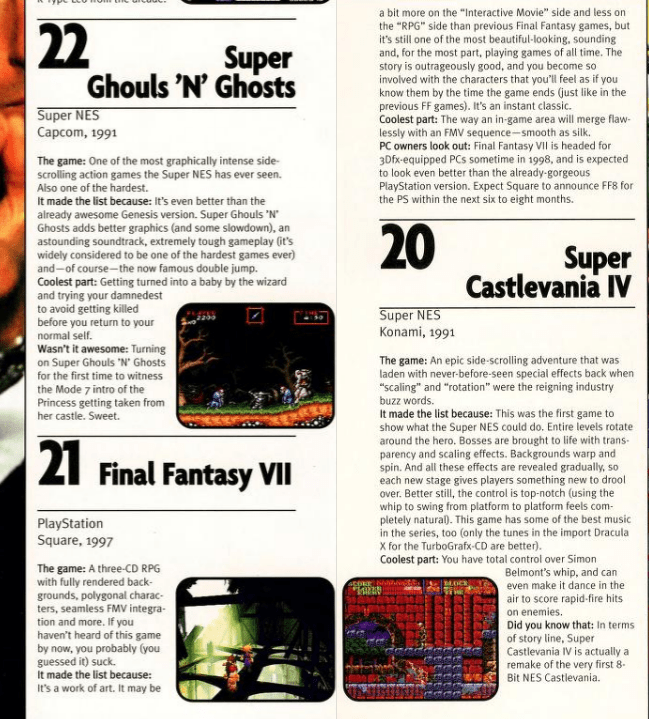
In that same best of ranking, surrounded by list staples like Super Mario Bros. 3 and Tetris, was Final Fantasy III (VI). This was a game I could play because I did have a Super Nintendo. It was also ranked higher than Final Fantasy VII, a game that was taking the general public by storm at the time. So in order to get that fix, I decided to play my first Final Fantasy title. Final Fantasy III (VI). Everything about it absolutely captivated me – it reminded me so much of Super Mario RPG and Chrono Trigger.
At that moment, a Final Fantasy fan was born. My love of JRPGs had become cemented.
Did I finish the game? Well, I don’t know. I have completed it several times since renting it in 1997, but all I remember about my initial playthrough of the game was getting stuck during the boss fight where you have to insert blitz commands for Sabin. I then loaded a save from the previous player that was in Vector and I got a kick out of seeing a minecart sequence. When I got to that very spot in this playthrough, a wave of nostalgia hit me. “Oh yeah! Lightning fries these guys!”

Standardization
For everyone else, Final Fantasy VI released in 1994. Japan got it in April of that year while North America received it in October. The North American version was dubbed Final Fantasy III since this was the third mainline Final Fantasy title to be released over here. This is the last Final Fantasy title to be released stateside with the weird numbering scheme as Square caught everybody up to date with Final Fantasy VII.
No more mainline titles are skipped again, and for the most part the North American versions of these games release pretty close to the Japanese release. XV and XVI both launched simultaneously worldwide even!
Final Fantasy VI feels like a departure from series norms in several ways. This is the first title of the franchise that does not feature Hironobu Sakaguchi as the director as he had been promoted to Executive Vice President of SquareSoft and no longer had the time needed to dedicate himself fully to a title. Instead, Yoshinori Kitase and Hiroyuki Ito stepped in as co-directors.

Narratively speaking
Kitase is the director credited with the event planning of the game. Up until now, crystals had been a driving force for the plot of these games. Usually what gets our heroes up and running is that an evil force is trying to harness their power in some nefarious way and it is up to the warriors of light to put a stop to it. Crystals aren’t mentioned at all in Final Fantasy VI.
The world the story takes place in also veers away from the more traditional looking fantasy worlds we have seen so far. Yes, there are still several kings and kingdoms to keep track of, but the presentation of it feels more modern, like the far-flung future of those older titles. The very first city you encounter in the game, Narshe, very clearly takes inspiration from the steampunk aesthetic and looks nothing like any location we have seen in the series yet.
These little touches make the cities you visit feel more memorable to me. I’ll be honest, I don’t remember a lot of city names from the early Final Fantasy games. Stuff like “Mysidia” that pops up fairly often gets stuck in my head but a lot of those towns just run together. Here, there are several places that are memorable and I still recall years later. There’s obviously Narshe, but it’s impossible to forget the rainy city of Zozo. It’s an absolutely abhorrent and dirty place where everybody is a criminal and it rains all the time. It’s also more visually striking than anything we’ve seen so far.
What about Figaro Castle? We’ve seen several castles in this franchise – you can’t escape one of these games without some royal joining your ranks in order to topple some emperor. By simply being able to move through the desert, this location feels more interesting than any castle location I’ve been to yet. There’s always a Cid to do your airship building and stuff like that, but it feels like every Cid in the franchise came together to help construct certain areas of this game.
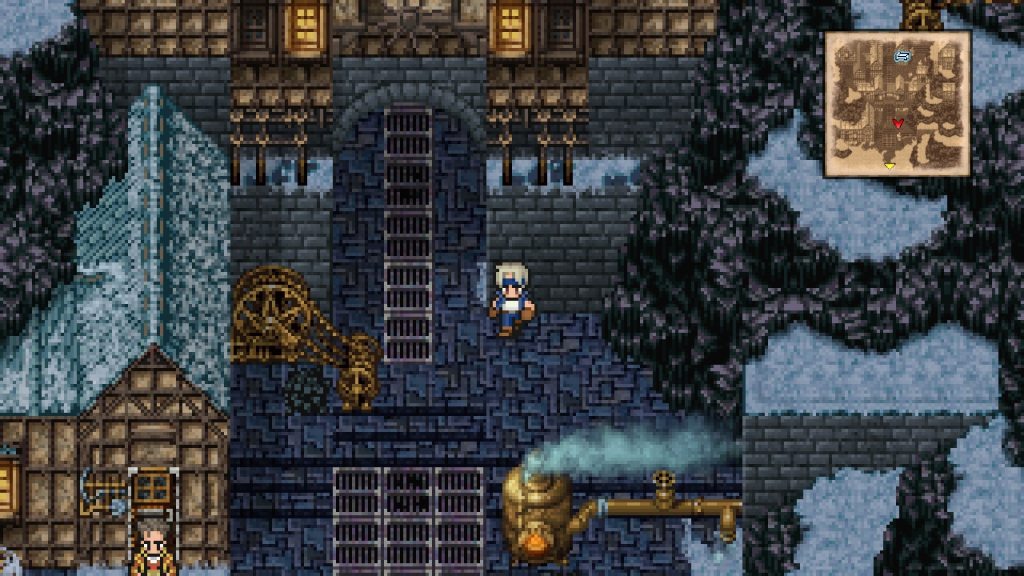

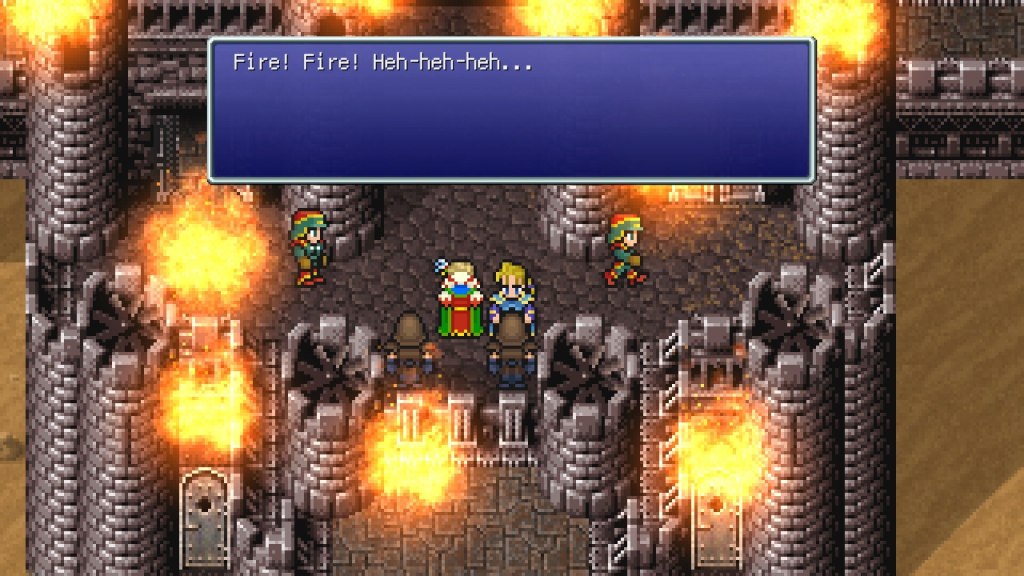
Heck, you could even say that these fantastical elements can help even more standard towns stand out. I’m not going to sit here and tell you Jidoor or South Figaro are legendary JRPG cities or anything like that, but Thamasa sticks out to me. The gimmick of this world is that magic is mostly extinct, but this small little town with normal buildings and no technology stands apart because those people utilize magic. By being a series-standard location, it sticks out.
While I’m talking about cities, let’s look at the world as a whole. Here is what adventurin’ around the world map looked like in Final Fantasy V
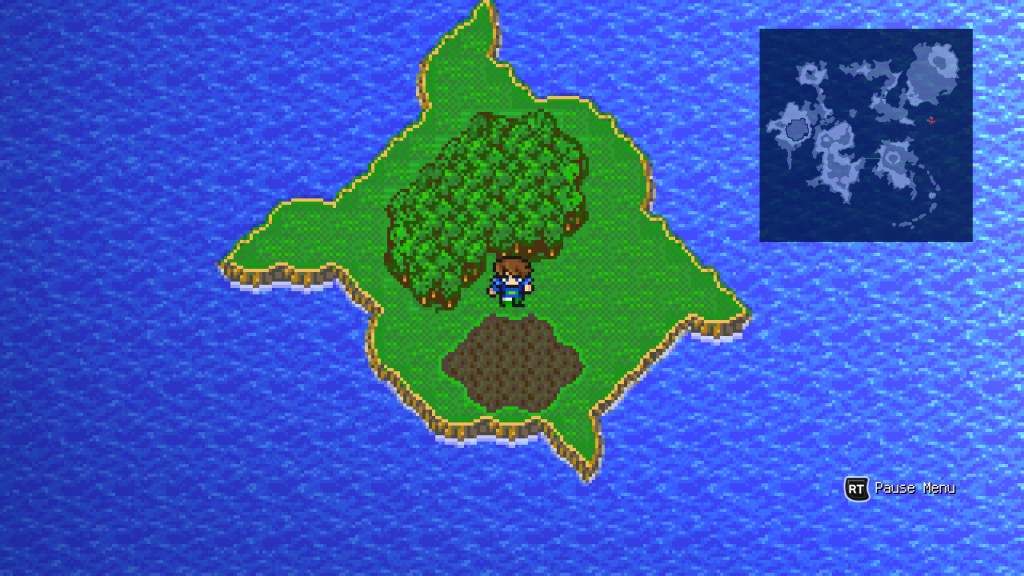
Now, here is what it looks like in VI.
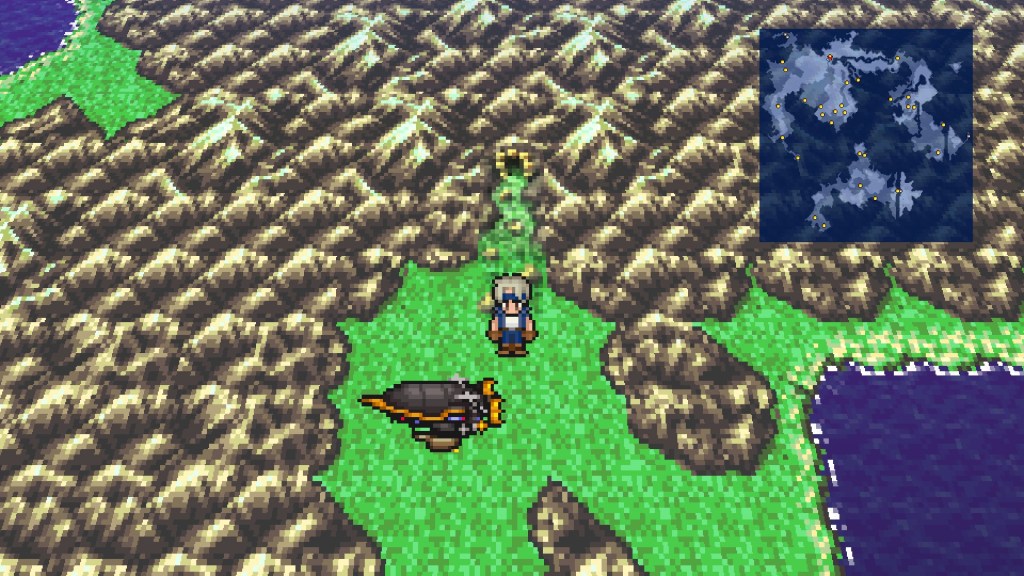
Notice anything? The older Final Fantasy titles used something of a chibi character style to represent moving around the overworld while VI ditches the differences and just uses the battle sprites everywhere. It makes everything feel more connected. It’s a very slight change but to me it made the world feel much more massive than what was in IV or V. And those games had more world maps than VI does!
The game also makes use of the fabled SNES technology known as “Mode 7.” This involves little weird QTEs in the water or the rail sequence I mentioned above in Vector, but it also does a little work when you’re riding in an airship or on a chocobo. The world map warps a little bit and it looks like you’re moving along a sphere, which helps make mounted traversal feel different and the world feel even more massive.
It’s a little touch, but you definitely notice it when you’ve got your hands on a controller.
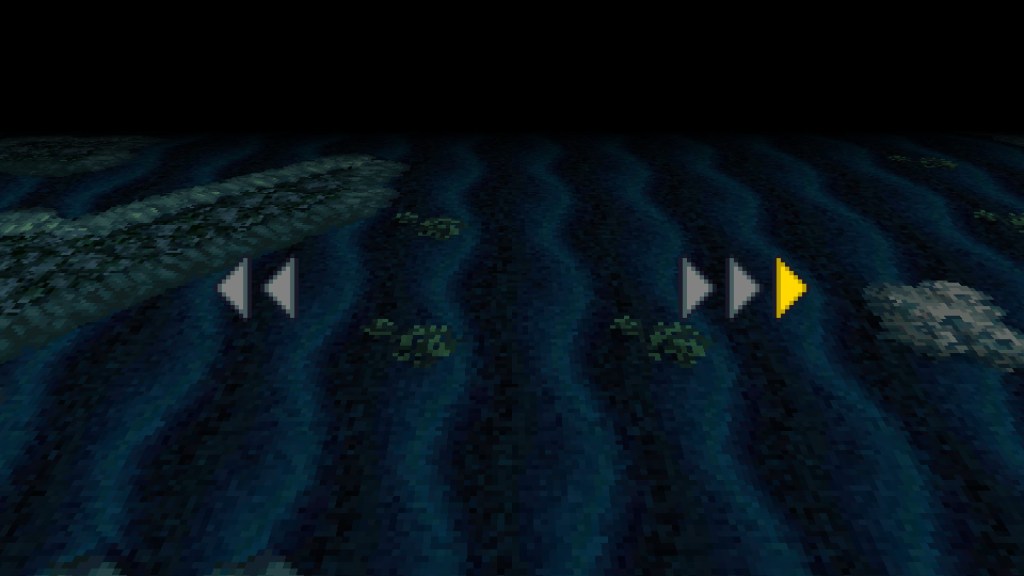
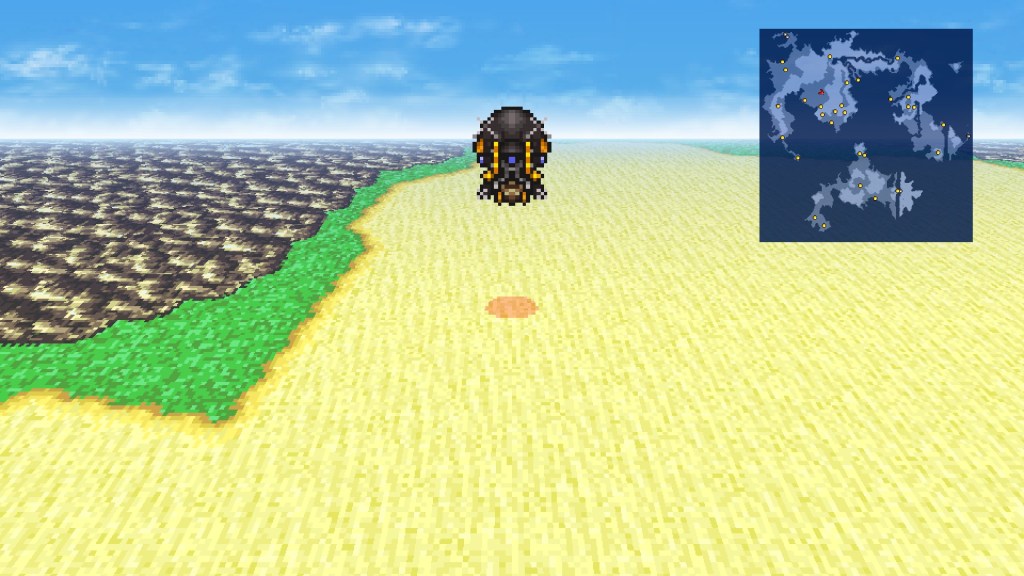
O Maria…
A heavier focus on locales isn’t just limited to the towns and the overworld. Probably the most well known sequence in this game is the opera scene. For years, this was a part of the game that critics crowed about as something revolutionary and as a child, I simply didn’t get. It’s just a cute little scene where one of the game’s main characters, Celes, takes on the leading role of an opera because there is a threat against the lead actress. Right?
Wrong. Everything about this sequence is masterfully done. You are attempting to put a stop to a villain while this opera plays out around you and when you’re playing through it with modern eyes, you can’t help but spot similarities to big set piece segments in video games today.
This segment feels like the 1994 version of the train scene at the beginning of Uncharted 2. You even can play a part in the opera by memorizing lines – from a gameplay perspective it’s not going to blow your socks off, but when you combine the feeling of the game with what you are seeing and hearing it propels things to another level. It’s a scene that is only possible in this medium.



The SNES take on this must be seen to be believed. It feels like the console is singing to you. They worked some real sorcery on that machine’s sound chip to make it come across this way. It’s a bummer that in the Pixel Remaster, they replaced the original audio with a fully voiced singing segment and touched up the presentation. Part of the magic of this scene is what they were able to do on ancient technology and bringing it up to modern sensibilities makes it lose some of what was special about it.
You can just copy and paste a vocal track into an SNES game in 2024. It doesn’t feel like a big deal because console technology is way, way beyond that at this point. But feeling like your console was talking to you in the early 90s was a magical feeling. For lack of a better word, it felt like wizardry.
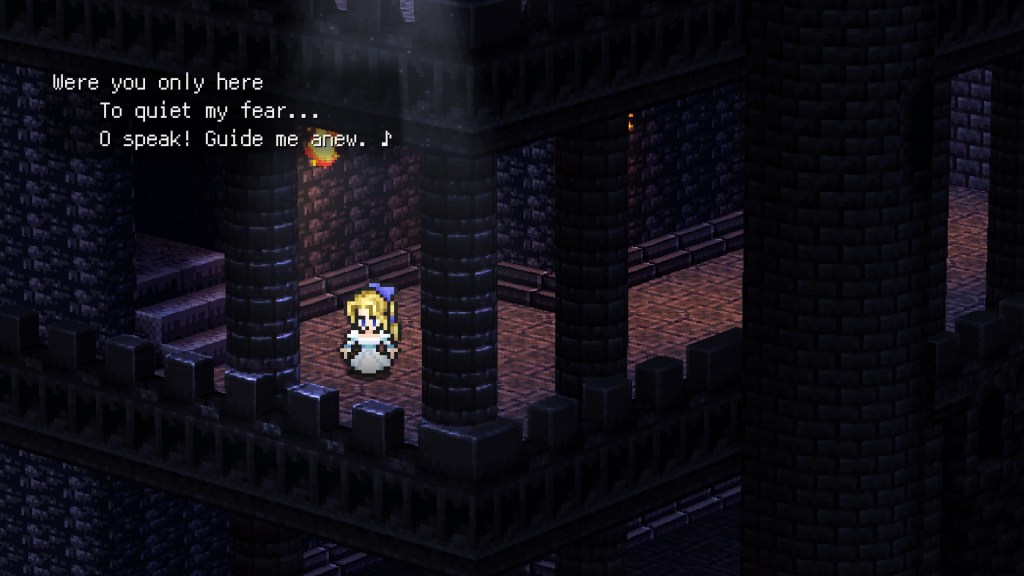
Building some character
In the more storyline heavy iterations so far, II and IV specifically, the plot moves forward because of what the main character does. There is no question about who the lead in Final Fantasy IV. It’s Cecil Harvey. The game is about how he casts off the armor of the dark knight to embrace the light of a paladin. Also the moon is there or some shit. Basically the only main character in Final Fantasy II that had a personality was Firion.
In the first non Sakaguchi led game, Kitase elected for an approach that saw no true main character.
“We began work on Final Fantasy 6 with the idea that every character is the protagonist of the story,” Kitase said in an interview with Edge magazine. “Everyone on the team contributed ideas for characters into a melting pot. We were very keen to design a game featuring individual episodes for each character.”
This doesn’t feel immediately obvious because if you’re approaching VI blind, you’re probably going to think Terra is the main character. Or since female JRPG leads weren’t as in vogue back in the 90s, you might even think Locke is the main character since he is the first important male character you meet during your travels. This philosophy only becomes apparent when the game splits your party into three groups about two hours in.

You can tackle these three scenarios in any order you would like to. None is presented as more important than the other, you just have a Mog out here to tell you what the basic goal of each character is. Reassemble in Narshe! If you haven’t played the game before, you probably would assume the Terra-led group would have the most involved story. No, it actually takes like 30 minutes. What about Locke’s? Similarly short. Instead the most narratively intensive part of this story takes place with the third party, which is led by Sabin.
To this point in the story, Sabin is a very clear secondary character. He is simply tagging along after being reunited with his brother, Edgar, who is king of a place called Figaro. Yet in Sabin’s scenario you learn the most about the main antagonist of the game, Kefka, and all the stuff the empire is up to.
I think the decision to make his scenario the most involved really helped get their point across that this is an ensemble cast and not one where a single character runs everything.

I’ll always remember that choose your party screen, because the first time I played VI, I just had no interest in seeing Sabin’s story. I wanted to see what Locke and Terra were up to. Yet after I got control of everybody in Narshe, that was the one that stuck out the most in my mind. It’s good stuff.
The ensemble cast nature of this game truly comes into play in the second act. The first part of this game is fairly straightforward and in an overall narrative standpoint, it feels similar to the progression you got to experience in IV. Then halfway through the game, the world suffers an apocalyptic event. Everything gets turned on its head completely. The ‘overarching’ narrative is essentially complete at this point – Kefka bad, go kill him – and instead the narrative shifts to individual character stories in this new world.
I will be using official terminology when talking about the two different states of the planet. The first part of the game is the World of Balance while the second part of the game is the World of Ruin.
Ruined

You start the World of Ruin as Celes, a former general from the empire. She is alone on a remote island and everything is a wreck. You have no idea where your party is and the only other character here is a guy the player probably knows very little about outside of his name and profession: Cid.
Cid immediately mentions how there were other people on this island but they killed themselves due to the hopelessness of their situation. Cid doesn’t even know if there’s any more to the world – it’s just he and Celes at this point.
What follows is an excellent bit of gameplay feeding into the story. If you venture out of Cid’s little house and fight in some random battles, you’ll notice every bad guy in the immediate area has a status effect that saps their HP. They often die before Celes can even act. This is a desolate and remote place where life goes to end and that includes the random monsters you fight.
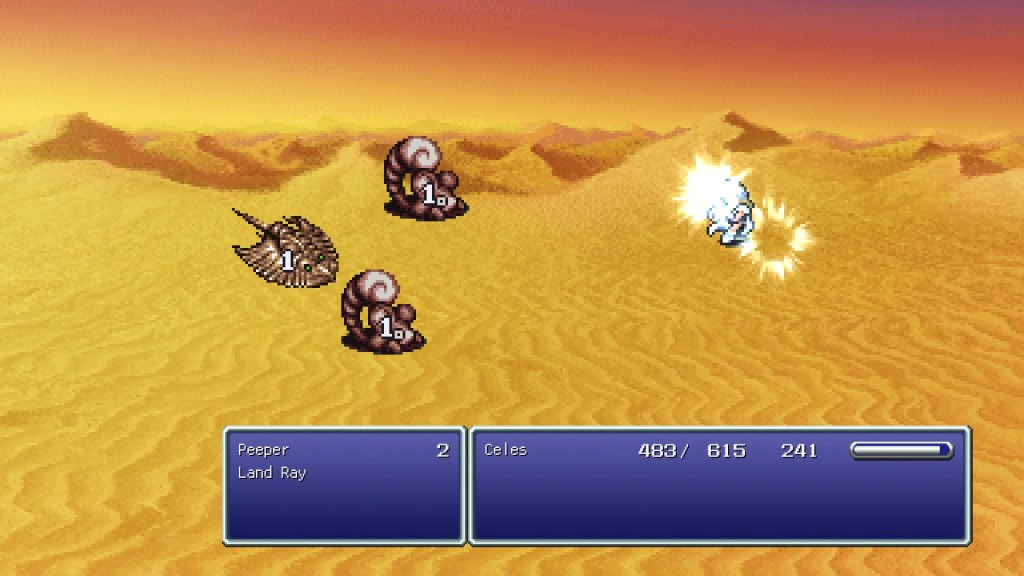
Your lone companion falls ill and you’re tasked with feeding him the only edible thing on the island, fish. A sharp player will note the state of the area and the world and see some fish move faster than others. If you want Cid to recover, capture fast fish because they are healthy and haven’t yet surrendered to this dying world.
If you’re a first time player – or you’re an asshole I guess – you might accidentally give Cid slow fish, which will kill him. Your actions result in the life or death of a fairly inconsequential character and it’s done in a way that isn’t just ‘pull the trigger or don’t.’ It’s very immersive and helps feed into the story of the struggles of Celes in the new world.
The end of this sees Celes get off the island via raft. If Cid dies, there will be a scene where your temporary leading lady jumps off of a cliff – just like the people before her – because she feels that she is alone in this world. Nothing even remotely close to this from a story telling perspective has appeared in the franchise and the first time you see it, it’s pretty jarring.


Starting with Celes instead of Terra, who many would have considered the lead up to this point, for this portion of the game was no accident.
“There’s no central main character in FF6—all 12 of them are equally the ‘main character,’ so starting with Celes then just made sense in the overall flow of the story.” the staff of the game told Game-On and Hippon Super magazines as translated by shmuplations.com. “We were concerned that if we started it with Terra, it would place too much relative importance on her story. Also, we wanted to give Terra some extra backstory, and show what she had been up to since the world had been destroyed.”
We tell stories here, pal
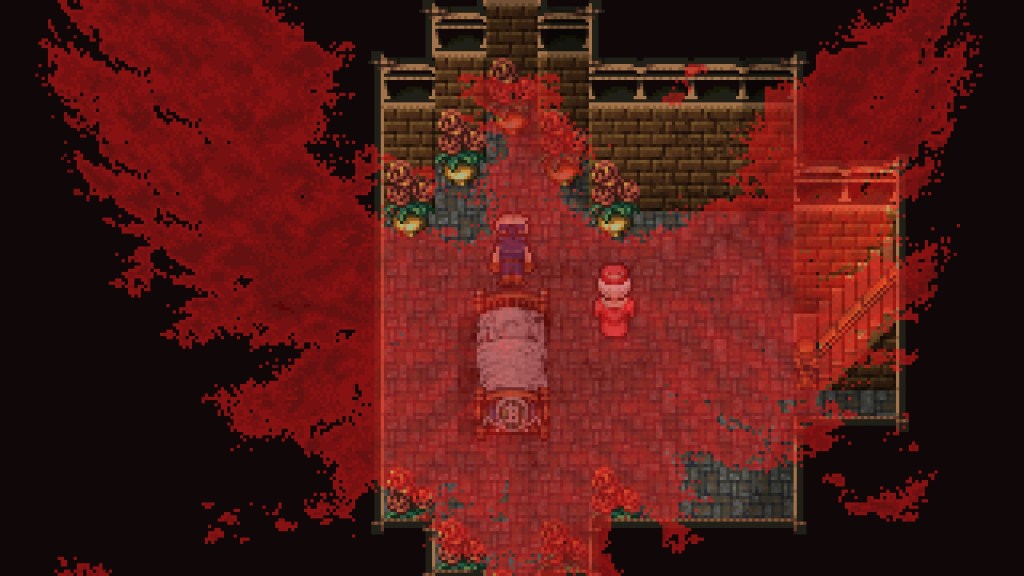
The World of Ruin sees you engaging in various little scenarios like that. Nothing that advances the main plot but instead furthers the individual characters. Sure, some of the little stories told here are insignificant – Gau hilariously is recruited in the exact same way in both worlds – but your average party member in this game has more effort put into their characterization than the main characters from the first few games.
The shift to characterization heavy stories would continue, probably most famously in Final Fantasy VII with Cloud’s disc-2 mental breakdown. I’m not saying the story told in Final Fantasy IV was bad, but VI is where the franchise started churning out tales with a little more meat on their bones.
The player is then tasked with exploring the World of Ruin. There are only three mandatory characters that you need to bring back to your crew in order to finish the fight – Celes, Edgar and Setzer – but the rest are optional. Now, granted, it’s not very easy to finish the game with just three characters because the final boss is brutally difficult, but it can be done.
In this way, it feels like you are crafting your own unique story. You want to make some headcanon where Locke got killed at the end of the world and the crew is fighting on in his memory? You can! It’s your game, go out there and play it how you want. The unique feeling characters of V got replaced with unique end game scenarios in VI.
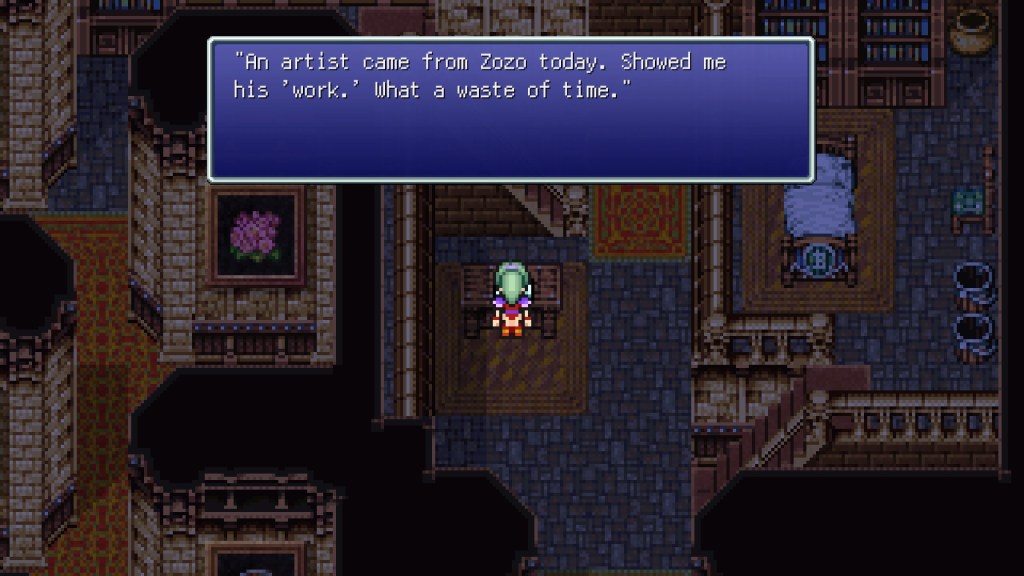
The whole World of Ruin segment feels like a super-charged version of the ending of V. If you don’t remember, Final Fantasy V opened things up at its conclusion to give players the option of tackling the end game or doing some side content to help give you an edge. The story kind of nudges you to do this side stuff, you are tempted with mysterious sealed weapons after all, but it’s optional. You can just roll up to Exdeath if you feel like it.
VI just turns half the game into that. Game planner Akiyoshi Oota has said they didn’t use any of the data or systems from FFV while making FFVI but I find it hard to believe they didn’t take heavy inspiration from the ending of that game for the World of Ruin. You’re missing out on a lot of great character moments if you decide to go fight Kefka right away, but it’s your game. Go play it how you want.
Kitase did a fantastic job in making the world feel alive and making the player feel like they had an impact on what’s going on in it.
Shufflin’
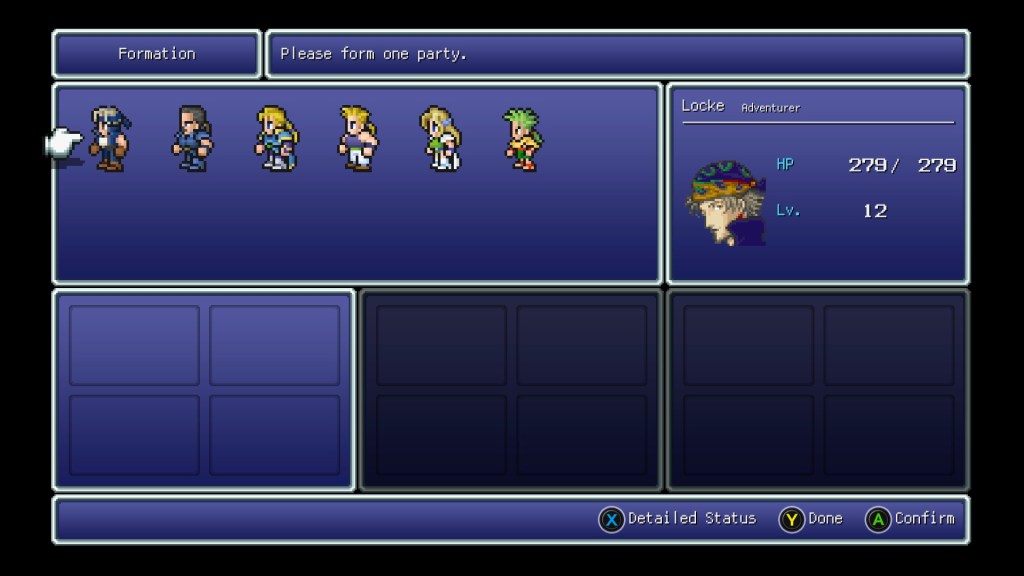
Moving over to the other director, Hiroyuki Ito, the game’s focus on the characters sees some spotlight in the combat as well. For the first time in the franchise, you are able to move members in and out of your team at will.
As shocking as it may seem, until now, you never really had control of who you had rocking in your party. In FF II and IV, characters would leave and come back all the time, but you never had any agency in that. Minwu comes and goes regardless of your input. You’re probably not going to like every party member, so it’s nice you can just bench some of them if you want.
The issue with this is that your out-of-party members don’t gain EXP along with the rest of your party. So if you don’t swap out party members every so often, you’re going to have a serious case of the haves and have nots. For first time players, this is a real pain in the ass because two dungeons in the game really need the player to have multiple characters up to fighting power. You can certainly split up your main party and spread them out, but you’re going in under-powered. This is an ensemble cast and the game expects you to treat it as such.
The final dungeon in particular is going to be a problem if you don’t have several party members with high level magic. In it, you split your party up into three teams – this is why there are only three mandatory characters, so you’d send each of them solo if you tried to finish the game like this – and each party has to deal with its own bosses and random encounters. You can make one party slightly easier by equipping Mog with a charm that turns off random battles, but that’s all you can do. And you still have bosses.

The final boss also is a heavy hitter. Since this game’s schtick is its large ensemble cast, the encounter uses a gimmick where you can bring characters into the confrontation as well. Usually if someone dies, they’ll be replaced by a different party member if they stay down too long. The boss hits hard and has tens of thousands of HP – if you’re a first time player and you only have a couple of strong characters this probably won’t go well for you.
Your party number is still at 4, we will never return to the five man crews of FFIV sadly, and the ATB system is still how you handle your basic combat. The ATB is noticeably slower than it is in past titles, I think the speed in VI at its highest setting is roughly equivalent to the default ATB speed in V.
The reason for this is that your meters don’t pause during actions anymore so they had to slow it down to keep the balance in check. If you are an annoying asshole who has to watchpot everything (like me) it’s extremely hard to deal with at first but it’s not actually any slower in execution. It’s just an adjustment.
It’s magic
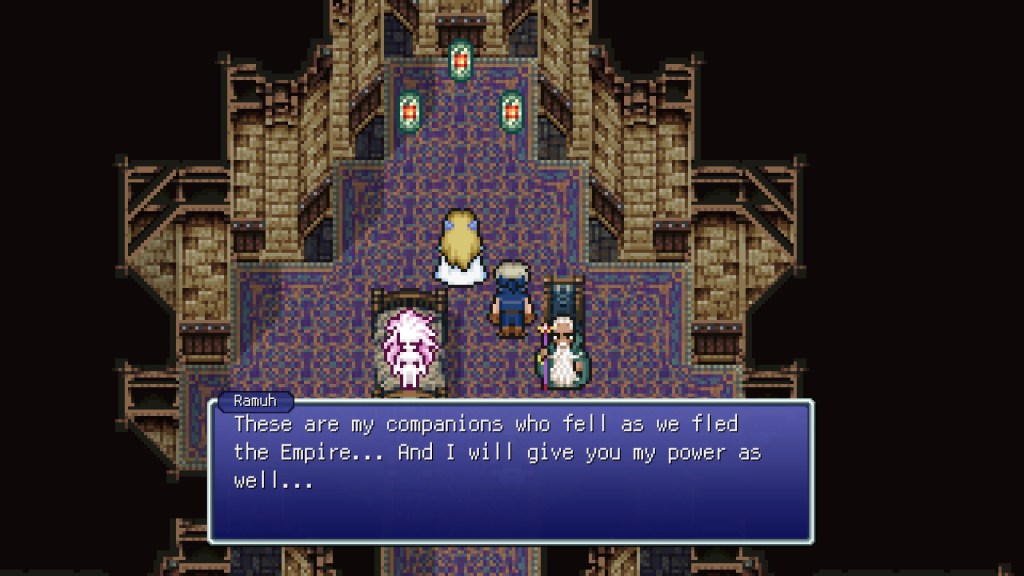
The main combat gimmick this go around is the Magicite system. This is a world without magic but by equipping the, uh, remains of magical creatures known as Espers (more on this later), your characters can learn magic. Having a group that can accomplish a lot of things is important, but I usually just find myself making all of my characters learn all of the useful spells. It makes everybody feel kind of samey.
Sure, the stats are different, but most of the characters I use have access to the same spells. It’s a bit of a step down from V where individual character customization was high.
Now granted, there is still some individuality there. The job system is gone but each character gets a unique action. They vary greatly in utility, but it does make your cast feel slightly different. I’ll get more into unique abilities later but outside of the early game I didn’t find a lot of these useful. The only characters who saw their unique skills consistently used were Sabin, Locke and Shadow. Of course, I’m boring as shit, so I’m sure someone can get in there and have a lot of fun with these abilities. But for an average player? Eh.
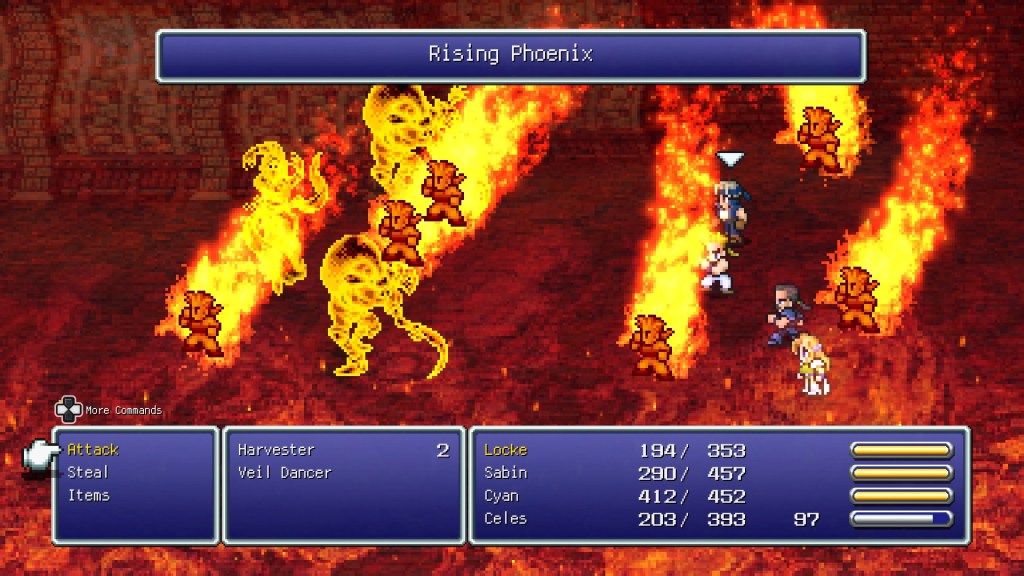
The Magicite also gives you stat boosts on level ups. These are usually things like Strength +1, Magic +1, stuff like that. The average player doesn’t need to worry about that but if you’re very interested in min/maxing, you can make an army where Shadow can out-magic Terra. The best stat increasing stuff comes in the World of Ruin, so make sure you got high level Magicite handy in case you want to do some end game grinding.
You can summon Espers with Magicite, too. As I said last time, summons are now a franchise staple and they figure heavily into the plot of this game. However, when it comes to actual summon spells, I barely used any. In fact, I used two all game. I used Catoblepas to capture a screenshot specifically of a summon and I also used Seraph because I needed a quick heal and wanted to see what it could do. That’s it. I think because you have to click an extra button to get to the summon menu – you press up while at the top of your spell list. It’s out of sight, out of mind.

I wish I could say this experience was exclusive to this playthrough, but I don’t remember ever using summons too often. It’s a bit of a departure from IV and V where I found them to be pretty useful. Well don’t worry summon bros, VII has the best one in the franchise so we will have our day in the sun.
Unfortunately, the way VI plays feels like a step down from V. VI is going to hit you exceptionally hard the first time you interact with it, but you can’t experience a story again for the first time. You’re never going to be shocked about the World of Ruin again. The game plays really well and I still enjoy the ATB system, but V felt like a game you could replay every year and not get tired of it. VI probably needs a couple of years between playthroughs to avoid feeling stale.
Notable characters
This is the final mainline game that uses pixels and as such this will be the final pixel comparison explanation! Hoorah! The order of pictures is thus: Character portrait, pixel remaster front-facing sprite, SNES front-facing sprite, pixel remaster left-facing (battle) sprite and finally SNES left-facing sprite.
The exception for this is Terra, who gets two portraits and her Esper form sprites. I’m not going to comment on pixel differences, but like usual, I prefer the older sprites for the most part. I think the newer ones are too cleaned up and they lose some of the character in the process. It’s most obvious in the hair for me.
Terra Branford

Before I talk about Terra as a character, I briefly want to talk about the character portraits in general. I haven’t mentioned him much because I’ve mostly focused on the actual games, but the guy who does a lot of the official artwork for the Final Fantasy franchise is named Yoshitaka Amano. His art is absolutely beautiful but I feel like its essence is rarely captured in these games. Some of the NES titles in the Pixel Remaster set changed portraits to look slightly more like Amano artwork but it never quite reached that point.
However, Final Fantasy VI character portraits look a lot more like his drawings. I have pulled two examples from both Final Fantasy VI and Final Fantasy IV. The VI portraits (well, outside of Terra’s hair color) look pretty close to Amano’s work, which I think make these some of the best character portraits in the series.
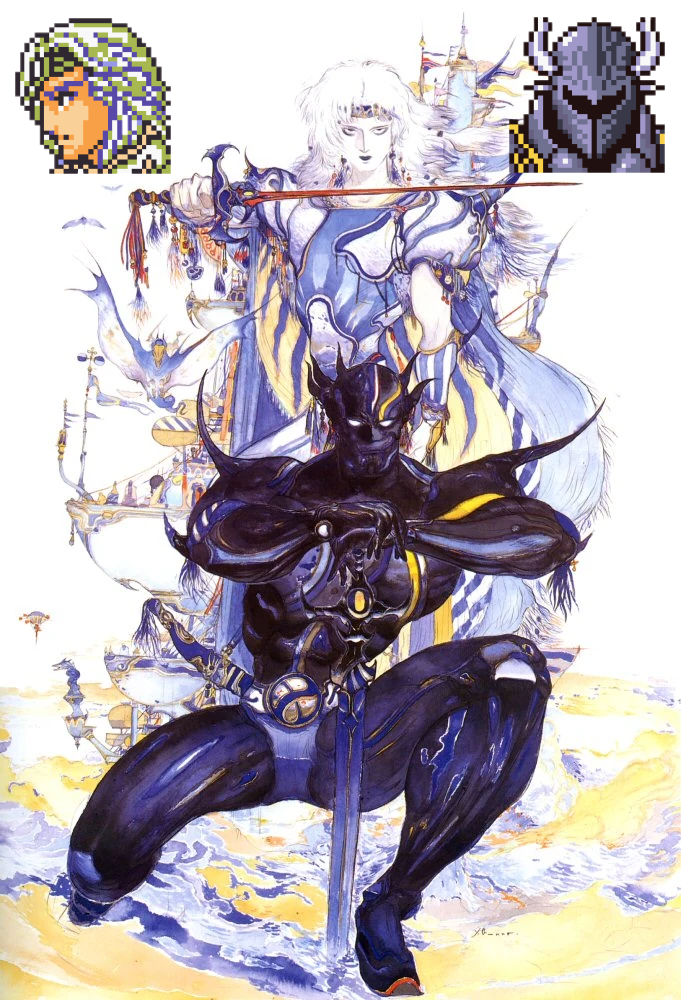


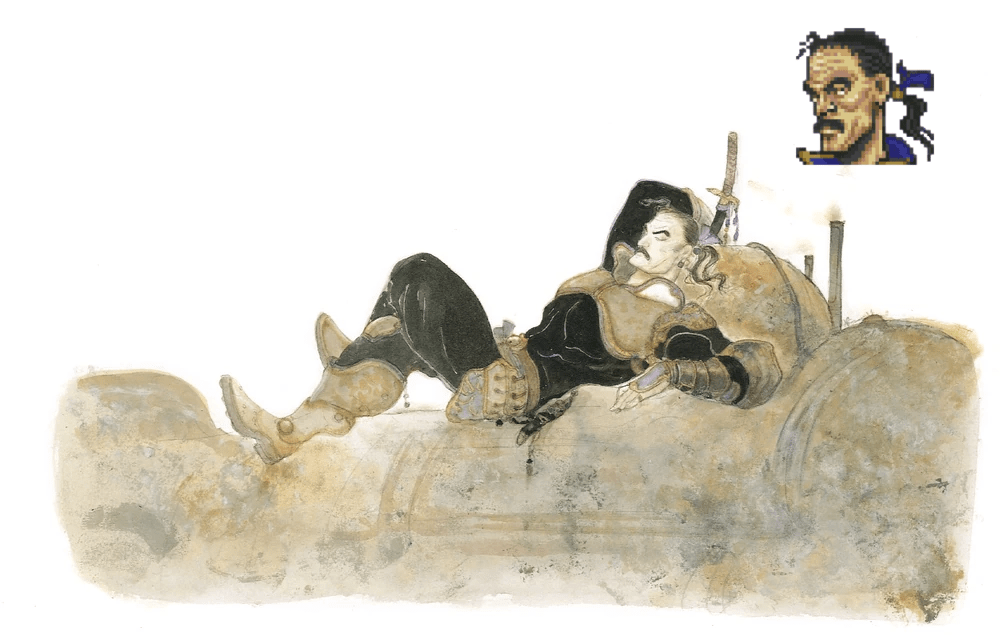
So with that out of the way – Terra is the very first character you meet in the game. You see her and two magitech soldiers named Biggs and Wedge in the iconic opening credits sequence. They are on the lookout for a frozen Esper in Narshe and hope to capture it and return it to the empire.
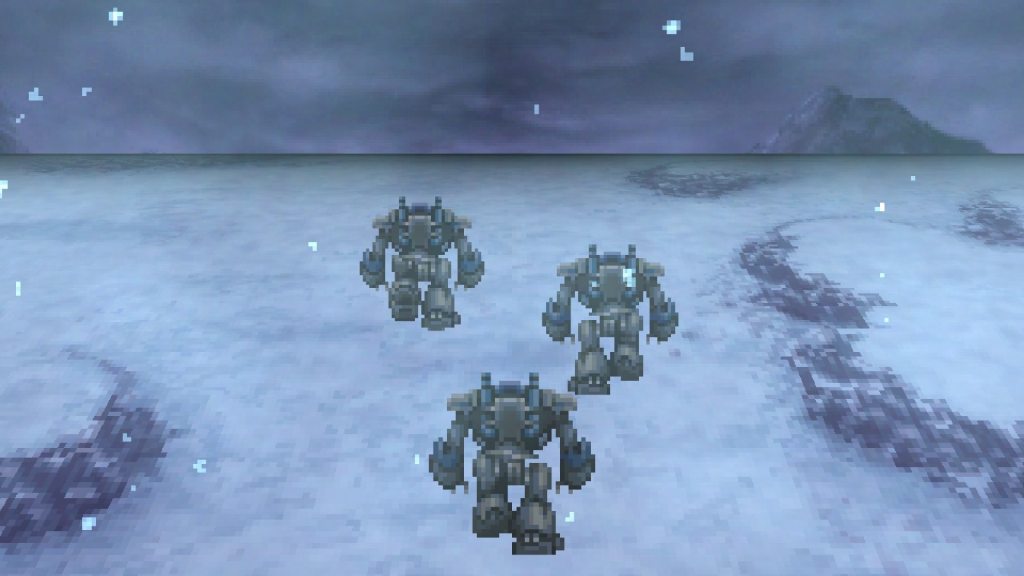
I don’t know about you, but I can hear this image.
You learn that she has been enslaved by the empire with something called a slave crown, which…does pretty much what it sounds like. They have her under control because she can use magic, and in this world, magic users aren’t exactly very common. Terra’s plot in this game deals with her discovering her origins – she is the daughter of a human and a magical being called an Esper – and her learning how to deal with her place in the world.
Her father is an Esper named Maduin, while her mother is named Madeline. The original M&M if you will. They meet because Madeline accidentally waltzes into the world of the Espers. You see, the world of the humans is too full of evil and stuff like that. Most Espers want to kick her out but ol Maduin doesn’t and instead the two have the most artful sex scene in video game history and bring about Terra.


The Espers seal up their home world to prevent the empire from doing empire things but Maduin, Madeline and Terra get spit out of the sanctuary in the process. It’s revealed that Gestahl, the leader of the Gestahlian Empire, discovered her as a baby and had been using her since.
Her main hangup seems to be about love. She wants to know if someone who isn’t exactly human can feel those same emotions. She’s not sure of her place in the world and she has been treated as an ‘other’ type of creature her entire life. Is she even worthy of love?

This purpose seems to be answered in the World of Ruin when Terra finds herself the leader of a small destroyed city of mostly children. They refer to her as mother and she feels a sworn duty to protect them. She’s not exactly sure what the feeling going on inside of her is, but she eventually figures out it’s a type of love. It’s a sweet little story.
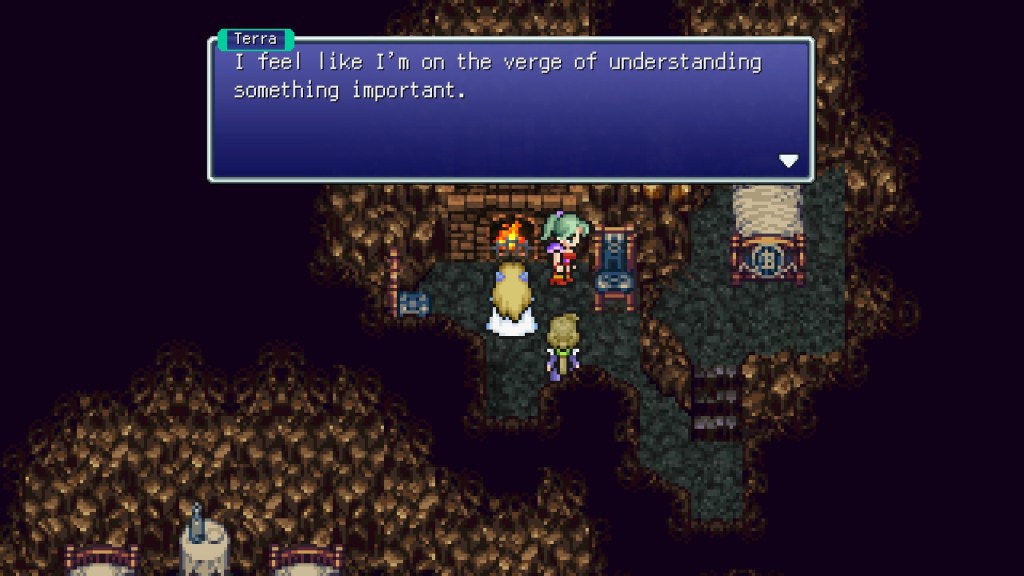
Terra is one of the most interesting characters in the game. There’s a reason why she is the representative for Final Fantasy VI in the Dissidia arena fighters. I think her struggle to feel accepted is a pretty universal one that makes her easy to relate to. Most of her dialogue and story scenes are pretty serious, so she doesn’t come across as a character with much of a sense of humor or even much of a personality. Which is good, since she spent most of her life enslaved by the empire. It’s fitting for somebody who is constantly questioning her identity.
Her discovering her Esper form is a pretty key part to the game. It tells the player that there is more to the world than they have ever realized before. It introduces you to the Magicite system, Espers and all of the evil actions the empire has done behind the scene. You knew they were cruel, but the genocide of a sentient species isn’t something that you were aware of until that point.
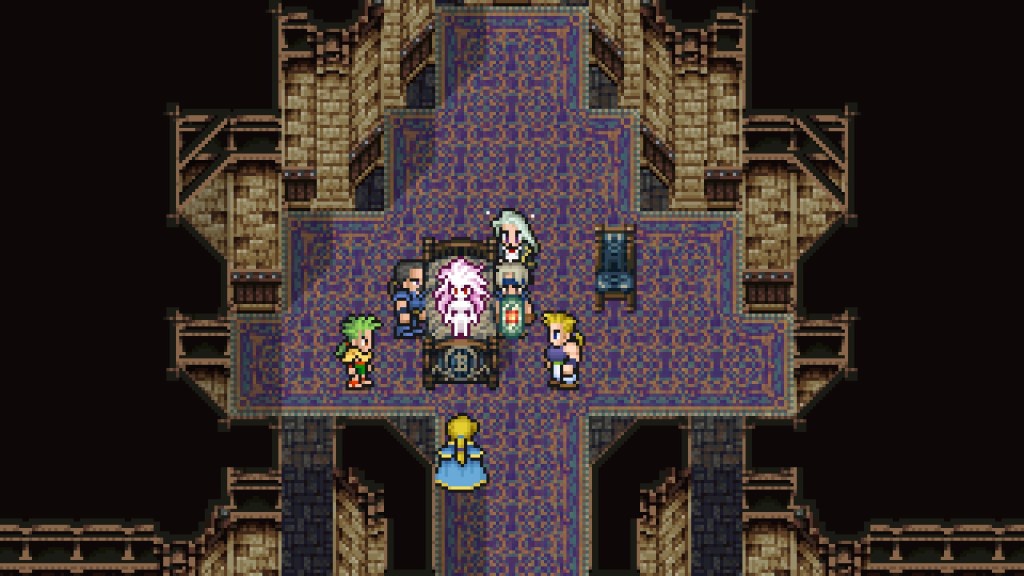
In battle, Terra was pretty typically in my party if she was available. Her magic is exceptionally useful in the early goings and even without using Esper stat modifiers, she continues to excel in magic. Her special ability is trance, which allows her to use her Esper form in combat which further boosts her magic capabilities.
I find the special Esper ATB meter runs out before I get more than a move or two off with trance. And by the end of the game, she was causing max damage without any help so…not a terribly useful skill.
But hey, I will never complain about a character being able to transform in combat. It’s cool!
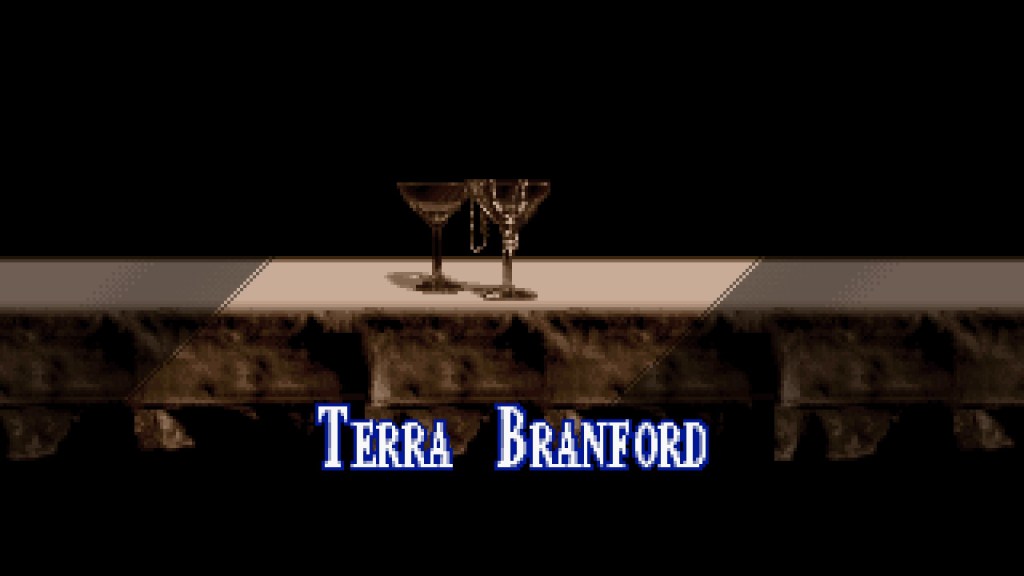
Locke Cole

Locke is introduced to us as a thief but he always makes sure to correct whoever calls him a thief by saying “I’m a treasure hunter!” You’d think after the fifth or so time this pops up in the game that it’d feel old, but I always found it pretty endearing.
Locke starts our story in Narshe where it’s revealed that he’s part of an anti-Empire rebellion group called the Returners. He (and some moogles) discover Terra and are determined to help her get out of the clutches of the empire. Through this, one of Locke’s primary character traits is revealed: he will do basically anything for a woman in need. He’s extremely chivalrous! He proceeds to risk life and limb to get Terra to the kingdom of Figaro and away from the Empire.
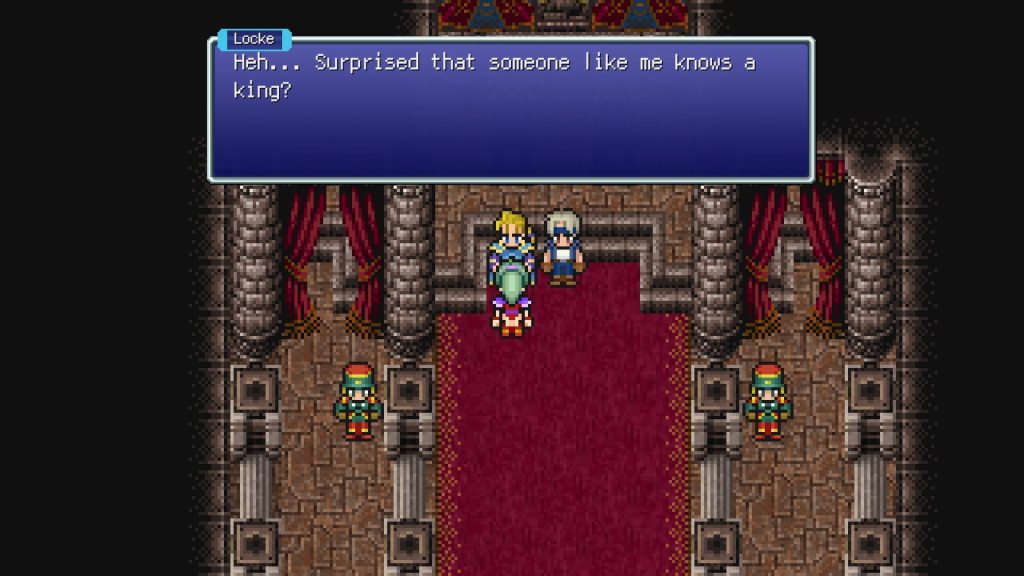
The reason why Locke is so chivalrous isn’t necessarily because it’s in his nature, but because he lost his first love, Rachel. The treasure hunter was journeying with Rachel when a bridge collapsed underneath the two of them. Rachel pushed Locke out of the way when this happened and fell to her death.
Despite this, Locke doesn’t come across as overly dour or depressed, but even early on you can tell something from his past is eating at him. This becomes apparent when he meets Celes for the first time and suggests that she is familiar but doesn’t exactly elaborate on it.
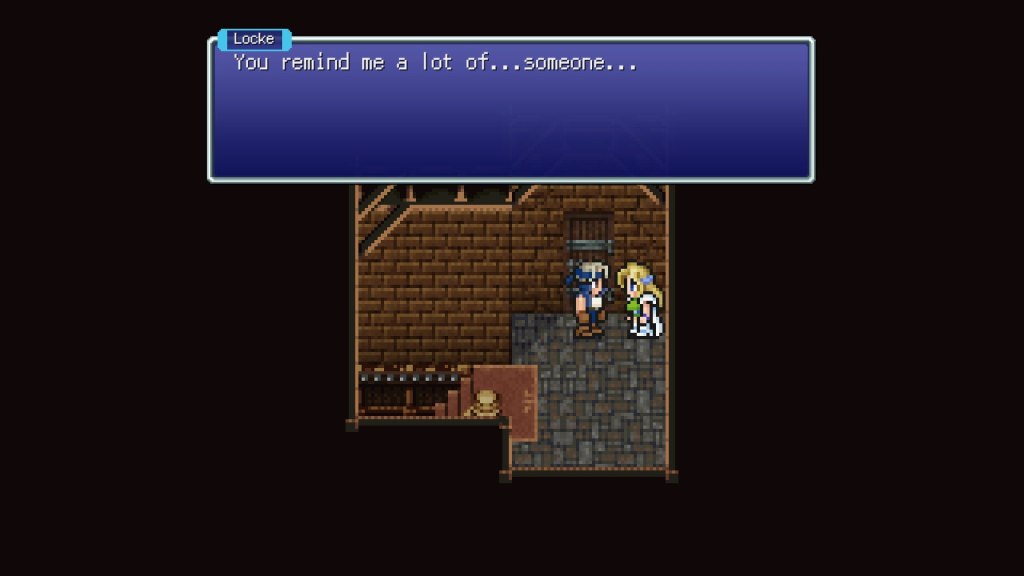
Locke’s story in the game is about letting go of the past. He needs to get over the death of Rachel. His plot in the World of Ruin involves him hunting down the Phoenix Magicite in a desperate attempt to bring her back to life. This is probably the hardest character sidequest in the game as it functions as sort of a miniature version of the final dungeon (Two full parties as opposed to three) and contains some of the hardest encounters you can experience.
I think it’s fitting that a Magicite that is rumored to resurrect the dead is surrounded by such trouble.
When Locke returns with the phoenix Magicite, it’s apparent that it’s damaged beyond repair and won’t be able to do everything Locke wants it to. Don’t you worry though, our hero does get a couple of extra minutes with Rachel before she passes on for good and tells Locke that she is grateful for their time together.

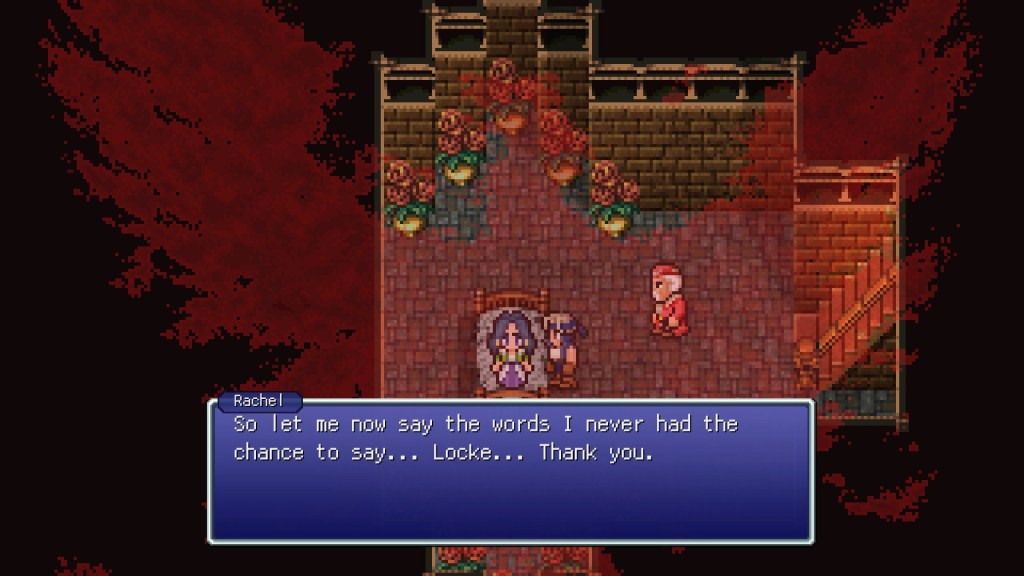
I absolutely adore the phoenix backdrop during this scene. It’s a real simple touch but makes it one of the most memorable moments in the game for me. As an aside, I think it’s real cute that Rachel is the only character who plays along with Locke’s “B-B-But I’m a treasure hunter” schtick.
Locke has always been a personal favorite of mine. I guess I’m just a boring guy, but I find his struggle to get over a lost love to be pretty interesting and I really enjoy every scene he has with Celes. It’s a romantic tension that isn’t overtly talked about very often but the player often wonders about them. There is clearly something going on between the two. I like that the game doesn’t end with them just kissing and declaring their undying love for each other. It’s left up to the player’s imagination.

Or you could just listen to Relm. Your choice.
In combat, Locke’s unique ability makes perfect sense for his role in the story. It’s steal! He’s a thief treasure hunter after all! I found myself stealing a fair amount this go around. I’m really pleased with how improved thievery has gotten since Final Fantasy III. Sure, some enemies do just have potions or hi-potions, but they are not the majority of encounters this go around. You can steal some pretty handy gear and items, so it’s helpful to at least try it every time you see a new monster just to see what you can get.
I typically give him a genji glove, an accessory that lets you equip two weapons at once like the Ninja job of old, and make him my primary physical attacker. Magic totally obliterates physical attacks in usefulness this go around, but that’s okay. Everybody in a party needs their role!
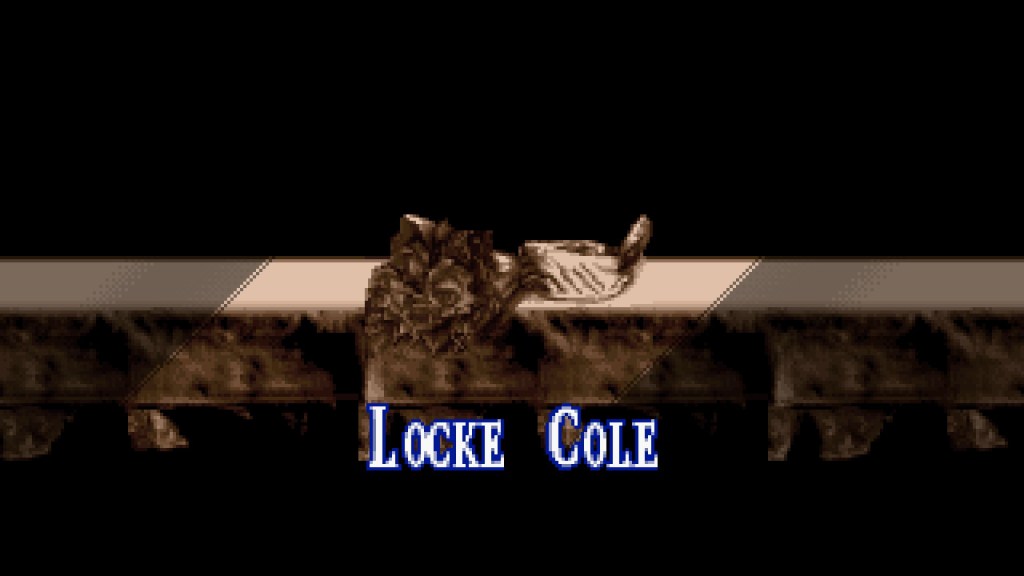
Edgar Roni Figaro

The King of Figaro is a pretty one-dimensional character. He’s a lady’s man! When Locke spirits Terra away from Narshe and the Empire, one of the first things Edgar does is hit on Terra. All of his attendants note how it’s a real problem and how he flirted with a high priestess at some point, which caused some trouble for him and the kingdom. He fits into that skeevy old man archetype. Think a Master Roshi, without being an older character.
It’s revealed that Edgar is a skilled mechanic – the castle he commands has the ability to transport itself to other continents by burrowing underground. He’s also a member of the Returners and has entered a sort of false pact with the Empire in order to keep his Kingdom safe.
The Empire comes knocking on his door for Terra very early on in the game, but Edgar refuses to surrender the woman he just met, which leads to Kefka (in his first appearance in the game) setting fire to the castle and trying to smoke everyone out. And if Edgar refuses to relent? Kefka doesn’t care, they’ll just burn everything to the ground. Quite a mean fella. Luckily our promiscuous king had prepared some escape chocobos for such an occasion.
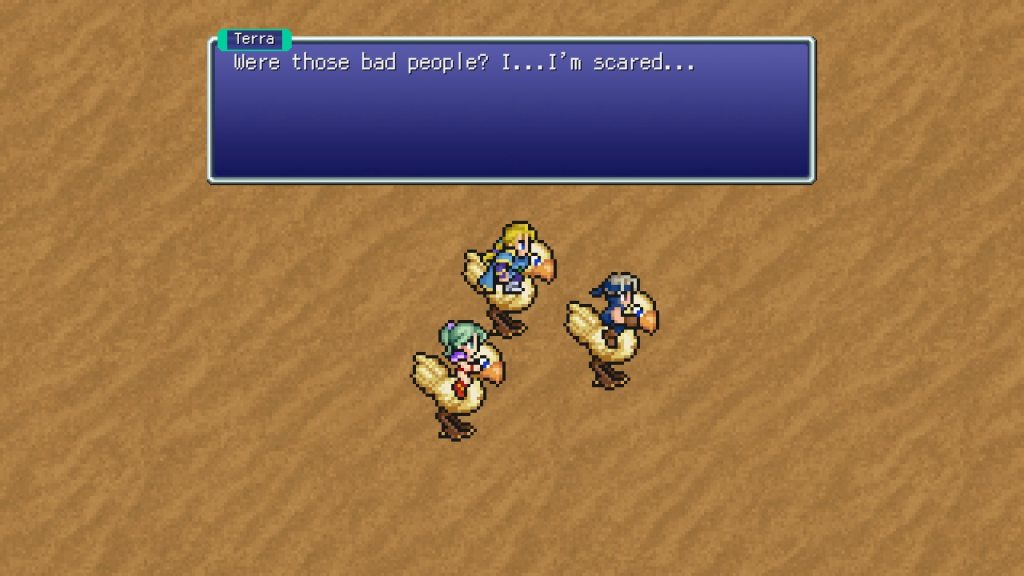
Edgar also gives us a pretty funny reaction to Terra casting magic during this little sequence, which is very nice since Locke is very polite about the whole dark arts thing.


His womanizing nature does come in handy at one point. There is a section of the game where the empire and the Returners form a sort of alliance. The party splits up and one of the people left behind is Edgar. He proceeds to just do what he always does, flirt with every woman around, and finds out about the Empire’s plans to betray the crew after chatting up a serving girl. Why she knew the intricate plans of Emperor Gestahl I have no idea, but it benefits everyone!
Edgar’s main story in the game seems to be digging into his relationship with his brother, Sabin, who went missing years ago. Once you find Sabin almost immediately, I feel like Edgar doesn’t have a lot of character progression and is just there to provide fun dialogue for the rest of your party. His story in the World of Ruin just involves taking a gang of thieves to Figaro Castle in an attempt to reclaim it. He uses an alias to not draw attention to himself – Gared. You might notice that this is an anagram for Edgar. Clever fella, nobody will see through that.
I have never understood why Edgar chooses to hide his identity from Celes when you first discover him in the World of Ruin. You repeatedly accuse him of being Edgar only for him to go “no, you are mistaken. Stop following me.” Okay, so what if Celes had actually stopped following you? What then? Edgar just vanishes and the Kingdom of Figaro is never heard from again? He seems very eager to reveal himself to you at the end of the sidequest…so yeah, I dunno, it’s not my favorite bit of story telling from FFVI.
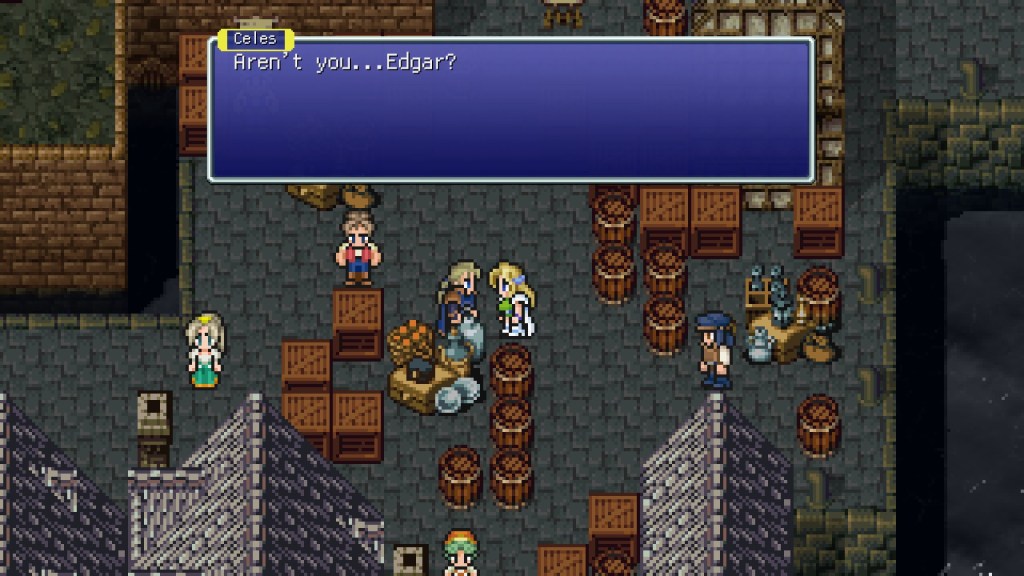
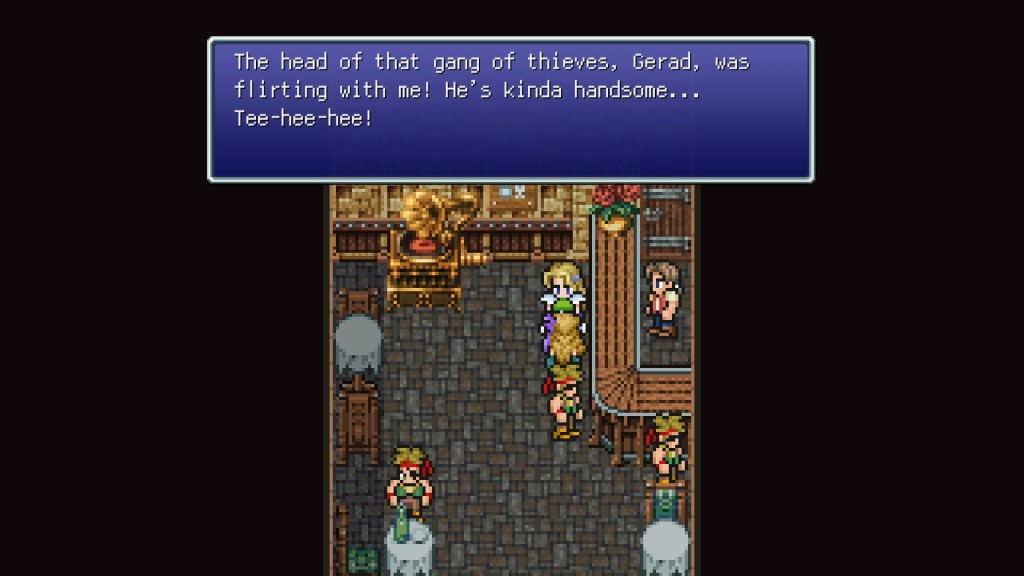
Despite my complaints about how some of his writing is handled, I like Edgar. I think it’s because I have a fondness for the comic relief characters in otherwise ‘serious’ pieces of fiction. My absolute favorite character in Dragon Ball Z is Krillin and I do see a little bit of the Krillster in Edgar here. He’s simple, but that’s okay. FFVI has a lot of complicated characters. I need a break from thinking about motives for a while. Edgar sees a woman and thinks she’s hot, really that’s all ya need sometimes.
In combat, I used Edgar a lot early on because his unique command involves using tools. You see, it’s taking advantage of his mechanical expertise. Using auto crossbow, you have an extremely early way of attacking every enemy on screen – it quickly becomes useless because it doesn’t hit particularly hard, but in the early bits of the game it’s great.
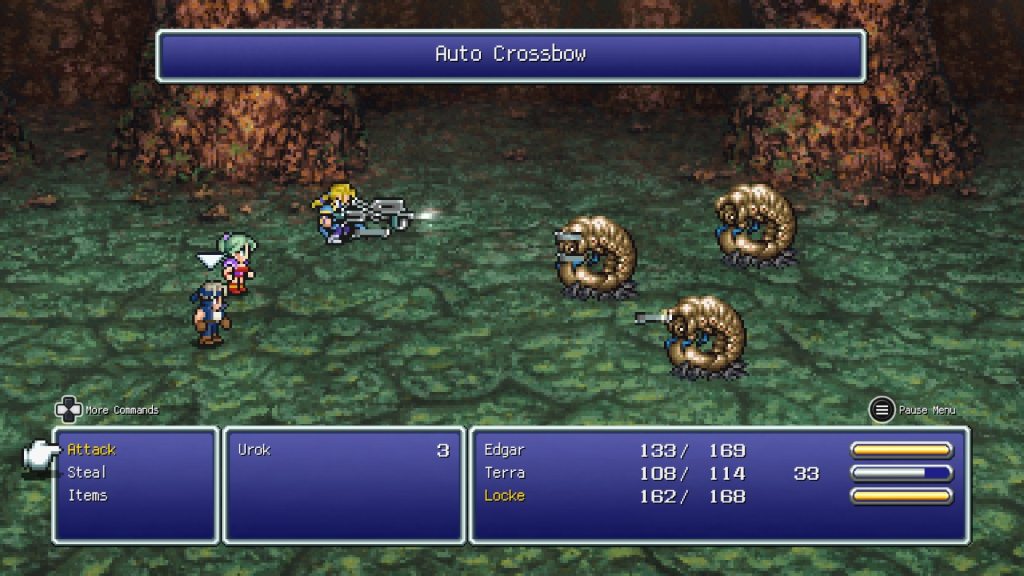
He also gets a chainsaw really early which both hits hard and has a chance to one-shot random enemies. It’s handy stuff! Outside of that, much like Locke, I use Edgar as a physical fighter. He rarely is in my ‘main’ team but he also sees enough use that he’s never particularly underleveled for me. A nice number 5 or 6 option for the final confrontation with Kefka.

Sabin Rene Figaro

Sabin is Edgar’s long lost sibling. He was supposed to be the King of Figaro but instead elected to pursue freedom and martial arts. When you recruit Edgar, you stumble into a little house that Sabin had clearly been using while off training in the mountains, so the party wanders into the mountain with hopes of coming across the martial artist.
At the top of the mountain, you get into a boss fight with Vargas, a man who trained under Sabin’s master Duncan and seemed resentful that Sabin was the master’s favorite. Our musclebound hero swoops in and saves the day using his unique ability, Blitz, in a tutorial battle for the ages. For reference, Blitz is an ability where you can input various commands to pull off several different attacks.

Seriously, when I was a kid, this section was impossible. I don’t know why inputting simple directional commands was so tough because every time I’ve played this section since it’s been a walk in the park. Maybe people really do need that yellow paint you see in modern games?
While I’m talking about Blitzing, the remaster changes the way that technique is handled. In the past, you would have to look up all the Blitz commands in the menu and then memorize them for use in battle. For me this just meant using the same few over and over again.
In the Pixel Remaster, you select your command from the blitz menu and then it will bring up a screen with the input. It is a welcome change, this isn’t a fighter, I’m not trying to memorize 80 different inputs for my characters. Though I guess at this point why even have the player put in the command? Well, whatever, I’m usually against big gameplay altering changes so I can’t complain too much about one I actually welcome.

Sabin comes off as a bit of a simple brute. He doesn’t think too much about things and instead just goes with the flow. He seems to have a strong sense of justice as he joins up with the Returners with relatively few questions asked and also has no issues teaming up with Cyan and helping him after his kingdom collapses.
In his big journey I mentioned above, he comes across as a traditional protagonist to me. He is there to move the story along – stuff happens to him but he doesn’t really contribute much himself. Well, outside of muscle. He is there to push others along. He’s not terribly deep, much like his brother, but he is an enjoyable guy to have along on your adventures.

My personal favorite bit of his is during the phantom train segment of his adventure. The train is filled with ghosts and is used to ferry the dead from the mortal world to the afterlife. There are some serious moments here because your buddy Cyan just witnessed his kingdom get annihilated, but you get to the food cart and instead of questioning why there is a food cart on this train of the damned, he just pigs out without thinking a second about it.
What I love even more is that there are literally no consequences for this behavior. Sabin just munches away and the story progresses. What a guy!

In the World of Ruin, he joins up with Celes when she tries entering a crumbling house to save a child. He single handedly holds up the house while she explores and tries to set things right. See! I told you he was a good guy. You can meet his master later on in this world to learn his best Blitz ability and a funny little exchange occurs. Both Sabin and his master use the same bit of dialogue to explain how they’re still kickin’.


In combat, Sabin’s Blitz was by far the most used unique ability for me. They hit strong for when they pop up in the game and there are even moves he can pull off that hit entire enemy parties for heavy damage. The most famous Blitz example is the oft-memed about suplexing of a train, but it has far more utility than just for simple jokes.
Before you get access to Magicite, Sabin is probably going to be your most useful party member. In most of my playthroughs of VI, Sabin is a frontline party member. I enjoy him and I enjoy using him. The Figaro brothers are alright by me!

Fun fact, there were originally some different plans for Sabin’s character in the World of Ruin: “During the development, for the Tzen (where you recruit Sabin) event in the World of Ruin, originally if the time ran out, Sabin would actually die!” Kaori Tanaka, field graphics and character designer for Final Fantasy VI said in an interview with V-Jump magazine.
“Then if you came back to Tzen with Edgar in your party, it would trigger a scene with Edgar wandering forlornly around Tzen in the middle of the night, searching through the rubble in vain for his brother… “I’m coming… I’m coming to save you! But we decided that the World of Ruin already had more than enough dark stories, and changed it for the final version of the game. For Sabin fans, it’s a good thing we did!”
Probably a good change. Also, Tanaka was the co-creator of Xenogears! If you haven’t played Xenogears, do that right now. It is one of the best video games ever made.
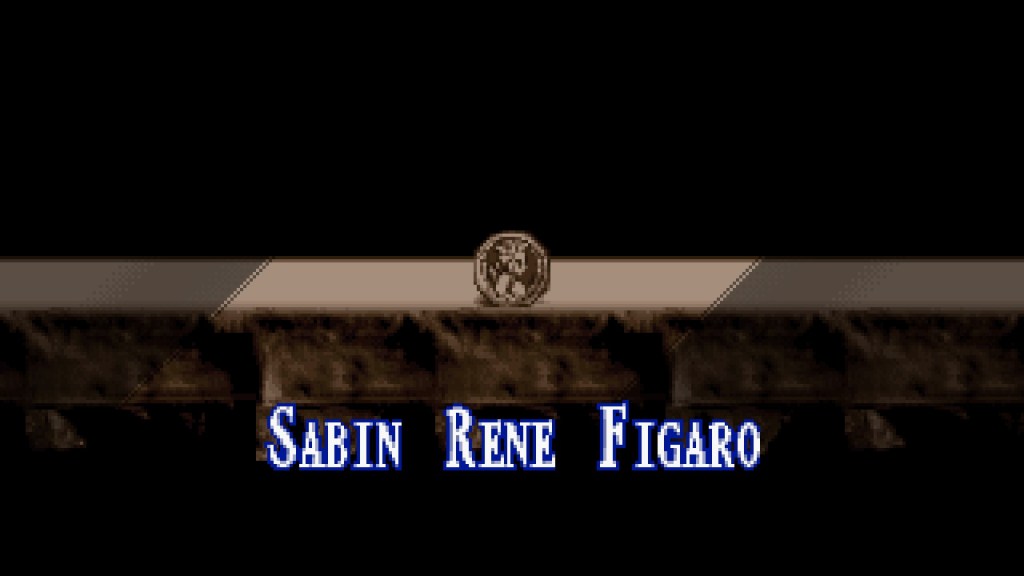
Banon

One of the few temporary party members this go around, Banon is the leader of the Returners. He sees the way the world is going and is fearful that the empire will bring about a second war of the magi (more on that later), which resulted in major losses for humanity.
When Terra is brought to him, he has the unusual tactic of telling her about how she killed a bunch of Imperial soldiers while under the influence of the slave crown. Locke protests that she had no control of herself during this situation, but Banon insists that it isn’t helping anybody to run from the truth.

Despite coming off as harsh, he does take the honesty thing seriously. He is open with Terra about how the Returners hope to use her as a tool in order to bring down the empire. He views her magic as an extremely valuable and does not treat her as ‘an other’ or anything like that.
I’ve never really had much of an opinion on Banon as a character. I didn’t like the section of the game where Banon being knocked out in battle resulted in a game over, but it lasts for like 20 minutes. Since he’s not around your crew for that long, I don’t think as much focus was put into what to do with him. He’s just there to move the plot forward and give the Returners objectives to complete. Hey man, someone has to lead the rebellion. Why not the crazy old guy with wild hair?

Banon’s unique ability is pray, which functions as a full party heal. This is extremely useful early in the game because your crew doesn’t have access to Magicite and the best cure spell you have is just regular cure. Pray heals much better than cure.
The old fella stops appearing about halfway through the game and doesn’t show up at all in the World of Ruin, which makes the player speculate as to what exactly happened to him. I think it’s pretty convenient that everybody in the main cast (well, maybe not, more on that later) survives the end of the world, so I like to think that Banon is the one guy who couldn’t escape Kefka’s wrath. Or, who knows, maybe he’s just chilling in the caves of Narshe with the moogles and nobody was ever able to find him. Whatever story works best for you. It’s your adventure!
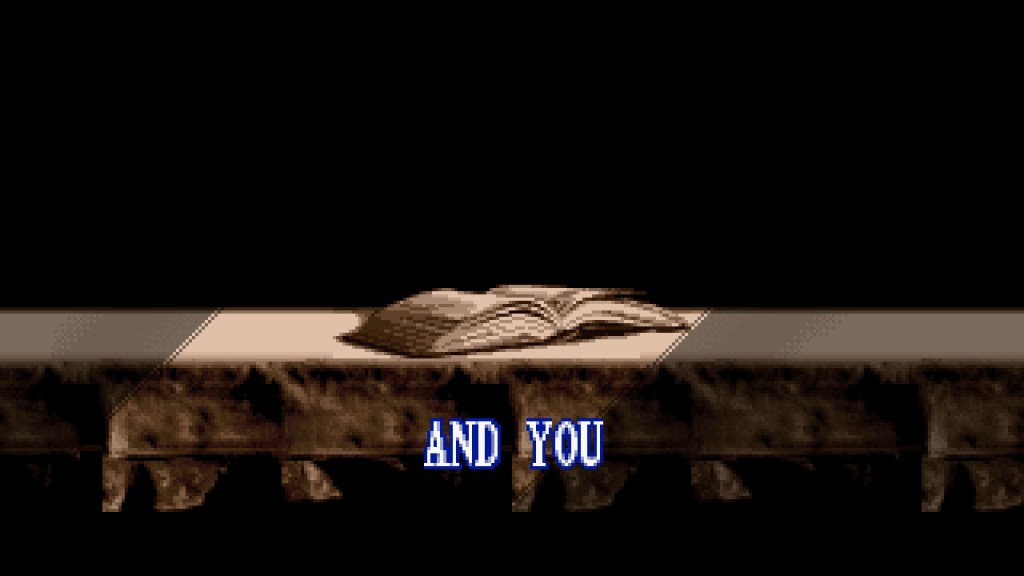
See! You’re part of the cast too!
Celes Chere

Celes is introduced to us fairly early on as an imperial general. She is seen in sepia tone flashbacks talking about the formation of the empire. She was infused with magic at an early age, which means she is the second party member you get who can use the dark arts.
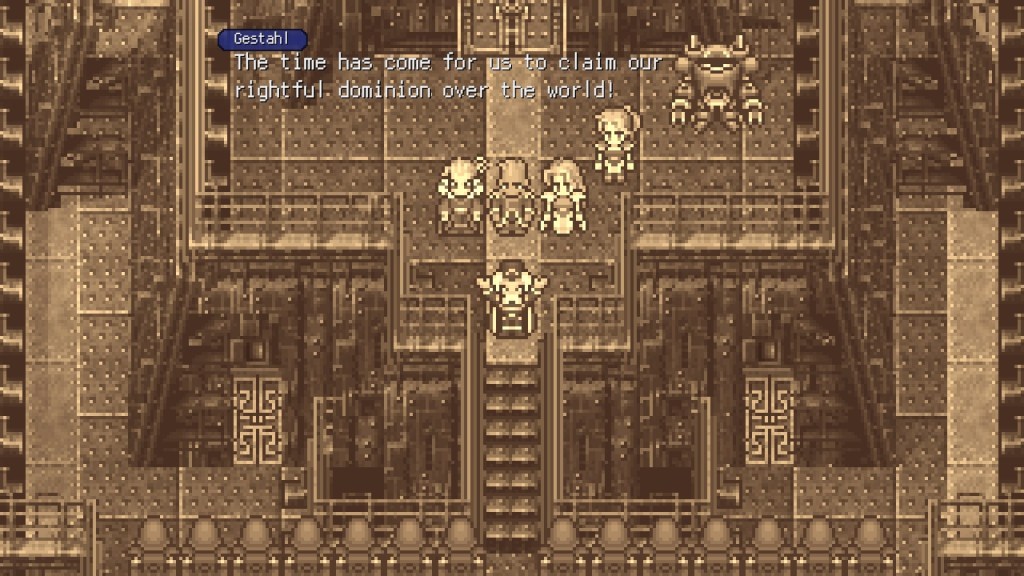
The player never gets to see the evil side of her though, instead the first time your party interacts with her is during the ‘party separation’ segment I mentioned above. When Locke wanders off to South Figaro in order to figure out what the empire is up to, he stumbles into an interrogation room where Celes is being talked to by guards.
Given that Locke is a chivalrous fella, he is not going to let this slide. He knows who Celes is and what she has done and doesn’t let that get in the way. All he knows is that she’s a lady and she needs help.
Celes story throughout the game involves trying to seek redemption and forgiveness for past crimes. It is stated by Emperor Gestahl that she saw the evils of the empire before things got too severe and decided to jump ship. She seems extremely sensitive to other people suggesting she might not be on the up-and-up and gets super emotional when she thinks that Locke, who always treats her very well and doesn’t care about her past, doubts her briefly. It makes you feel for her because as the player, you’re never given much of a reason to doubt her.
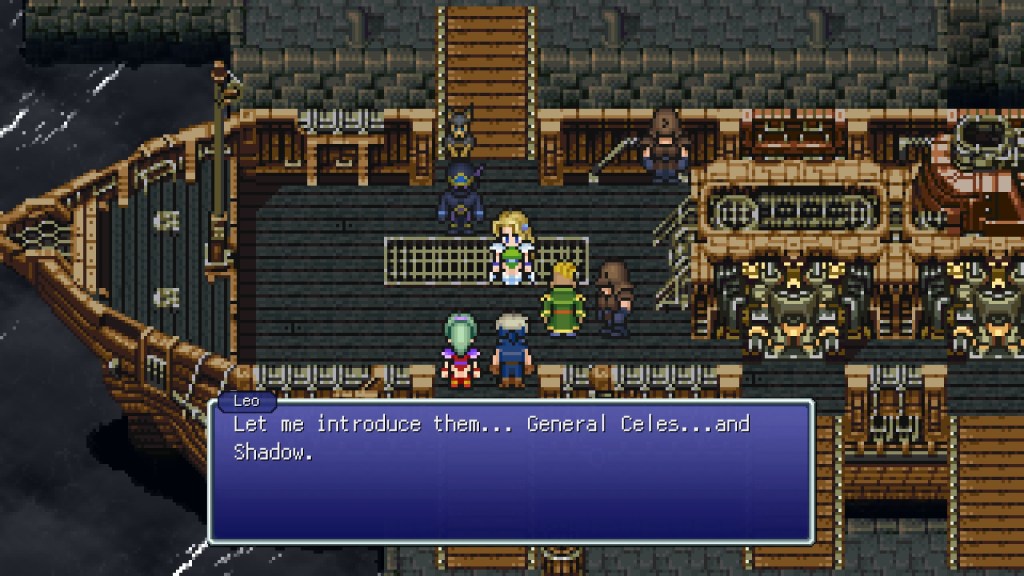

Celes plays an important part in two of my favorite bits of the game. I’ve mentioned them both in detail above so I’ll just go over them briefly here. She takes over the role of Maria in an opera in order to protect the leading lady of said opera from being kidnapped. This is one of the best scenes in video game history.
She also is the focal point for the beginning of the World of Ruin. Her story with Cid here is very tinder and a lot of it is portrayed through actual gameplay and it rules. This is one of the most underrated scenes in video game history. As a result, I absolutely love Celes. How can I not love a character central to the best parts of one of the best games ever?

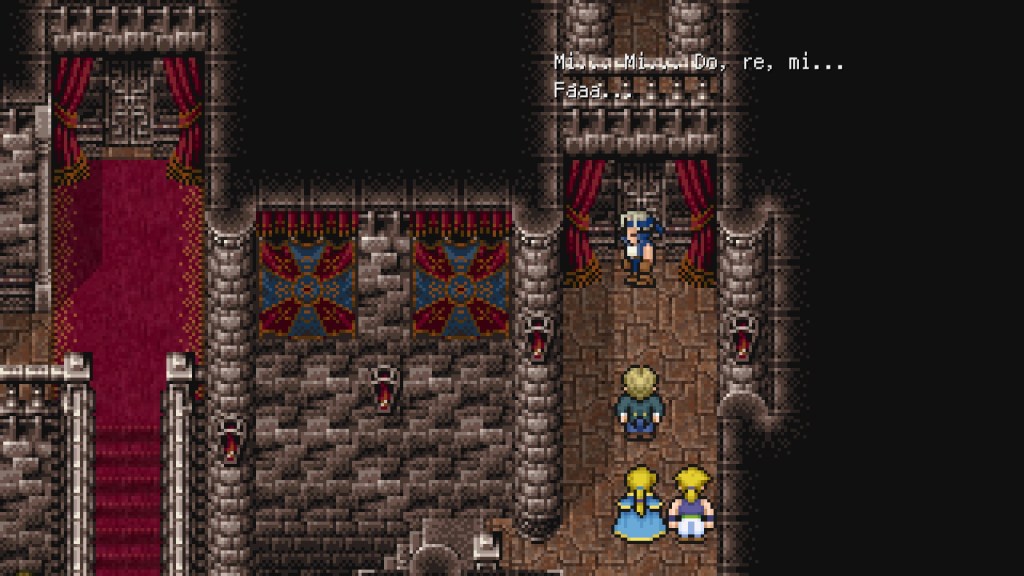
As I mentioned in Locke’s section, I also really love how understated their romance is. They never outright state their feelings for each other, but instead you just have to intuit that something is going on here. It’s handled very well and feels very much like two damaged individuals trying to come to terms with how they really feel about someone else.
Can Celes forgive herself for aligning with the empire? Can Locke get over Rachel and see the beauty in front of him? It’s up to you to guess!
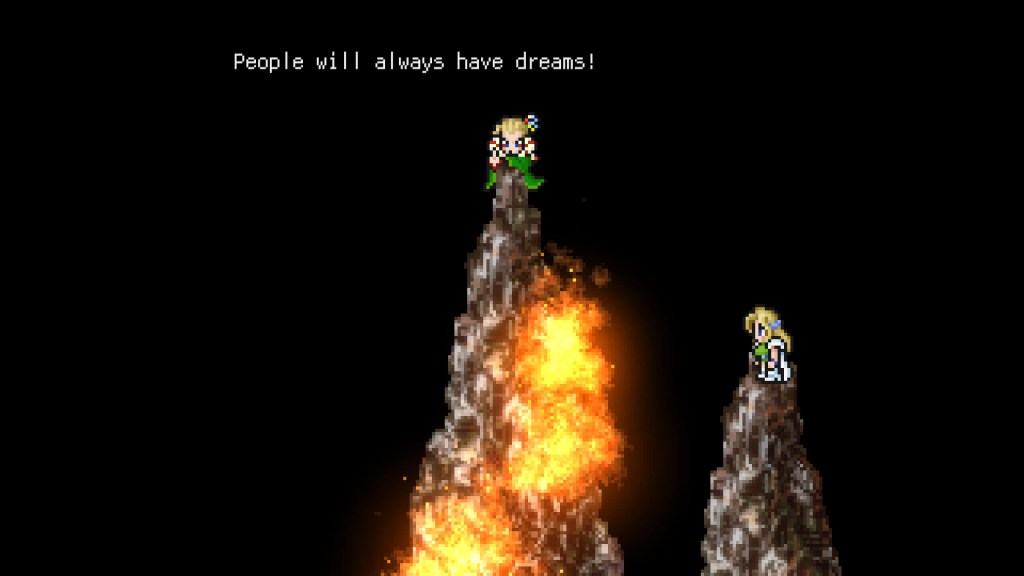

In combat, I think Celes has one of the most useless abilities. You get a brief tutorial on Runic during a boss battle shortly after recruiting the former general. Basically, Celes will raise her sword in the air and absorb a magic attack once per turn. In theory, this could be really handy, particularly in later parts of the game where magic heavy enemies run the world, but in practice I just think it sucks.
Runic does not separate friendly and hostile magic, so if you try to cast a spell and use runic in the same turn, Celes will lift her sword and absorb it. This includes healing magic, which can be a real ball buster if you need a quick heal and have forgotten that you wasted a turn on Runic. Don’t bother.
I’m a sucker. I have a bad habit in JRPGs of just using characters I like, regardless of their versatility in combat. Celes has great natural magic stats so she’s handy to have around, but even if she wasn’t, she would always be a main party member for me. In this playthrough, her and Terra were easily the best members of my crew. So in the Phoenix Cave segment of the game to recruit Locke, both were party leaders with teams formed to support their abilities. And in Kefka’s tower, the final trial on this adventure, once again she was one of the party leaders.
In short: I very much like Celes.

Cyan Garamonde

You meet Cyan as part of Sabin’s story during the party split. He is introduced to us as a loyal member of the Doma kingdom. His homeland is showing more resistance to the empire than expected. One of the empire’s leaders, General Leo, wants to approach Doma with humanity. We’ll get more into Leo later, but the important thing to know is that Cyan respects him as a sort of diamond in the empire rough.
Unfortunately, Leo gets called away to meet with Gestahl and Kefka is left in charge of how to handle the situation and that jester is a bit of a wild man, so he decides to poison the kingdom’s drinking water.
This proves extremely effective as it claims every single member of the kingdom except for Cyan. In a scene I cannot believe happens in a Super Nintendo game, Cyan enters his quarters to discover his wife and child dead. This fills him with rage and he demands revenge against the empire. Sabin is more than happy to team up with him and make that dream a reality.

Cyan’s story is about accepting what happened to his kingdom and moving on with life. The hits come early with the Phantom Train sequence. He witnesses the majority of his kingdom, including his family, moving on to the afterlife. The way the game handles what’s going on around Cyan is slightly weird, as about 10 minutes after we witness the samurai bidding a final farewell to his loved ones, we are introduced to Gau who proceeds to goof around and annoy your party, which leads to one of the most hilarious scenes explaining death I have ever seen in a game.
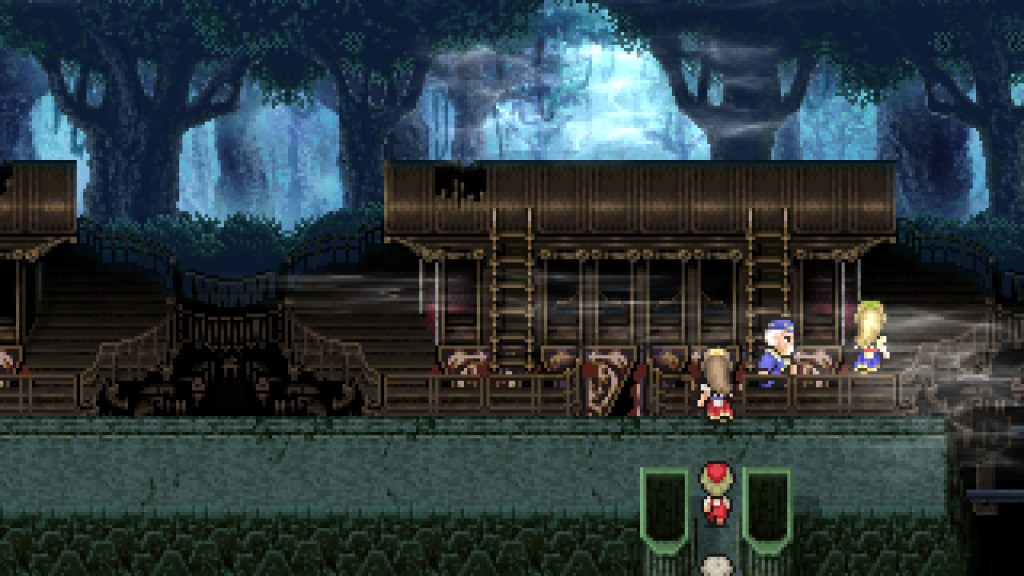

One of the late game sidequests sees the party entering Cyan’s dream world in order to help him cope with everything. It’s a pretty memorable sequence and helps you see the inner workings of his mind and experience some of his life before the events of the game.
It’s wild to me that these scenes are easily missable as they include some of the best content in the game. You trigger this bit by going to Doma Castle and resting in a bed with Cyan in your party. There is no reason to do this, very few players would discover this on their own. Also for some reason the main villains here are based off of the three stooges. I can’t say I understand this choice.
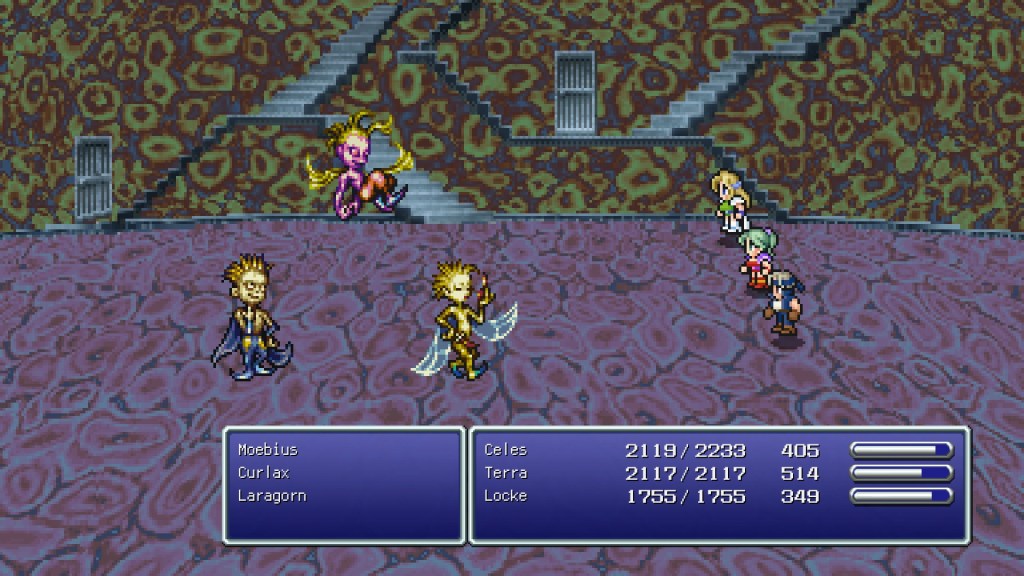
Cyan is shown to have a bit of a sweet side. In the World of Ruin, it’s revealed that he has been passing time in the apocalypse by writing letters to a widow pretending to be her long deceased husband. The samurai speaks in an old english style tongue using thees and thous, so the identity of the writer is immediately obvious to the player. It’s a very sweet moment for a guy who is probably trying to relive feelings he had with his own deceased spouse.
Every scene depicting Cyan’s family life before everything turned upside down is really well handled. It portrays him as a noble warrior with a softside. He’s a traditional fella who adores his family but feels slightly embarrassed about putting it out there. Still, everything he does is for his loved ones and his kingdom. This is yet another character I absolutely adore. In case you haven’t noticed, there are a few of those!

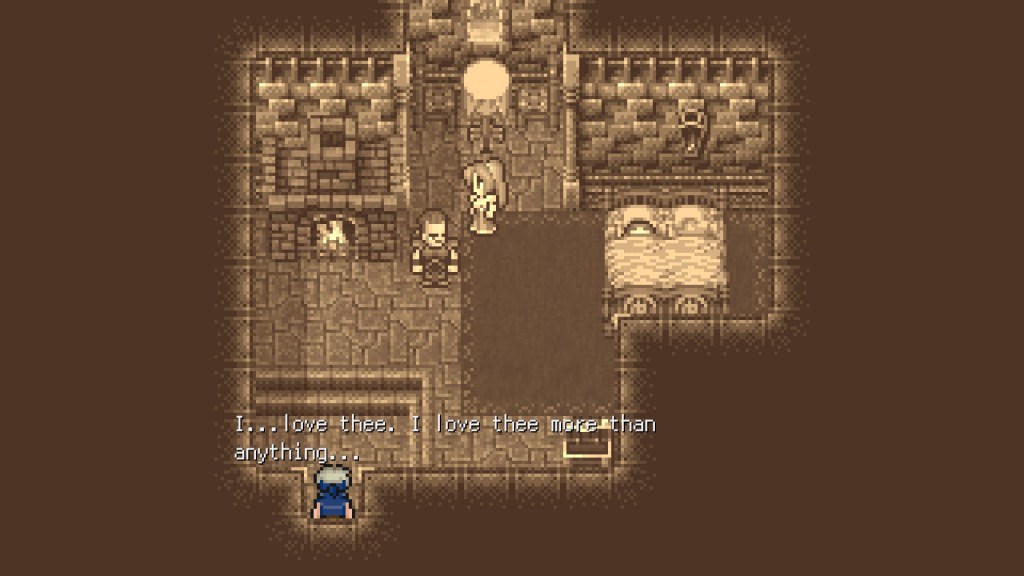
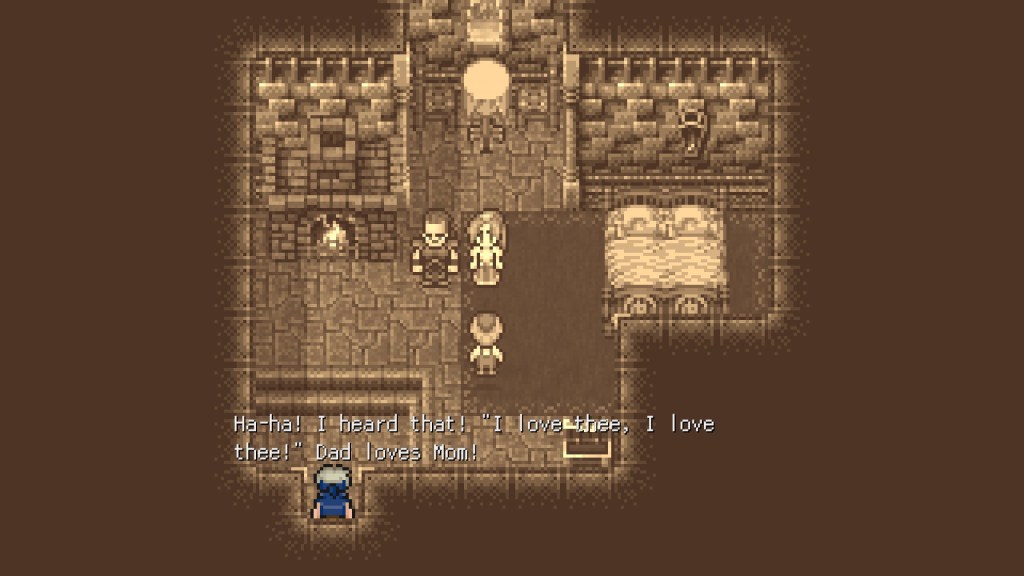

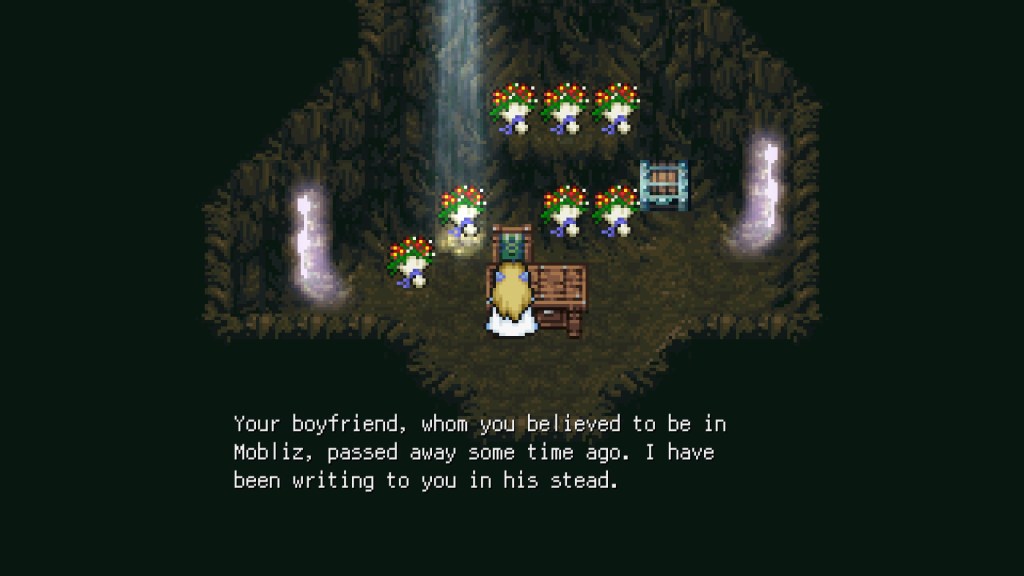
I think Cyan is a really good straight man. He’s so serious, but sometimes the party goofs off around him and his reaction to these hijinks packs more humor than most comedy characters could hope for. Final Fantasy VI has far fewer laughs than Final Fantasy V, but there are still plenty of chuckles to be had and a fair amount of them come from Cyan scenes. Surprising given that his whole story comes from everybody he knows being killed by the main antagonist of the game.
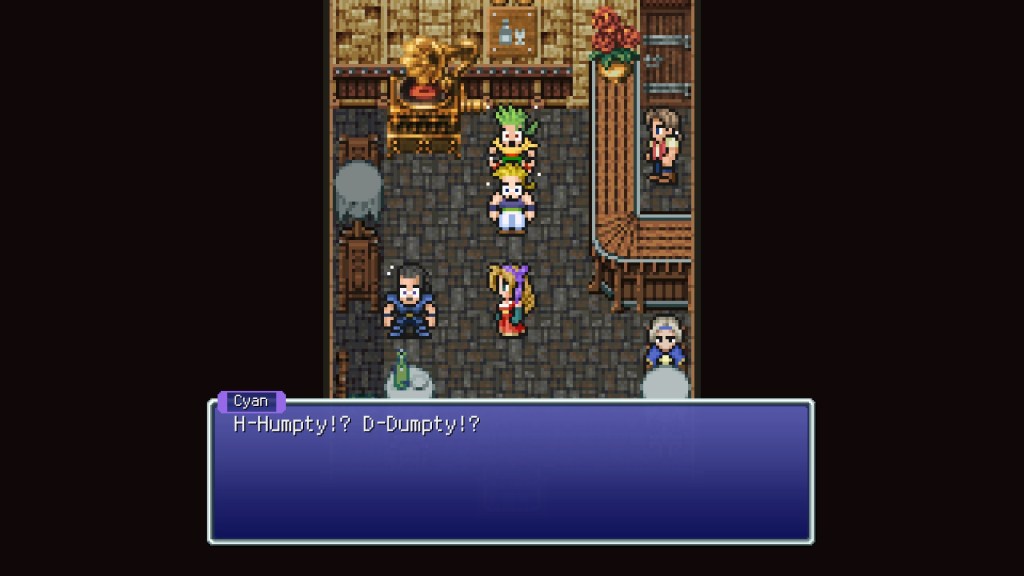
In combat, Cyan has an ability that really sucks to use in most versions of the game. It’s called Bushido and it involves letting a meter slowly fill up in order to use various skills. Enemies continue to attack you as the meter fills, which makes using stronger abilities an absolute waste of time.
However, the remaster makes a tweak to this by allowing you to select any one of Cyan’s bushido abilities and just use them. This is slightly unfair since his best ability functions as sort of a Zanketsuken (auto kill to every bad guy, doesn’t typically work on bosses), but by the time you get this, your party might be full of nukes anyway so it doesn’t really matter.
Cyan is usually an important figure in the final dungeon with me but he is very rarely in my main party. This is because of Bushido. I find Locke more useful from a physical standpoint and he can steal and Sabin, well, I love using Blitzes. Still, the remaster saw him get more play time due to the Bushido changes. Another good change! For some reason I feel FFVI got more tweaks than the other two SNES Pixel Remasters.

Shadow

Here is your traditional ninja character. Enjoy it while you can because you only get a ninja party member twice more in the mainline franchise and one of them doesn’t even have access to throw. Unbelievable! You first meet Shadow as an NPC in a bar before the “choose your party” segment of the game. You are warned that he is a bad customer.
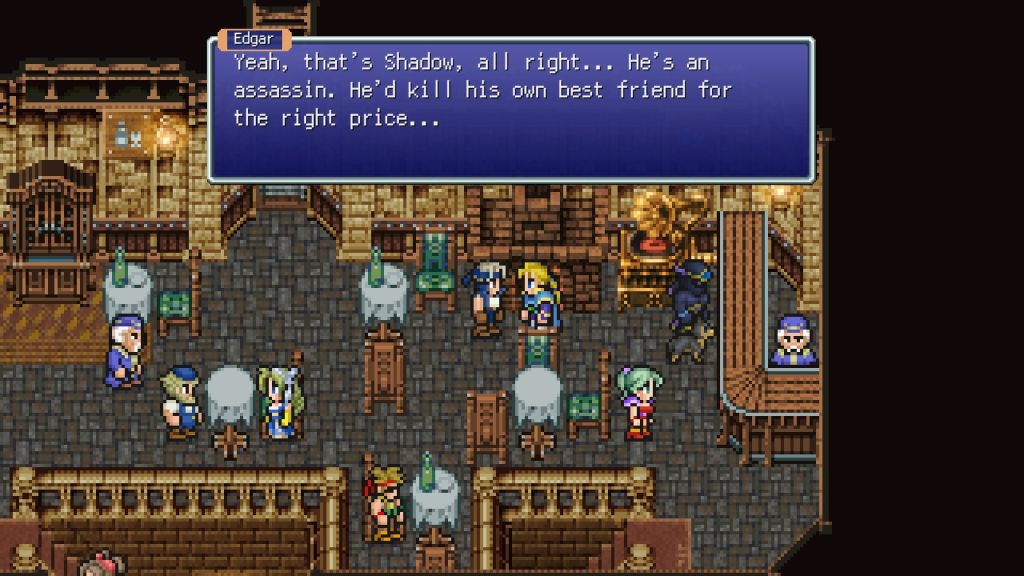
The Ted Woolsey SNES line is far superior to this retranslation, even if what is in this version is probably more accurate. Edgar states that Shadow would slit his mama’s throat for a nickel. That isn’t very much money! But both lines get the main point across about this guy. He is a mercenary and he has no true loyalties. He only cares about getting paid.
Shadow officially joins the party during the “Sabin” section of the party splitting portion of the game. He basically says that they are going in the same direction and that he will tag along with you for a while. He splits when you’re done with the phantom train segment for what seems like no reason and that’s that.
He’ll randomly pop up and offer his services to you as your journey progresses – usually if you are rocking a party of three instead of four for whatever reason – but he will always leave. That’s just how he is. Much about him is a mystery, which is how he likes it.
Still, we do learn some things about Shadow. Before the game he fathers a child but he, along with his dog interceptor, abandon her at some point out of fear that his past will catch up with him. In this scene we get the lone glimpse of Shadow without his ninja gear on. Turns out his true name is Clyde.

It is heavily hinted in the game that his daughter is a different party member by the name of Relm. The big hint for this is that Interceptor hates almost everyone. Shadow even says that he EATS strangers (in the original translation, ya gotta love the Woolster baby).
But for some reason, Interceptor is extremely kind towards Relm and shows genuine concern over her when her life is in danger. It never outright states their relationship, though it has been confirmed over the years, but they hint at it pretty damn hard. Once again, I enjoy that VI doesn’t just state the facts for you, but instead lets the player infer things for themselves.


Shadow also features in a rare bit of player choice. On the floating continent, the last main area of the game in the World of Balance before things get destroyed, Shadow reveals that he was hired by the empire and that they had intended to kill him after he was deemed no longer necessary.
He teams up with your crew here but abandons the party out of shame. Right when it looks like Kefka is going to kill everyone, Shadow comes back and opens a window for your party to get out of dodge. You then have six minutes to get to your airship.
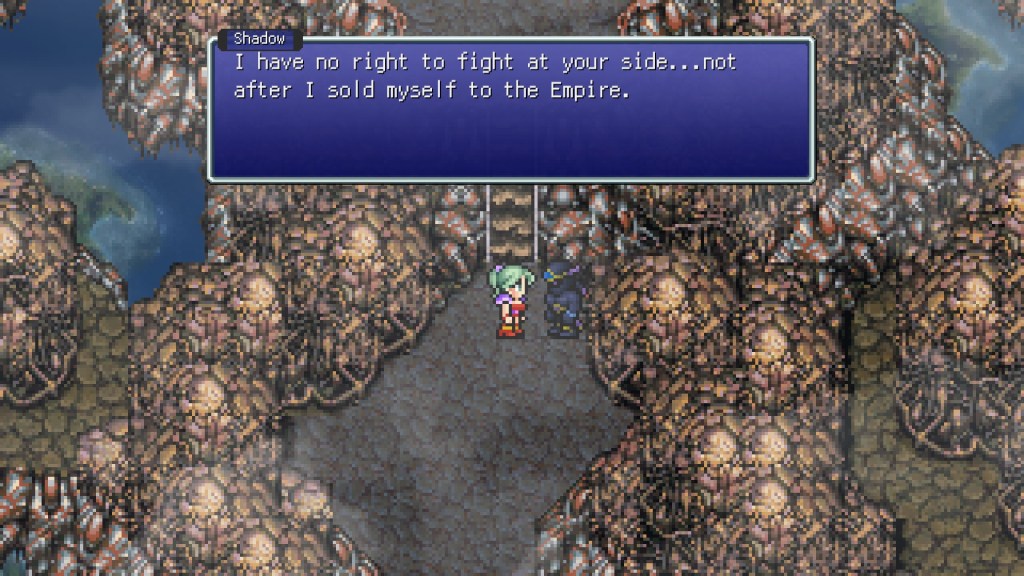
You’ll probably get there in well under six minutes. In this playthrough, I think I got to my airship with about four minutes to spare. A panicked first time player might see the countdown timer and just decide to jump for it but if you are aware of genre tropes, you know that during escape sequences, the hero often escapes at the last second.
If you let the clock tick down to about five seconds left, Shadow will show back up and you can get out of there together. If you don’t wait for Shadow, he never appears in the World of Ruin. He’s just dead. The game never has a long mourning segment for Shadow. He either dies or he doesn’t. It rules.
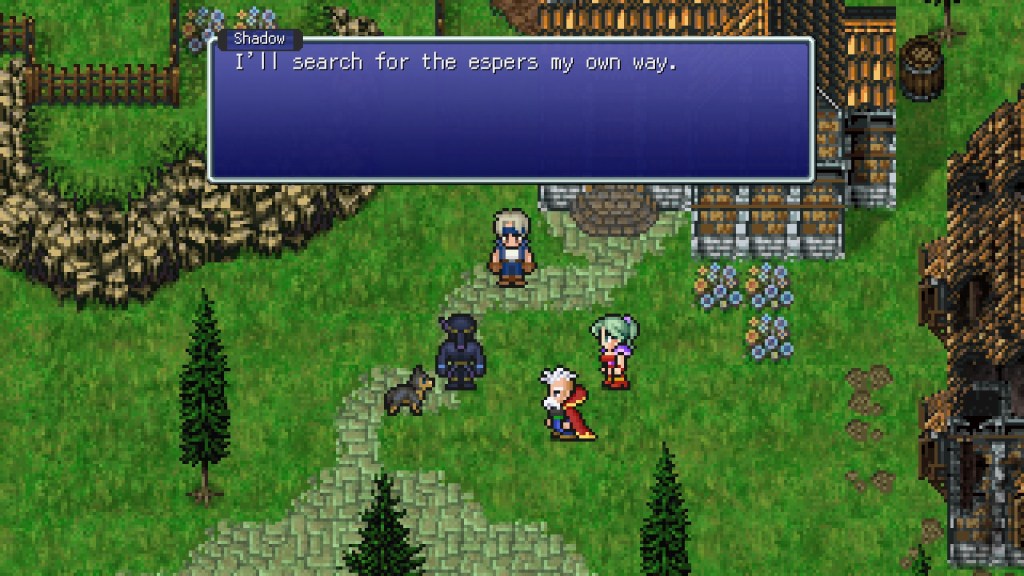
I very much appreciate Shadow. Your first instinct when you meet him is that he might be an edgy character that’s only about brooding and killing and being a badass. But no. He puts on a very hard exterior but I never really got the impression that he revels in his line of work. Being a mercenary is just a job. He even reveals during the final bit of the game that he is doing all of this for “friends…and family.” This is a very endearing enigmatic character, which I think is very hard to pull off.
Since Shadow is a ninja, he is inherently one of the more useful party members. Throwing shuriken remains a solid source of damage, especially when he joins up with the party the first time and occasionally Interceptor will also come along and help out his papa by causing heavy damage to fiends.
In this playthrough, I used Shadow quite a lot, to the point he was one of my team leaders in the final dungeon alongside Terra and Celes. His speed and throwing ability just make him insanely useful. He’s the only main party member I had that didn’t know Ultima by the end of the game and he was still dealing around 7,000 per shuriken throw. A total beast.
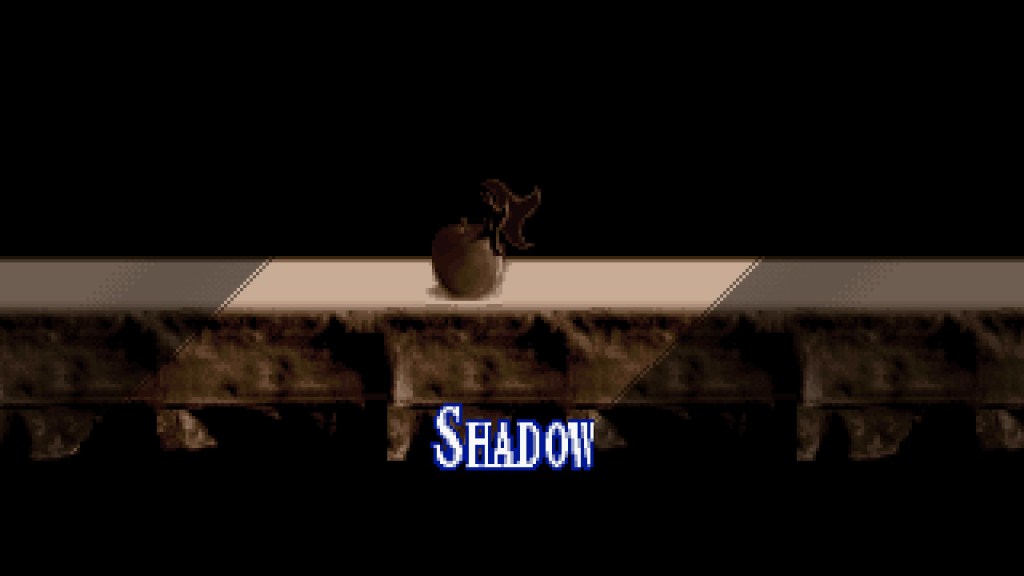
Gau

Gau came into the world as a normal child. However, normalcy lasted all of 20 seconds as his mother died during childbirth, which drove his father insane. In his mania, Gau was cast out into the wilderness (The Veldt) and grew up as something of a wild man. He’s your unga bunga caveman type. He’s also one of the main reasons I cast slight doubt at the FF6 team for saying every character is a main character. Sorry, but Gau is like one step removed from FF2’s Guy!

Indeed!
Sabin and Cyan encounter Gau on the Veldt shortly after the whole phantom train sequence. It’s a really jarring bit of gameplay since Gau is a madman who can barely speak in human language and acts absolutely silly. It’s just a really sharp adjustment to make after we spent an hour watching Cyan adjust to the death of his family. But hey. You recruit Gau by tossing a flank of meat at him. That’s all it takes to win his friendship. He’s like Monkey D. Luffy!



His main contribution to the plot is getting Sabin and Cyan over to Narshe during the segment where everyone is trying to reunite. He has a shiny treasure that actually turns out to be an underwater breathing apparatus. Sabin and Cyan decide to trust this strange ape boy with their ability to continue breathing, wear the thing and return to civilization.
His character just kind of pauses here. He’s a wild man, that’s all you really need to know about him. You even recruit him in the exact same spot in the World of Ruin that you do in the World of Balance. Though he does get a neat little end game scenario where you meet his father who is still quite looney.
You’ve seen him a couple of times before because he keeps accusing Sabin of being a repair man of some sort, but during this visit your crew puts together that this fella is actually Gau’s dad. What follows is what can best be described as a Taming of the Shrew situation.
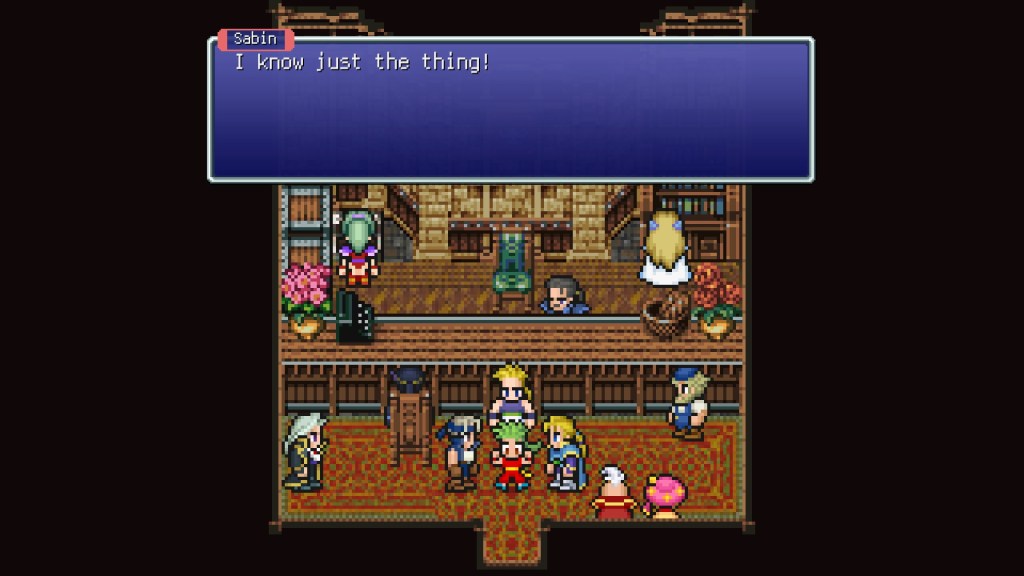


This scene brings the cast together to have them do some fun stuff that doesn’t involve trying to kill Kefka. It reminds me of the events in Mass Effect where the whole crew would bond together over something silly while the threat of the reapers loomed.
Gau is a simple and fun character so having a fun little cast moment centered around his family is very nice. His dad doesn’t seem to realize what’s going on still, but Gau doesn’t mind. He’s a sweet and simple minded kid, so he’s just happy that his dad is alive. He doesn’t need to be tight with him, he just needs to know he’s still drawing breath. Relatable to many!
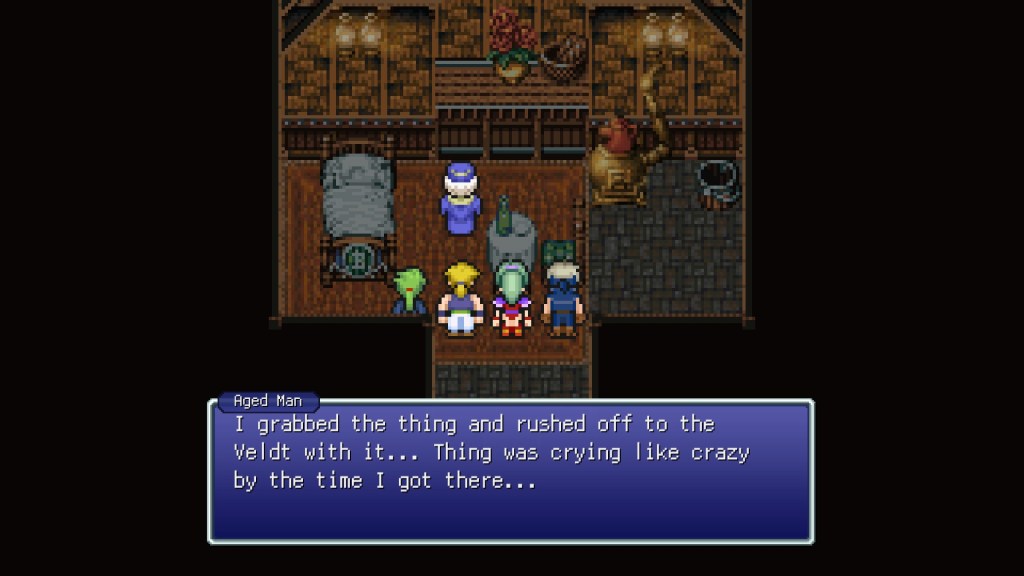
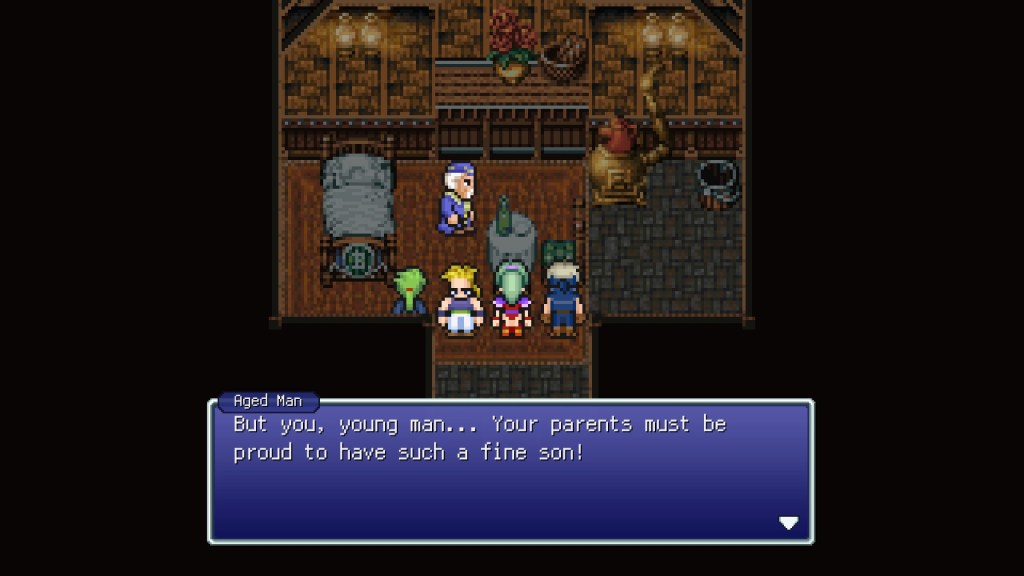

Unfortunately, Gau is something of a gimmick character. His unique ability is Rage, which lets him copy the moveset of any normal enemy in the game. You can gain new movesets by leaping during battles on the Veldt. After he leaps, the little rascal is unavailable in battle for a short period of time. He will learn any skills of enemies that he used the skill against as well as any enemies you are fighting when he returns.
The issue with this is that you can’t control Gau when he takes these forms, so he functions as a semi-berserker. He’s sort of like a fusion of a berserker and a blue magic user. I don’t like characters I can’t directly control, so I have never really used him and in this play through his final level was 14. For reference, my next lowest level was Gogo at 28.
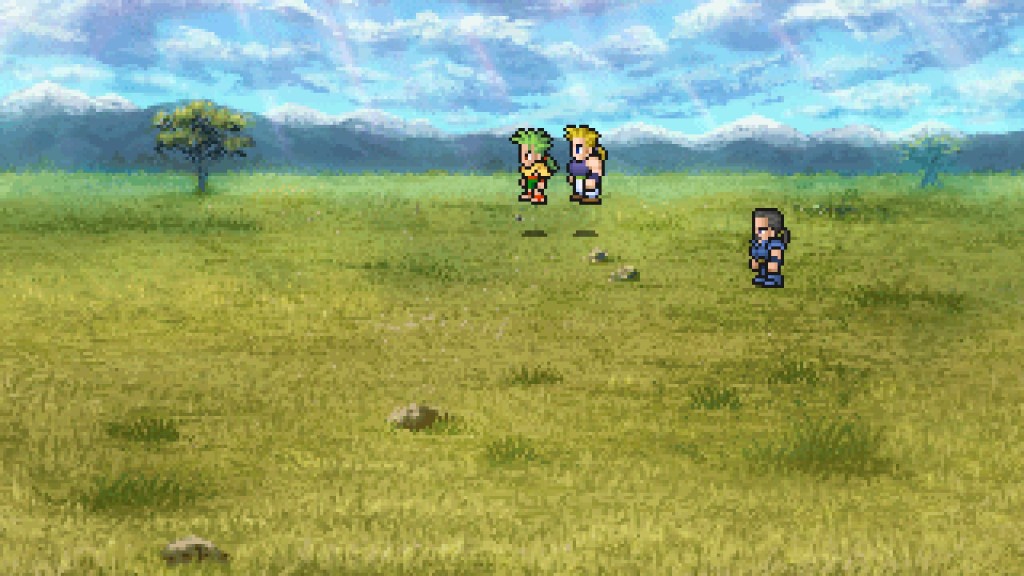
I was looking around for information on Gau and stumbled across a GameFAQs thread where someone was talking about how they just don’t get the point of him and everyone in the thread was like ‘he’s the best character in the game, don’t come back here when you get destroyed in the later dungeons!’ So I guess he’s good if you have the patience for that sort of thing? I don’t.
As I said earlier, I tend to use characters I like a lot and while I enjoy Gau, he’s really not one of my favorites and I certainly don’t like him enough to put up with all the jumping on the Veldt needed to get him some good movesets. I’m sorry for failing you!
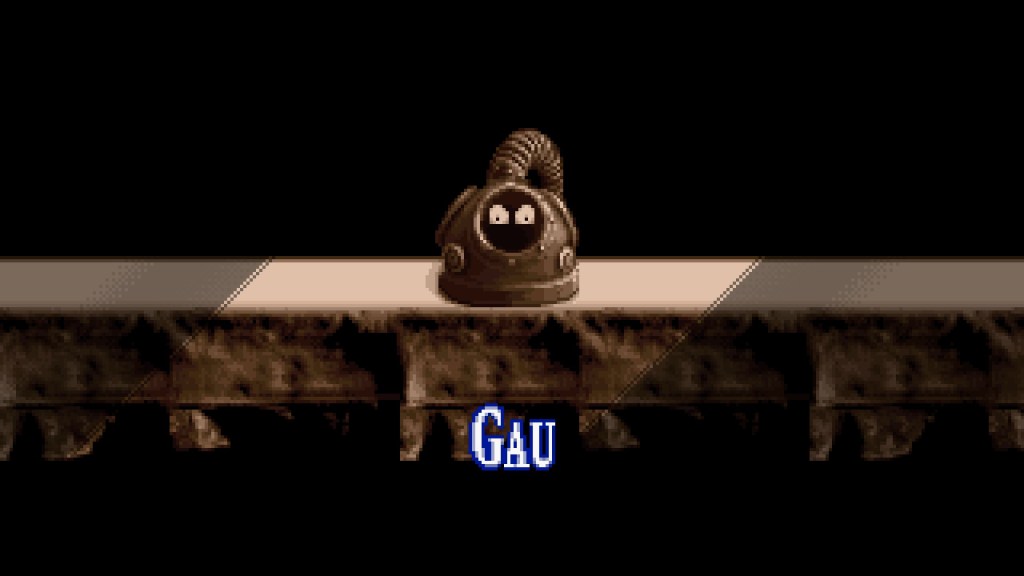
Leo Cristophe AKA General Leo

General Leo is a commander in Gestahl’s empire and is portrayed as the one good man in an army of heinous fiends. His main character trait involves showing compassion. He is portrayed as the opposite side of the coin to Kefka. Whereas Kefka sees no use for anybody who doesn’t further his immediate goals, General Leo sees humanity in everybody.
For instance, he does not condone the mass execution of the citizens of Doma. Yes, he wants to further the ideals of the empire, but he doesn’t see the enemy as some sort of group of wild animals. Instead, he knows they have a family waiting at home just like he does and wants to see them return to their loved ones. How the hell did Gestahl pick this guy to be one of his top men? He doesn’t act like anybody else in the empire!

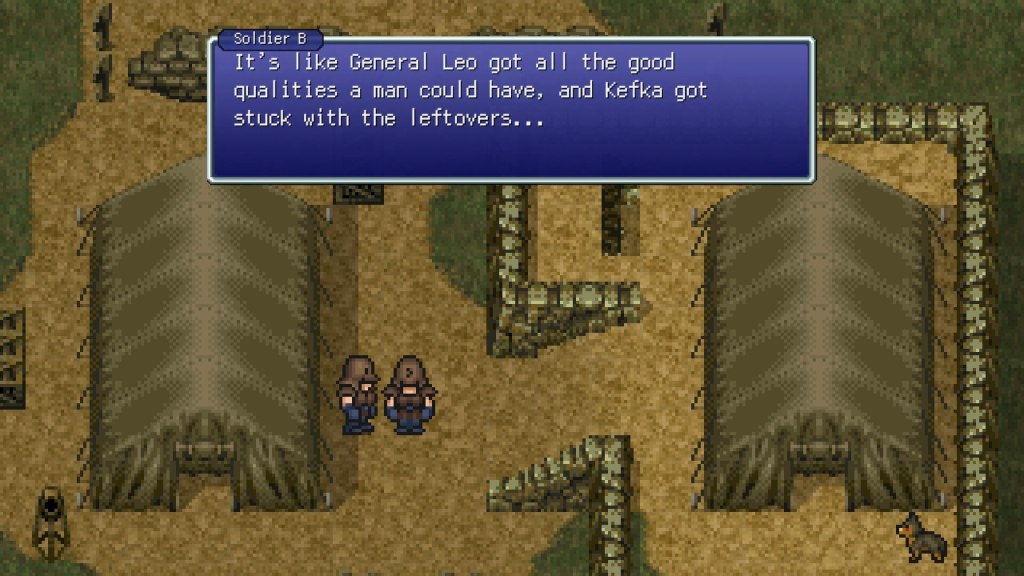

Probably my favorite bit of character work from Leo comes from a conversation he has with Terra. The party has made a temporary truce with the empire and are off to round up Espers in order to broker a peace deal. They are on a boat and Terra in the middle of the night is thinking about her life, as one does. She wants to know whether anybody can truly accept her for the things she’s done in the past and for her heritage. Leo keeps it simple and tells her that everyone can feel love, the circumstances of her birth are irrelevant to that.
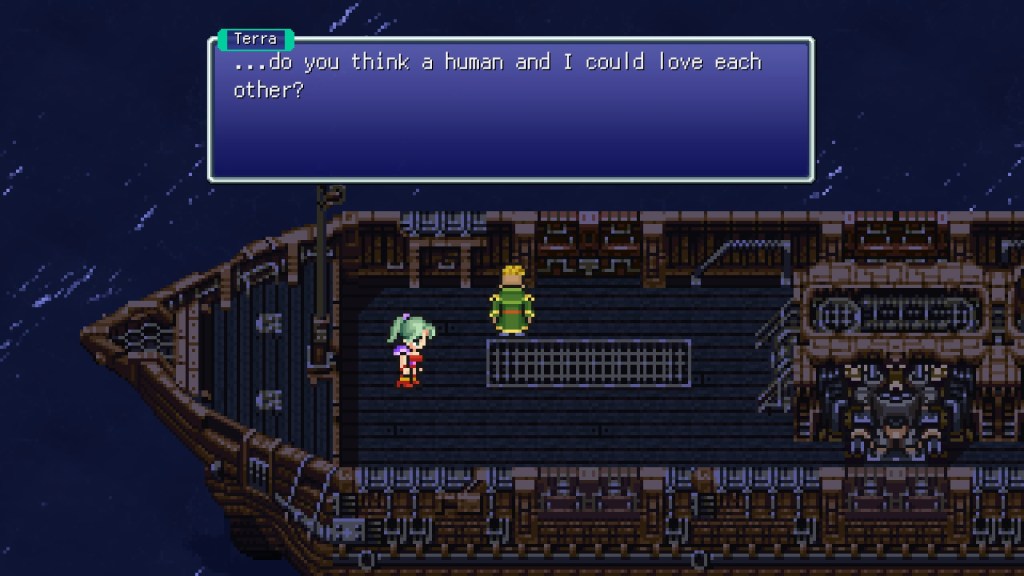
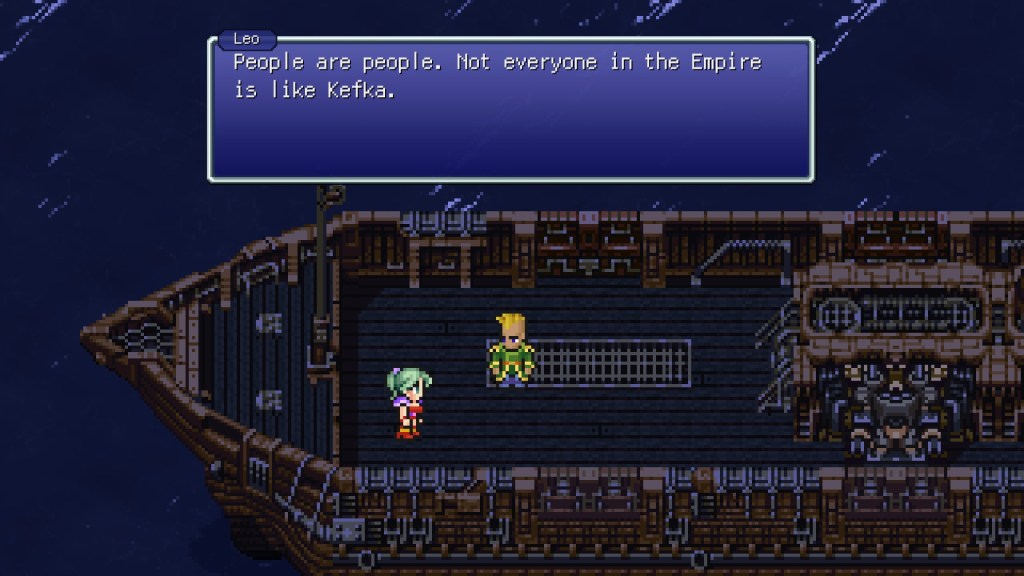
Leo never joins your party. Instead, when the empire shows their true colors while the crew is trying to make peace with the Espers, Leo becomes enraged and attacks Kefka. The battle portrait above can only be seen in that small sequence and most players may not even think to bring up the menu during all this.
The decision to make Leo briefly playable seems strange considering characters die all the time in this game, but I think the choice is a small bit of “gameplay servicing story.” Controlling Leo sort of infers that he made the switch over to the side of the righteous. It teases that maybe if you can defeat Kefka, he will join the crew and you guys can march to the empire and set things right.
Of course, that doesn’t happen. Despite having one of the coolest moves in the series, a technique so awesome that all of the best knights in the franchise get access to it from here on out, Kefka kills him. You only get a small taste of Leo’s abilities during this, but you can tell he could probably solo your party if he wanted to. This little taste tells us that Kefka is no mere jester and is quite a tough customer himself. It’s a pretty sharp decision to let the player experience and comparable to Tellah being unable to use meteor until his final moments.

My favorite thing about Leo is that he was the center of so many playground rumors. You got to PLAY as this guy so it only made sense that there had to be a way to keep him alive. Secrets on how to keep the Empire’s bravest warrior alive spread en masse, usually involving ridiculously convoluted scenarios. If you were around in the 90s and didn’t play FFVI, think about all the schoolyard rumors that circulated with Pokemon. Do you remember all the dumb bullshit you had to do to catch Pikablu, Charcolt, Nidogod or Togepi? What about Bill’s secret garden? Same stuff here.
I have a lot of nostalgia for things like that because with the proliferation of the Internet, such things can’t exist anymore. You can just do a search for “Can you use General Leo again?” and you’ll ultimately see that all efforts to revive him are futile. Sad.
Leo is a bit simplistic from a personality standpoint. We are told over and over again how good of a guy he is. Cyan, who just lost everybody in his life moments ago, even stops to comment on how virtuous this fella is. The point of this is to drive home a pretty basic message about warfare (not everybody is evil) and despite how heavy-handed it can feel at times…it totally works.
I love Leo and wish he could come along with us. Sure, part of it is because I want easy access to Shock, but I just think he’s a cool guy.

Setzer Gabbiani

Setzer is introduced to the party in a slightly unusual way. He writes a letter to the opera house and says that he is going to kidnap the lead actress, Maria, and make her his wife. Kind of a moustache twirling villain routine, you would think. This letter prompts Celes to volunteer to take Maria’s place in the opera and thus one of the best scenes in video game history begins. True to his word, Setzer swoops in and abducts the lead actress.

I’m not sure what he means by this.
At first he seems genuinely annoyed by the ruse, but he later appreciates the gumption of Celes and crew (after they swindle him in a simple coin flip game) and agrees to help fly them about in his fancy airship. Setzer and his vehicle are key to your progression – he is one of the three mandatory characters needed for beating the game. You can’t drop into Kefka’s tower of death without an airship!
Setzer’s whole gimmick is gambling. Half of his dialogue involves him using gambling terms like pushing all of his chips in or upping the ante or gambling with his life or things like that. It’s like how when you’re watching a baseball game or something and they slam 83,000,000 Draft Kings ads in your face. Like, you get it, but it gets tiring after a little bit.
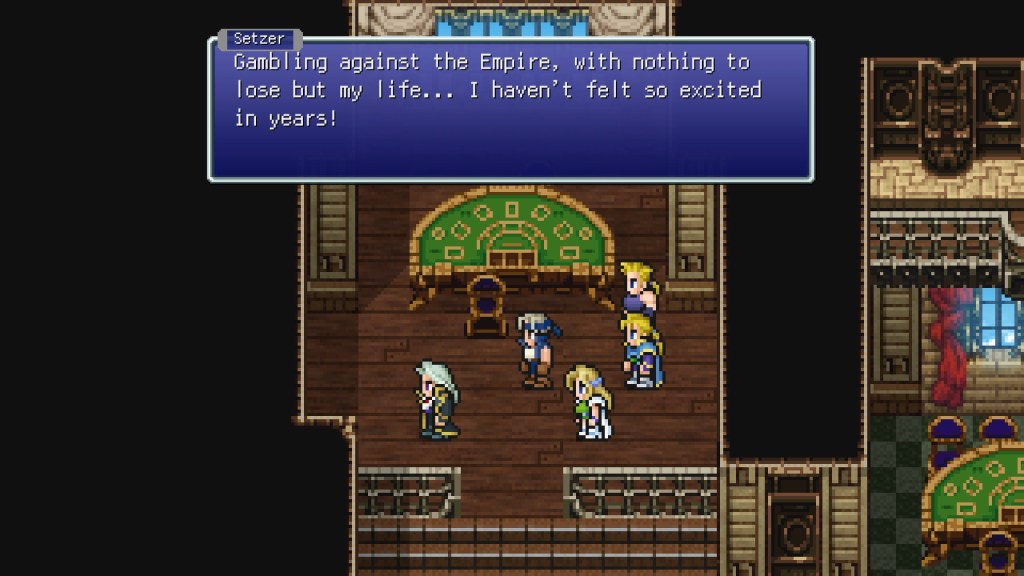
Setzer really loves his airship too. I mean, look at that picture above, he keeps all his blackjack tables there! So it’s a bit of bitter pill to swallow when it goes up in flames after Kefka destroys the world halfway through the game.
In fact, Celes runs into Setzer in the World of Ruin and he is still sulking about his wings being taken away. He doesn’t even want to help you save the world. After some cajoling he changes his mind and also reveals the existence of a second airship!
You see, a long time ago Setzer had a girlfriend named Darill. Their hobby was racing airships. Darill’s airship, the Falcon, would always beat Setzer’s vehicle, the Blackjack. Man that guy loves gambling. One day, Darill said she was going to explore a little bit and enjoy the freedom of flight. She proceeded to crash and die.
Setzer only discovered her fate once he found the wreckage. He worked on repairing it in secret but couldn’t bring himself to actually risk losing that too. It was the one thing Setzer wasn’t willing to wager. It’s kind of sweet.
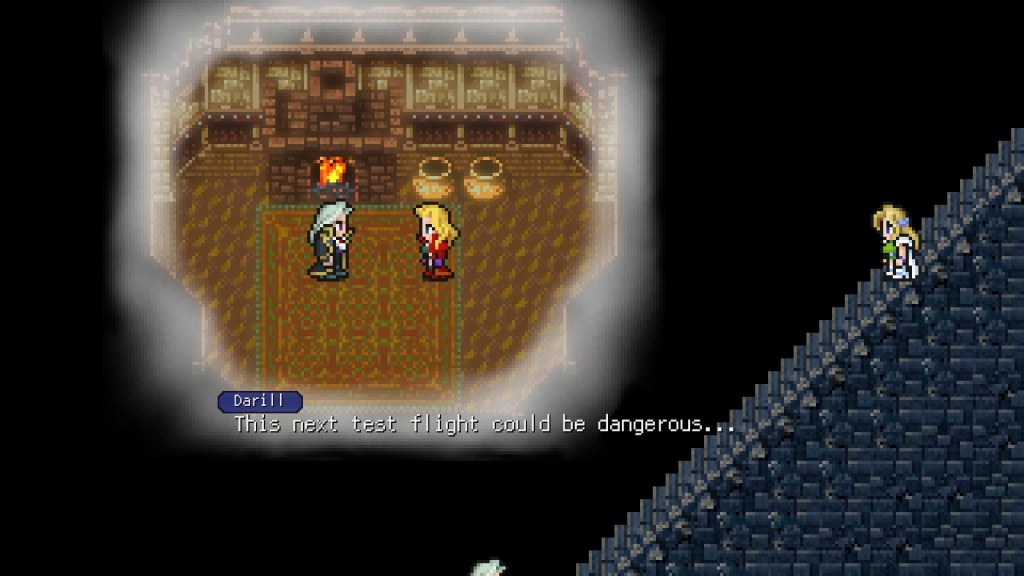
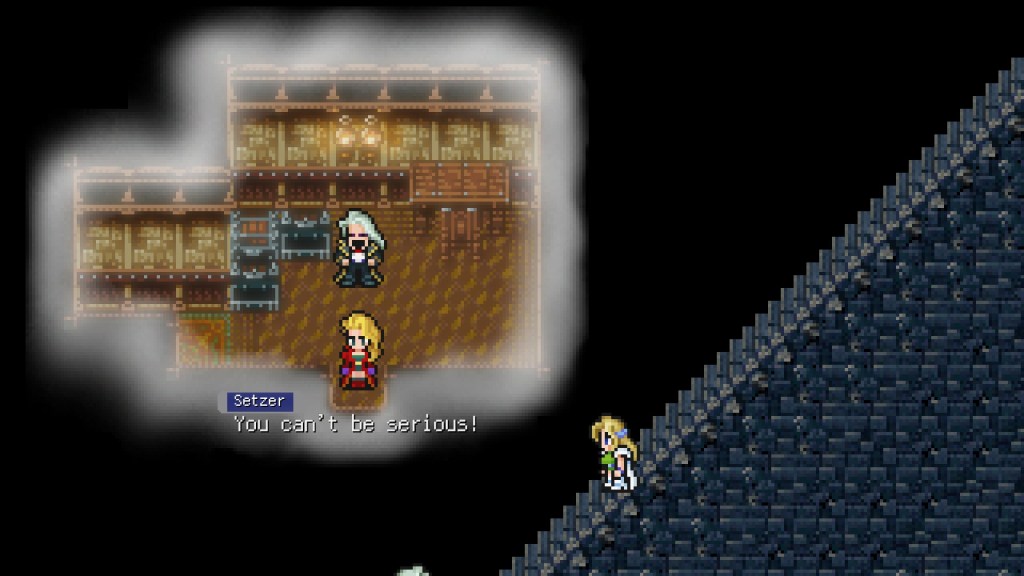
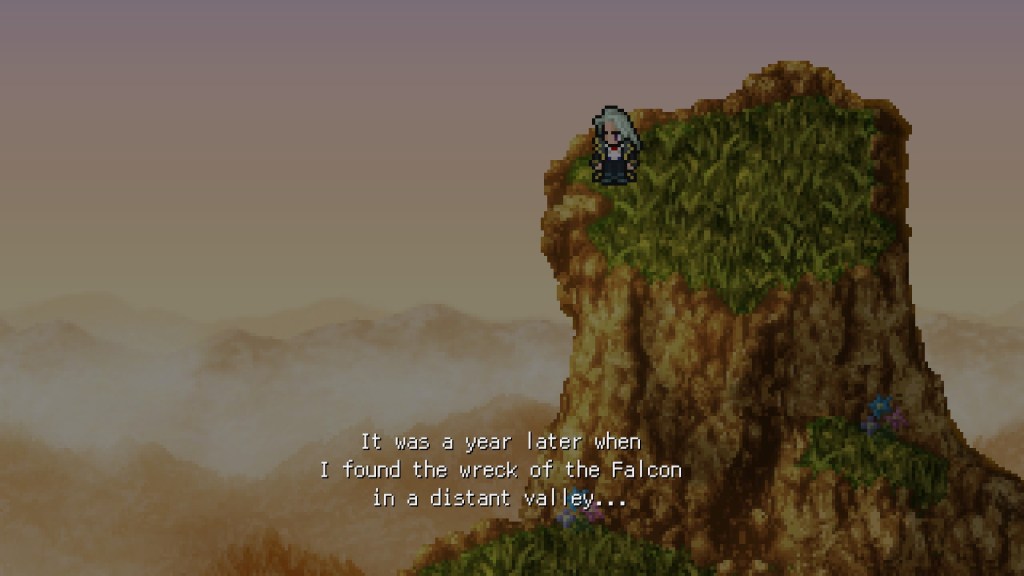
He is, of course, convinced to risk it in order to save the world.
Setzer’s unique combat ability is slots and it is exactly what it sounds like. You have three reels to work with and lining up your icons will give you different abilities. In this playthrough I got three different ones. The first is an ability that pops up when you get no matches called Mysidian Rabbit (A reference to Final Fantasy II). It heals your party for like 100 HP, pretty useless by the time you get Setzer. The second is an ability that summons a Chocobo stampede and the third is prismatic flash, a pretty standard move that attacks everyone.
There are other techniques – you can summon Bahamut through slots and you can even kill your entire party if you’re particularly unlucky – but I have never been a fan of slot abilities so I didn’t use it much. My loss!
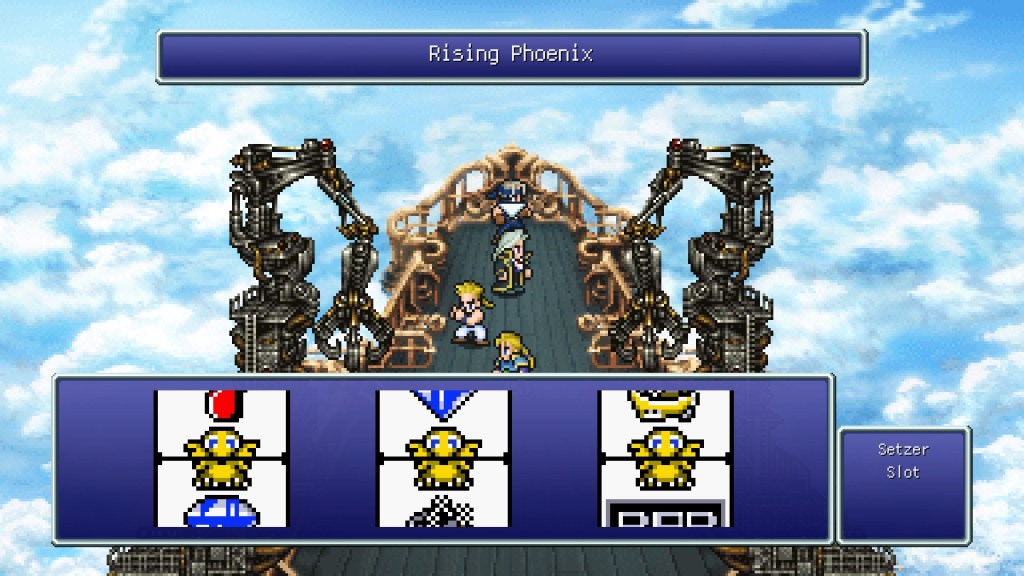
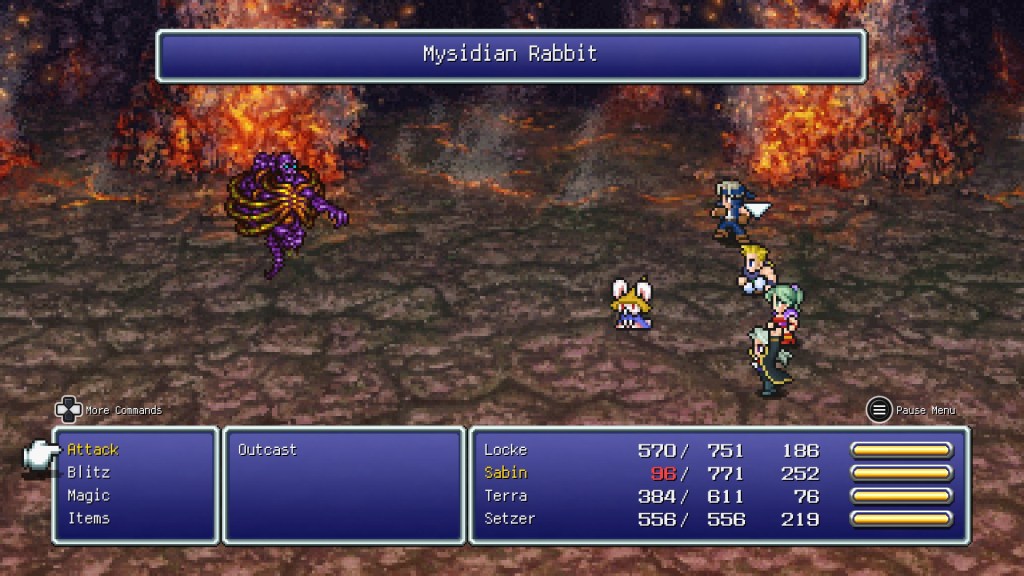
I enjoy Setzer as a character. He’s fun to have around and I think he’d make an interesting leading man in a side game if they ever decided to do something like that. He feels like a very, very early prototype of what would morph into Balthier in Final Fantasy XII. Also, he was one of the characters that Tetsuya Nomura worked on, so it’s pretty hard for me not to like him at least a little. I am a Kingdom Hearts enthusiast, you know. Unfortunately, this playthrough mostly saw Setzer as a secondary party member.
Oh and fun fact, I once hosted a podcast where a cohost used the alias “Setzer.” So now when I see this gambling fiend I always think of him. Good times!

Strago Magus

During your temporary alliance with the empire, your crew goes to Thamasa in order to hunt down the Espers who laid waste to the Empire capital of Vector and broker a peace deal. Everybody there is extremely tight lipped and wary of strangers. You meet Strago here, and only when his (not really) granddaughter Relm is trapped in a burning building, does he reveal the secret of Thamasa.
Everybody who lives here can use magic too. They aren’t even half-Espers like Terra, they are just the last remnants of humanity who can still use the mystic arts.

Strago agrees to help the party find the Espers and in doing so he reveals a lot of lore that will become extremely relevant in a couple of in-game hours. This is related to the Warring Triad. You see, a long time ago there was a conflict called the War of the Magi. This is referenced a few times in the game, most prominently when you go to Zozo to save Terra.
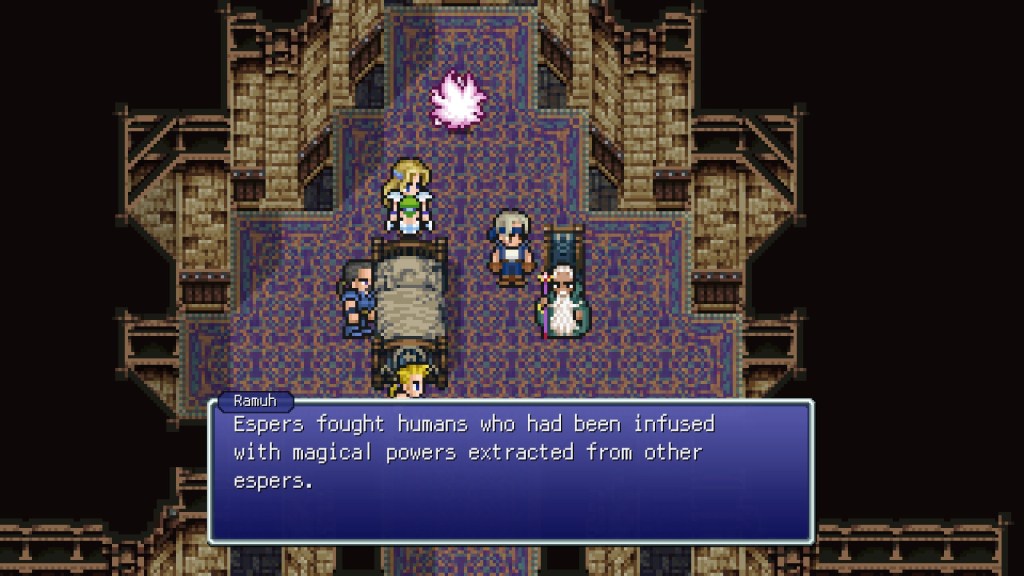
The basics of it are that three gods descended upon the world and started a fight with each other. They introduced humanity to magic and enlisted them in this conflict, which helped give birth to the Espers. The gods eventually realized that their war was a bad thing and turned themselves to stone statues to stop the fighting. These stone statues impact the state of the world, so moving them is not ideal. They task the Espers with hiding them away in order to keep the peace.
Strago tells you this and says things would be extremely bad if someone came along and moved those statues and you won’t BELIEVE what happens shortly after that.
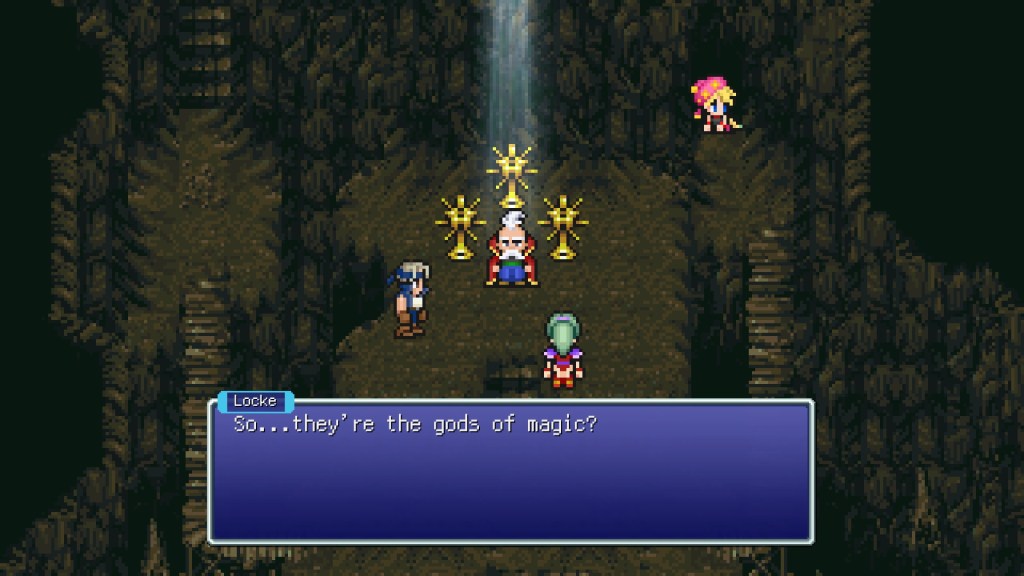
Strago is mainly shown as a loving and somewhat doting grandfather. He may not be related by blood to Relm – another in-game hint that Shadow is the true father there – but he loves her all the same. Any time the party wants to go do something and Relm wants to tag along, he immediately shoots it down.
Of course, she doesn’t listen, but that’s part of the charm of their interactions. It’s simple yet endearing.
At the end of the world, Strago is under the impression that Relm died whenever the Blackjack got shot out of the sky. This sends him into a bit of a chaotic state and he joins up with the cult of Kefka. As they say, if you’re not sure of your place in the world, join a cult! You’ll find like minded souls there!
It’s not clear (well, to me it isn’t anyway) whether he joined the cult out of desperation or if they mind controlled him in some way, but he’s there regardless. If Relm is in your party, she simply shouts at him and he immediately snaps out of it and rejoins the party. Hooray!
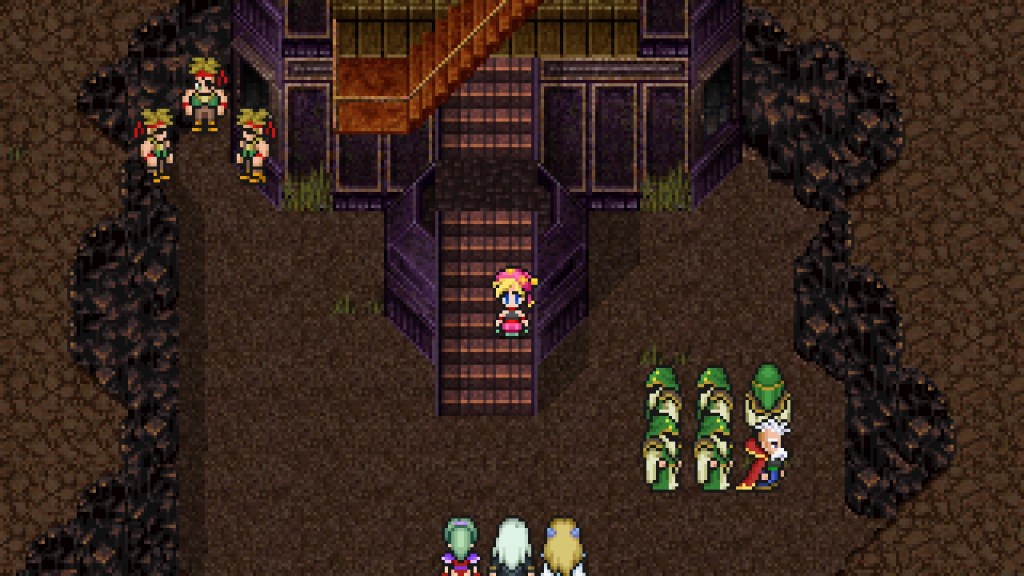
Strago is your Blue Mage this go around. In case you forgot what a Blue Mage is, it’s the job that can use enemy magic. By the time you get Strago in the World of Balance, you can kind of tell things are ramping up, and I’ve never really felt the need to go hunting down various blue magics. I mean, I have access to Fira and Blizarra at this point, why would I need level 5 death? His initial ability, Aquabreath, is extremely handy when you’re rescuing Relm from the burning house though.
As a result of me just not digging blue magic, Strago is almost always a bench rider. He has decent magic stats but – and again, I don’t think about min-maxing or numbers too much – he doesn’t touch Terra or Celes in that regard so he doesn’t see a lot of play for me. If I’m fighting Kefka and Strago gets pulled up, I know I’m probably losing that fight because I’ve lost everyone else I’ve actually invested time in. Poor guy.
I think Strago mainly exists to spout lore at your party. His blue magic is called lore, coincidentally enough. His World of Ruin story after the whole cult thing involves him hunting down a monster that used to give him grief ages ago, It was sort of like his white whale, except he actually gives up on this obsession at some point. The reappearance of the monster is a ruse set up by Relm in order to make her grandfather happy, so it’s actually just another cute little relationship building quest.
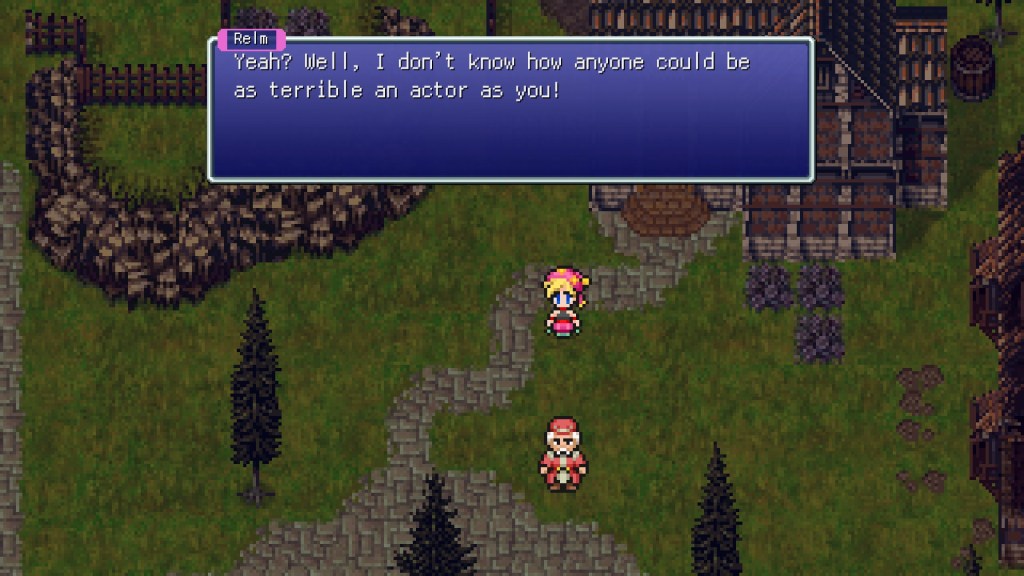
I think it’s a sweet pairing, but I gotta be honest, the dungeon part of this quest is probably my least favorite part of the game.
You are tasked with feeding a bunch of corral to a sentient box. You need to feed it 22 pieces of corral or more in order to move on. If you feed it less, you need to start over and do it again. The game doesn’t tell you this, so the first time through this adventure, you might spend an hour or two here feeding this damn chest before you throw your hands up in the air and look for a solution to it.
On top of this, the dungeon is full of random warps. So there’s no clear path to where you can grab corral, you have to warp around until you find enough and then just keep warping until you get back to the beginning and can feed the chest and move on.
So by the time this was all over, I was just annoyed that Relm did all this for dear ol grampy. Can’t you just get him some Werther’s Originals or something?

Relm Arrowny

Relm is the other half to Strago. Any important scene with Strago will probably either have Relm directly in it or she will be in the background somewhere lurking because she actually isn’t supposed to be there. I feel like Relm is a character that exists just to supplement other people. She has her own unique personality, it’s sassy and kind of rude, but the most interesting things about her are who she is related to.
I don’t care so much about her as an individual, but I like her relationship with her grandfather and I like that her father is Shadow.

She joins up with your party shortly after Strago gets done foreshadowing the whole total destruction of the world thing. You get into a boss fight with recurring joke villain Ultros (more on him later) which is just plain bizarre.
There are a lot of strange attempts at humor here that may or may not land with you, but the point of it is to introduce you to her special ability. Relm has the really cool skill of drawing on a magic canvas to create a duplicate of whatever enemy she is fighting. The duplicate will then do an attack on the original enemy. This is first shown off by having Ultros hit himself with a tentacle.


In the World of Ruin, a rich fella named Owzer has heard how talented Relm is with a brush and enlists her to do a painting for him. Then a demon possesses her painting, but that’s okay because Celes and crew bail her out. Really not much to recruiting her or much new revealed about her here.
She does not get her own story in the World of Ruin but instead shares the above sidequest with Strago. As I said, the two of them are something of a package deal. She manages to be pretty tolerable despite the handicap of being a child character, so I’ll give her a pass for that alone. Plus, I like this bit from the ending. It’s sweet.

To be fully honest, I don’t really get a lot of use out of her sketch ability. I think it’s a really cool technique, but it’s something I basically didn’t even use at all after the Ultros encounter this playthrough. In fact, the first time I used it against Ultros, it missed. I didn’t even know that attack could miss, especially in the ability’s tutorial battle! Bad omen!
And much like Strago, she comes around so late in the World of Balance that I just never really use her much. The story is really moving along at this point, so it’s hard to pull yourself away from it to grind for a while to get her and ol gramps up to magic using parity with the rest of the party.

Ultros
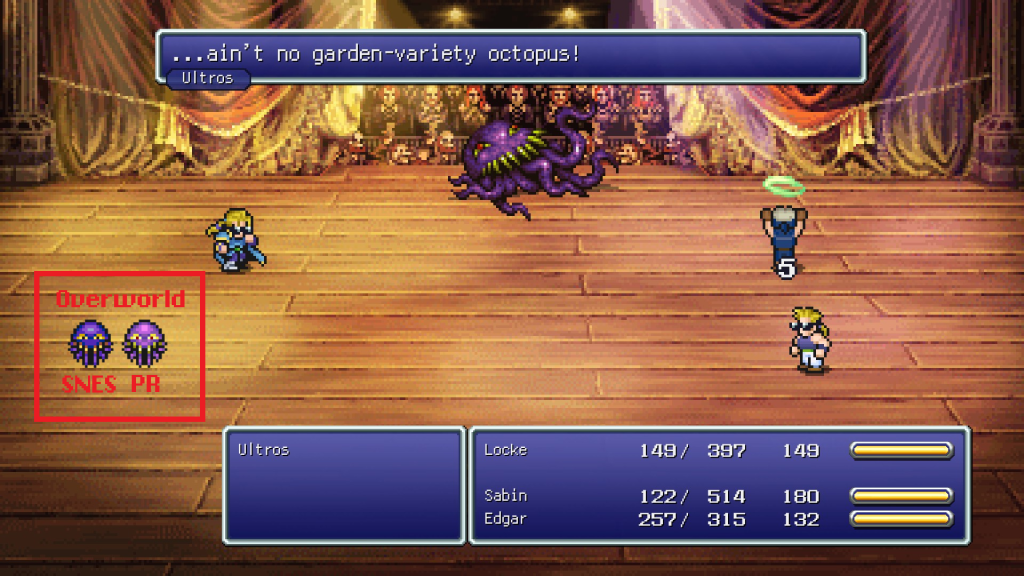
Hey, I told you I’d get back to him! Ultros is a joke villain, sort of a sequel to Gilgamesh from Final Fantasy V. Except he isn’t the lead henchman of the evil organization and instead just seems to be a globe trotting sentient octopus. For a joke character, this is a much more fitting role.
His fights always include a little bit of dialogue. Usually he has something to say about each party member. They are sure to get their tentacle jokes in whenever he attacks Terra, for instance.
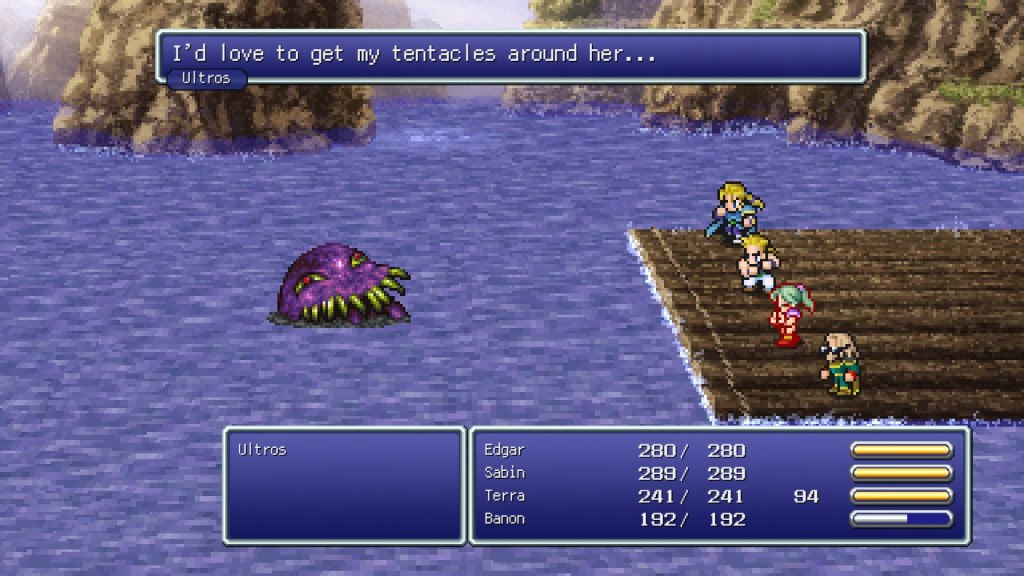
It’s always refreshing to see him pop up because you know you’re in for some levity. Plus, it’s just inherently funny when he pops up for an airship battle. How is he flying? Is he flapping his tentacles? Why is he friends with this Typhon guy? Typhon can’t even talk, so what do they do together?
Back in the day, I used to see people post pictures of Ultros with the worst puns you can imagine attached to them. As a result, I always look back on this doofus fondly. Probably my favorite joke enemy in gaming history.
My favorite bits are him essentially just saying ‘yeah this next section of the game is going to be timed’ during the opera portion of the game and also how he gets stuck as a sort of receptionist in the World of Ruin’s coliseum. He’s not such a bad guy, I hope they pay him well.


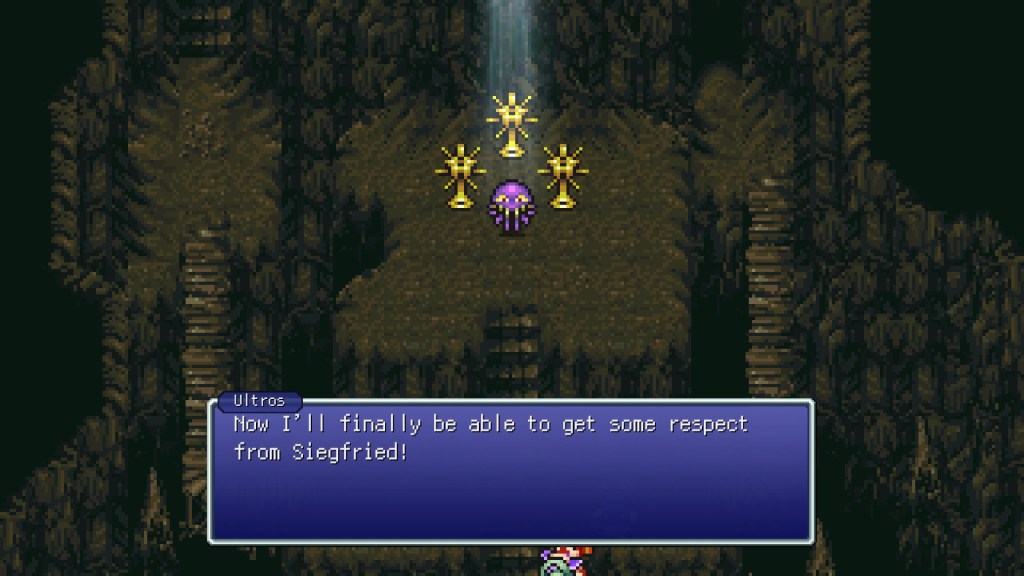
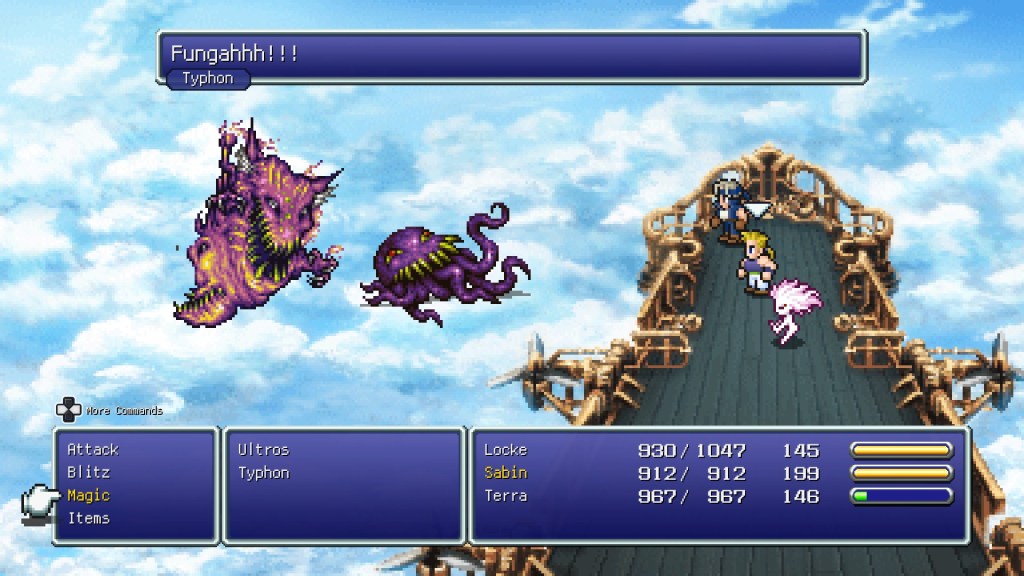

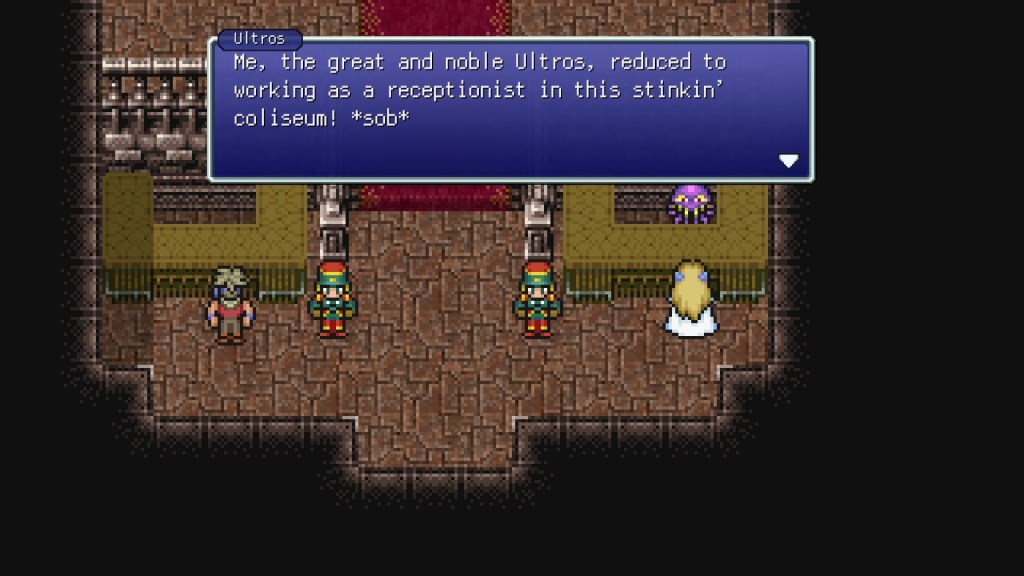
Emperor Gestahl
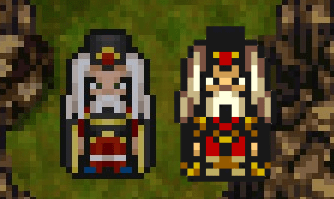
SNES is on the right. Gestahl is a power hungry individual that is never really portrayed as anything else. For the first portion of the game, you would probably think he is the main villain because it seems like everything runs through him. His role in our tale starts right when Terra is born.
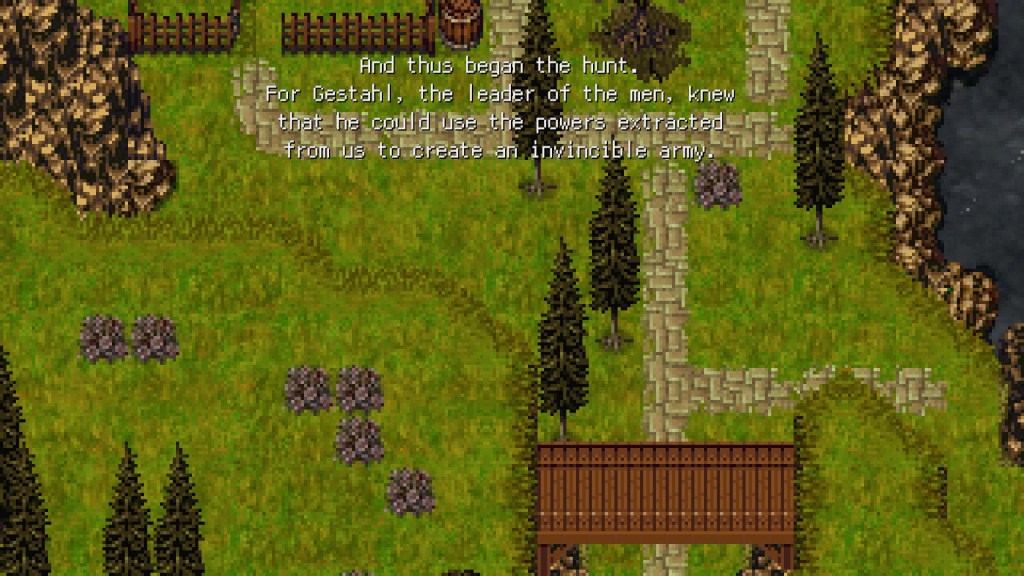
The empire discovered the location of the Esper world, so Gestahl led some forces there in order to take control of the magical beings. Instead, the Espers sealed up their home area while accidentally expelling Terra and her entire family. Gestahl grabs Terra and takes her as his own, which sets up the rest of the game.
Gestahl’s whole deal is that he wants to use the Espers for their magic capabilities. He kills large swaths of them just to obtain more Magicite. After learning of her heritage, Terra leads the party to the sealed up world of the Espers and asks for their help in stopping the empire.

They answer the call and procced to go on a gigantic rampage, attacking the imperial capital of Vector and causing mass destruction. Gestahl, who won’t let a good tragedy go to waste, uses this opportunity to convince the Returners that he has turned over a new leaf and that he wants to make peace with the magical creatures. He says all this bloodshed has made him see the light.
To help convince the Returners of his intentions, he tosses Kefka in jail for the crimes of poisoning the people of Doma. Thankfully your party isn’t totally full of doofuses, so Locke asks some people to stay behind to find out what the empire is truly up to. Good job flirting up a lead, Edgar!
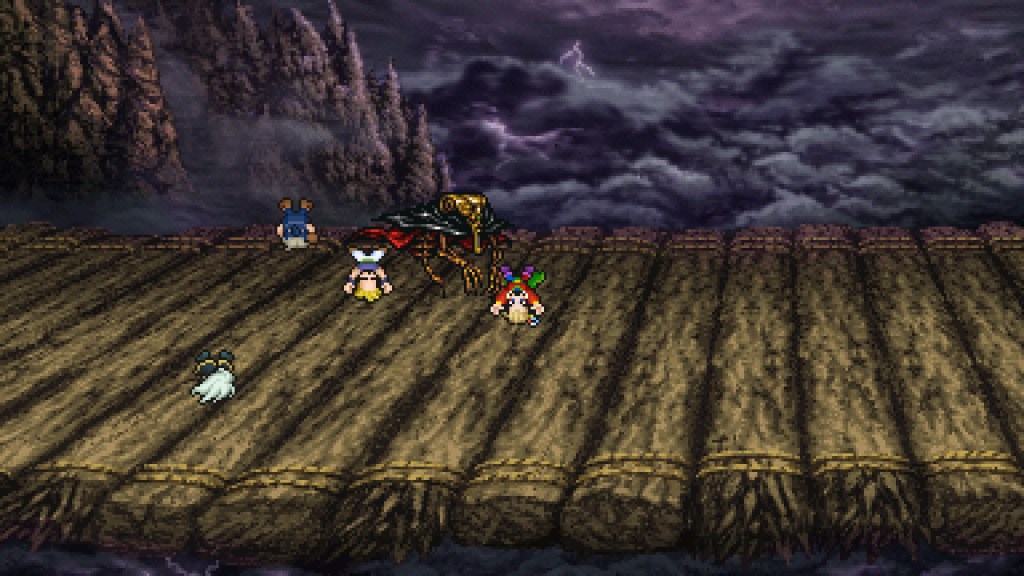
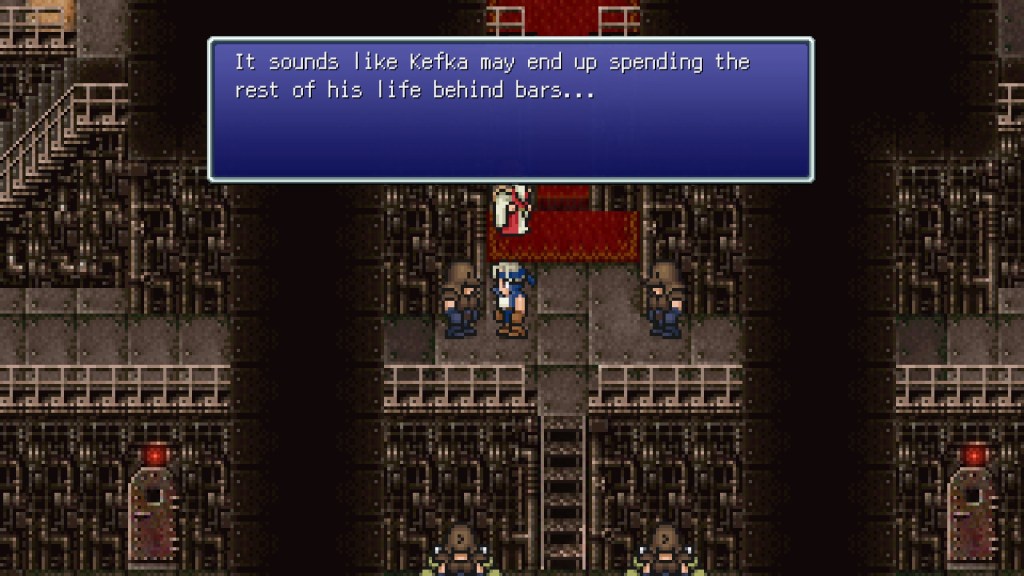


This is, of course, a ruse in order to lure out more Espers and turn them into Magicite. It’s slightly frustrating that your party even plays along with this because it’s pretty obvious he isn’t sincerely trying to turn over a new leaf. Everything you are shown about him in the game points to how he’s a power hungry scumbag. But hey, gotta move things forward.
And forward they go until Kefka eventually turns on Gestahl right when they reach the Warring Triad. The betrayal leads to the destruction of the world and starts the World of Ruin portion of the game.
Gestahl is extremely ruthless and cruel, a very detestable villain. While he is eventually betrayed by Kefka, I never got the impression that he was manipulated into bringing Kefka along. I think they were just two evil guys and the more powerful force of evil won, simple as that. The strangest bit of his character is when he suggests that Kefka and Celes procreate.

She, of course, rejects this and tries to kill Kefka. Doesn’t succeed, but worth an attempt! While we are led to detest this guy, his real purpose is to elevate the true villain of Final Fantasy VI. You don’t get an overwhelming sense of relief that this genocidal asshole has bitten the bullet but instead a sense of dread that a new and more unstable force has taken his place.
Gestahl at least has a plan in place, he wants to create an empire and rule over humanity. It might be evil, but he wants a world to exist in general. Kefka is chaos incarnate and without Gestahl there to reign him in, the true terror begins.
Cid Del Norte Marguez
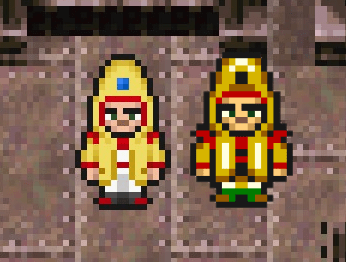
SNES on the right. Cid is the chief scientist of the empire and the guy who is responsible for all the magitek junk you see running around. In case you haven’t noticed, these Cid fellas seem to be good at science.
A lot of his technological prowess has helped propel the empire to the heights it is in at the start of your journey, and much like our boy Oppenheimer, he feels a sense of regret over what he helped usher into the world. This is escalated when he realizes that extracting magic from Espers results in their deaths. Dude, what did you think that genocidal freak Gestahl was doing with those Espers?

His main characterization comes in the World of Ruin. He introduces you to the new world and watches over Celes as she recovers from the apocalypse and when she wakes up, they form a sort of familial bond. She asks to start referring to him as grandfather and the two of them immediately start referring to each other as close family. It’s sweet and helps feed into the excellent introduction of the World of Ruin that I talked about above.
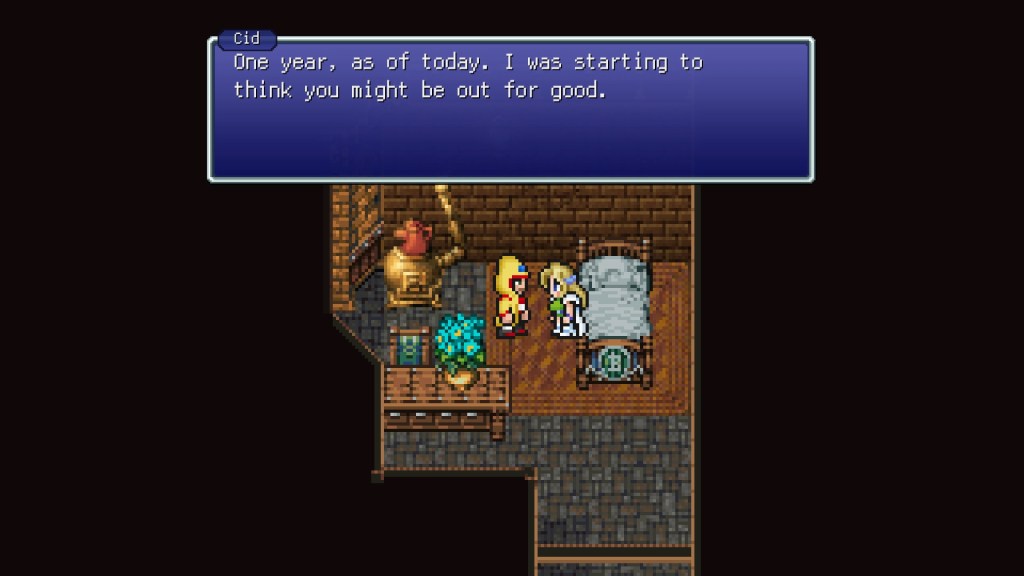

Once you get off the island, that’s pretty much it for ol Cid. I guess they didn’t feel like giving him too much to do since he can die depending on the fish you feed him. Still, I wish there were little scenes where Celes would introduce him to everyone else who made it into this brave new world.
To this point, I would say this is my favorite Cid. He barely edges out FF IV’s wily old man Cid. He will be my favorite for exactly one game because let me tell you right now, I am a Cid Highwind fanboy.
The Warring Triad

I talked about them in Strago’s section, but I feel like it’s appropriate to bring them up one final time. After Kefka moves the three statues to destroy the world, he harnesses the power of the statues to wreck havoc on the survivors. This is usually in the form of energy beams that randomly assaults towns. The power is first introduced when Kefka kills Gestahl as he somehow has the ability to direct their energy however he sees fit.


When the crew raids Kefka’s HQ at the end of the game, they destroy the Warring Triad in three pretty tricky boss battles. But it doesn’t have any impact because Kefka has already absorbed a fair portion of their power to make himself something of a deity.
If you’ve only played the U.S. SNES version you might notice that the Goddess is a little scandalous – they censored that over here. The 90s were a different time! I elected not to include monster sprite differences this time because there really are none. They look the exact same, for real this time. Behold the past!
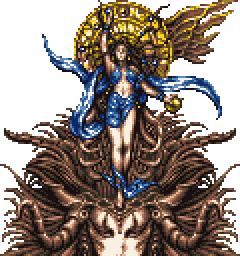
Wholesome.
Kefka Palazzo
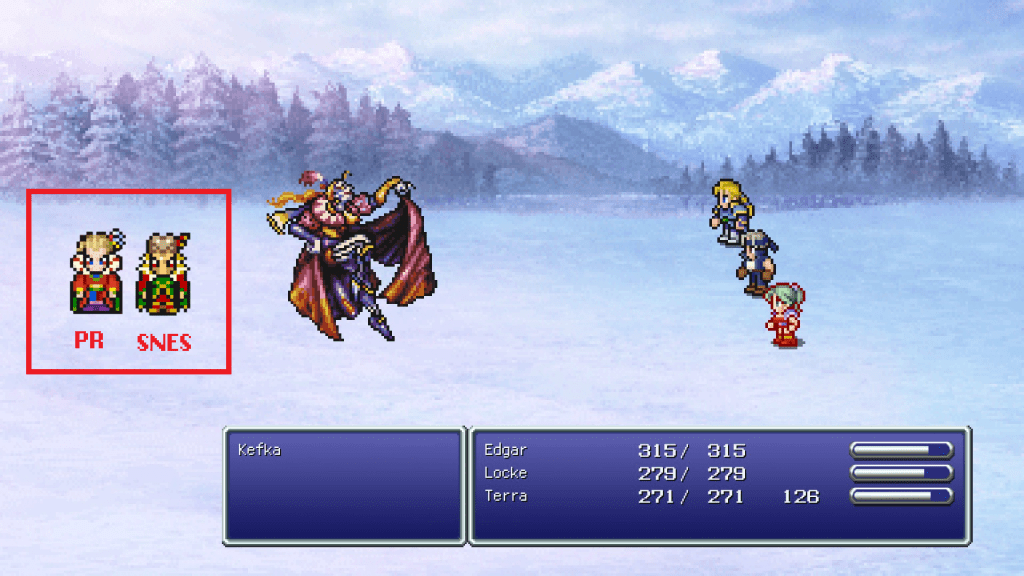
The main antagonist of the game is introduced to us as sort of a goofball, a second-in-command type that isn’t meant to be taken too seriously. Sure, he can get a little murderous – what with the poisoning of Doma and the burning of Figaro castle – but he doesn’t seem to be doing anything he’s not instructed to do.
In fact, whenever you have your first boss battle with him in the World of Balance, he doesn’t seem particularly threatening. If it’s your first time through Final Fantasy VI, you could even be forgiven for thinking his character’s story was over whenever Gestahl locked him away while trying to convince the Returners to join into a truce.

Instead, not so much. Kefka kills Leo, leads Gestahl into the world of the Espers, finds the Warring Triad and using their power creates the floating continent. Let’s talk briefly about that.

The floating continent is the final area in the World of Balance and would very much pass as a final dungeon if you didn’t know any better. Random encounters here are extremely difficult and you even run into intimidating monsters such as Ultima Weapon who feel like they should be end-game encounters.
If you look at the runtime of when you get to the floating continent, it’s about 13-15 hours into the game. If you haven’t played V (North American players, that’s you!), the titles to this point haven’t been much longer than that. It’s believable that a person could think they’re about to take on Gestahl and finish this once and for all.
Making the floating continent feel like this helps the world ending plot twist feel significant. If you don’t already know it’s coming, and let’s be real most people playing FFVI for the first time in 2024 probably are aware of this twist, it makes Kefka’s ascension to godhood and the destruction of the world feel like a real gut punch.
You wouldn’t expect the bad guy’s plan to work and having the player traverse an area that has an air of finality about it helps obscure that result. I think the floating continent is slightly annoying to traverse but it excellently pulls off what it is attempting to do narratively.

From here, Kefka just kind of rules over the world and kills people randomly. That’s it. He doesn’t do anything after this point except torment you from afar as the god of this new world.
Kefka’s motives are very simplistic and cartoonishly evil. He sees that life is meaningless and that people struggling against the inevitable is pointless, they should just embrace eternity and get it over with. He doesn’t want to rule over a legion of subjects like Gestahl does, he wants to rule over a kingdom of corpses.
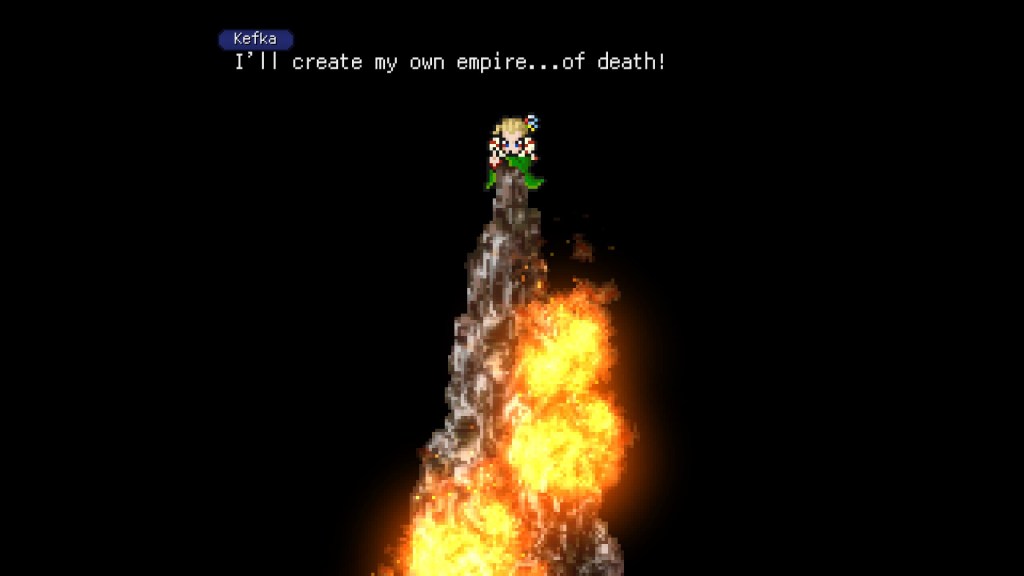
When people call Kefka the best villain in the franchise, I think it has very little to do with his actual motives. I think Golbez from Final Fantasy IV is more fleshed out and interesting, for instance. You also have later antagonists like Seymour Guado, Kuja and Sephiroth who have far more compelling reasons for their pushes for power.
The reason people say Kefka is the best is because he accomplishes his goal – he reigns in terror and destroys the world. He deprives the world of humanity and drives it to ruin. He’s less of an interesting character and more of an interesting plot mover and shaker.
The party confronts him with their reasons for fighting and Kefka doesn’t particularly like this, which leads into the final boss fight.




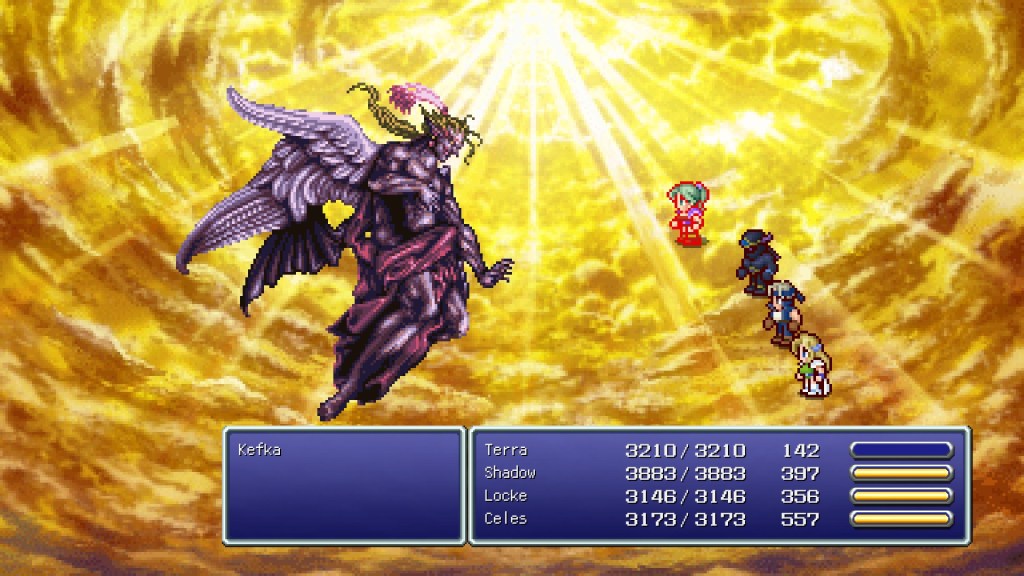
This is, hands down, the most intricate final boss battle of the franchise to this point. It is fought over four phases and can involve using up to 12 characters. You must deal tens of thousands of HP of damage and if you don’t have a fair number of characters able to fend for themselves by this point in the game, you’re probably going to struggle mightily. I would say this is the most intense battle since the Shadow of Darkness from Final Fantasy III and it’s most likely the most difficult yet for newcomers. It really has an air of finality about it.
This go around was pretty easy for me. I have fought this boss several times before, so I knew what to expect. Almost everybody in my top 10 had learned the skills Ultima and Flare, so if they were needed in a pinch they could cause some damage for themselves. Of course, doing this sort of preparation made my main party members very strong so they never had to be switched out during the final encounter.
Oh well! Believe me, there have been times in the past where I have cursed at the screen for dragging out an under-leveled Strago to replace Locke or something. I got lucky this time.
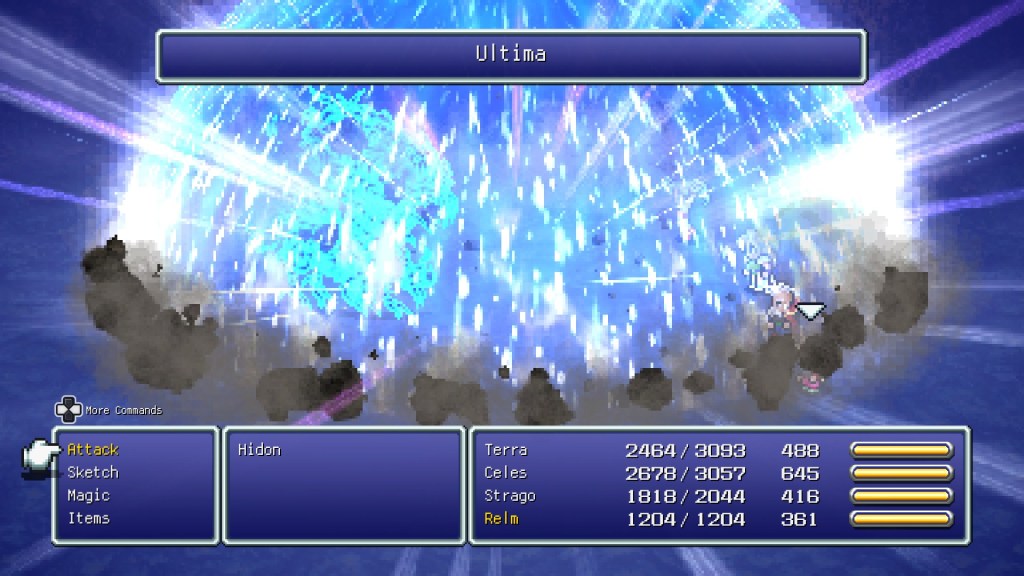
I know this is Hidon and not Kefka…but you needed to behold the power of Ultima!
I think Kefka is a very strong antagonist for the World of Ruin section of the game because it requires an all powerful being just acting like an asshole for no apparent reason. I do not think he would work as the primary antagonist for the entire adventure, so I think it was a good call to place Gestahl as the main face of evil at the start of things. They combine to make a very memorable villainous faction.
It started here
Switchable party members
Talked about in length above, so I’m only mentioning it here for reference. As the franchise moves away from empty character shells that you insert your personality into, a lot of the character customization that comes along with that goes away. So as a result, the more unique aspects of party building comes down to who you decide to carry along. Someone reading this probably actually used Gau a whole lot and is shaking their head in frustration at me!
Hidden characters
Did you think I forgot three party members above? Nah. Had to save them for this. For the first time, you have recruitable characters that don’t just wander into your party because you encounter them in the main story. Instead, you have to go a little bit out of your way to acquire them. Final Fantasy VII also uses this, though I would say those hidden characters are a little more memorable than what came in VI. Yuffie got her own DLC for crying out loud! Well, let’s talk about those guys now.
Mog

You encounter one of these moogles at the very beginning of the game when Locke is trying to save Terra. A whole horde of them join your crew to help you out! The crew introduces you to a later party switching mechanic that is used during various events and dungeons in the game.
These guys all leave though and you can’t recruit a permanent one until far later. A thief steals an item in Narshe and Locke chases him down to an area from the very start of the game where Terra was sent to hunt down Magicite. The thief takes Mog hostage and you can choose to save it or get a golden hairpin. While the hairpin is actually a great item – half off of MP spell cost – you obviously want the moogle in your party.
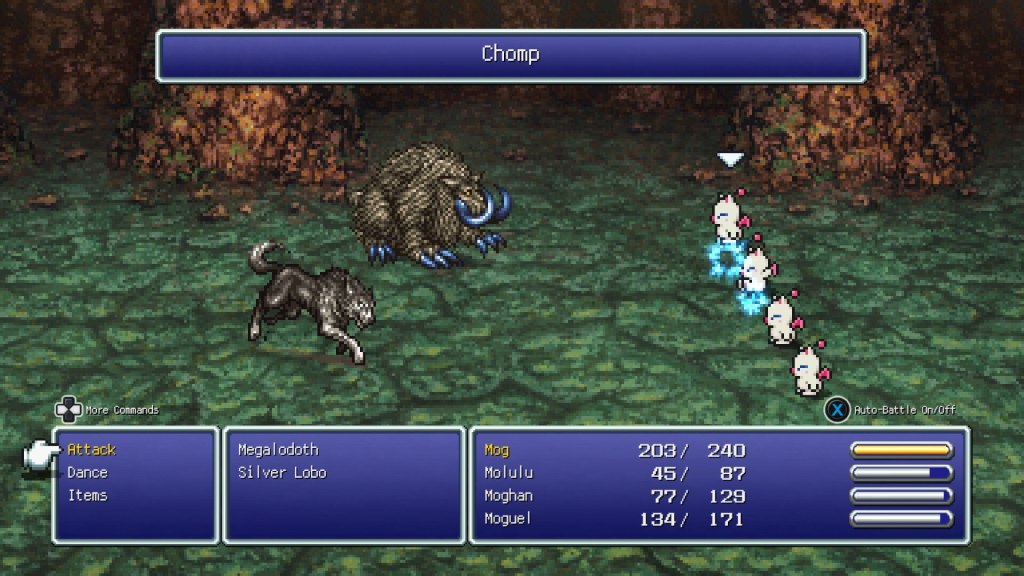
Not much to him really. He’s a cute little guy who hangs out in caves. When you recruit him in the World of Ruin, you can also grab a charm that turns off random encounters. This is exceptionally helpful during the annoying Strago sidequest and also if one of your final dungeon parties is kinda under-leveled. This is the first instance of being able to turn off random encounters as far as I know and believe you me, I have abused this in the past.
In the Pixel Remaster, you can just click a button to turn encounters off whenever you want, so it’s less useful now.
Mog’s unique ability is dancing. He can learn a new dance when he fights in a new biome. Like Gau’s abilities, you can’t really control what he does once he starts dancing, so it’s something I don’t use very often. He can at least equip Magicite and learn magic so if you want to make him a magic user it’s definitely possible. I just gave him Ultima and Flare in a “well if I need him in an emergency he can at least do something” tactic.

Umaro

This cool customer is also in Narshe, but he only joins up with you in the World of Ruin. The player stumbles into his cave and engages in a pretty simple boss fight with him. Afterwards, if you have Mog in your party, he decides to join along with you since the little moogle is apparently his boss or something like that.

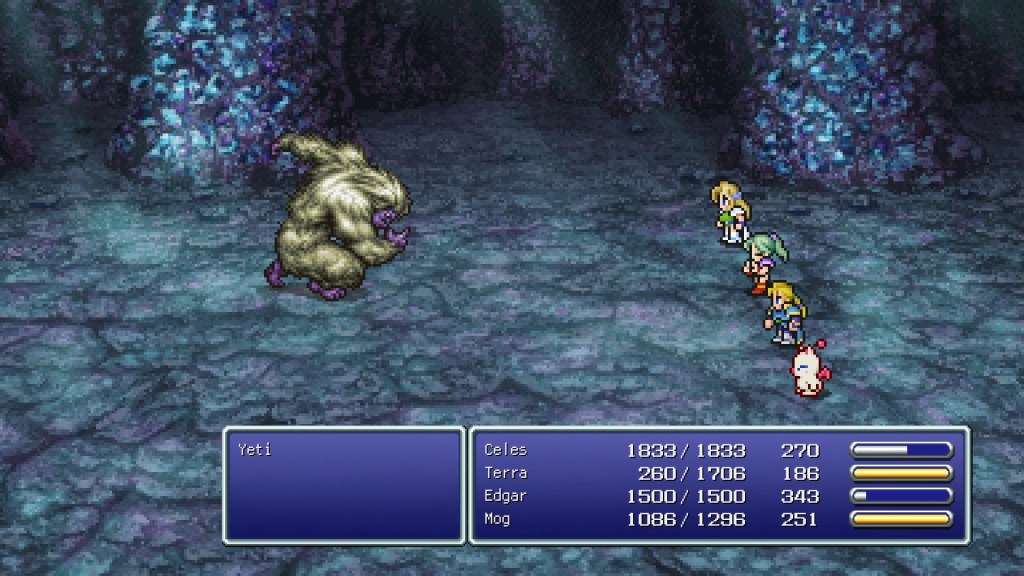
His rudimentary housing would go on to inspire Ronso dwellings in Final Fantasy X. Well, in my head anyway.
In combat, Umaro is a berserker. You can’t equip anything on him besides accessories and you also can’t place Magicite on him. He will just fight and fight and fight until he dies. Absolutely worthless to carry around with you unless you’re doing a challenge run or something like that.
He usually sneaks into my final party as the number 12 option because it’s better to have a guy who can do some damage as opposed to Gau or Gogo who almost always have no magic for me. If I get to a point where I’m relying on Umaro to contribute in a fight, I know I’m probably going to lose.
I think he’s cool though. Look at that smug character portrait! Look how creepy that SNES sprite looks! He may not much have much to him but he’s fine by me.

Gogo

The most hidden party member of all. I legitimately have no idea how people would discover them without a guide or hearing someone talk about it on the schoolyard. And even then, the method to getting them still sounds like one of those fake Pikablu rumors or something like that.
What you need to do is fly to a continent in the northeast of the World of Ruin and encounter an enemy called zone eater. It’s a giant sand worm. The zone eater will inhale your party members. A typical player would panic at this and try to kill it as quickly as possible, but instead you are supposed to allow it to eat your entire party.
Once you do that, you are in Gogo’s world. It’s a mini dungeon that lasts something like three screens. At the end of it is Gogo and he will join your party. After that, you can just teleport out and be on your merry way.
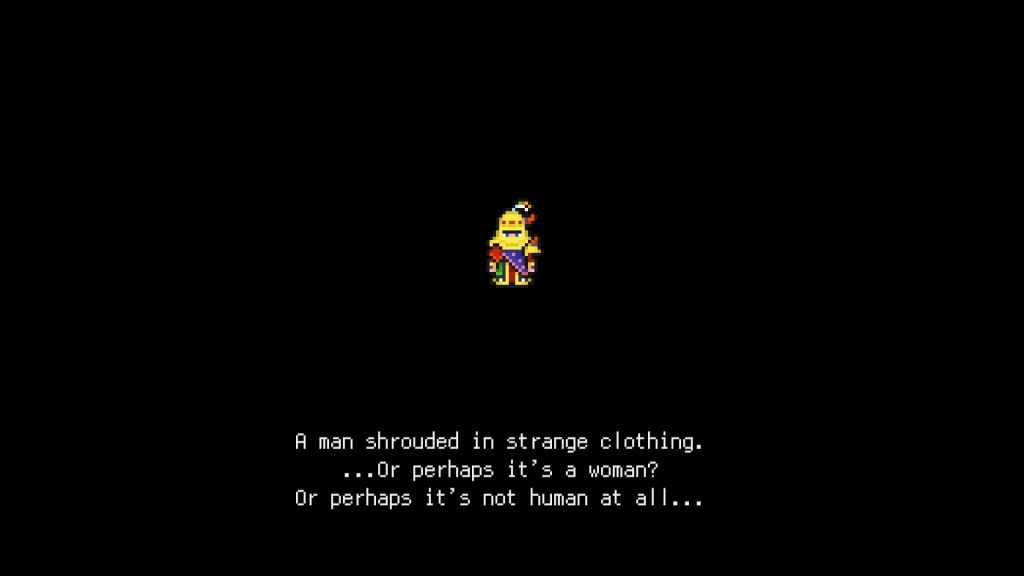
Gogo’s whole gimmick is that they are a mime. Their attack command is replaced by the ability mimic, which copies what the previous action was. They behave similarly to the job from Final Fantasy V in that you can equip three unique abilities from other party members onto them. To compensate for this, Gogo is kind of weak overall. But if you wanted to have two people who can use the ninja throw command, have I got the party member for you!
I never use Gogo. As I have mentioned, I am kind of boring with how I play these games and I don’t want to mess with their gimmick. I prefer just having a cast with spells I taught them myself and not thinking much beyond that. I’m sure Gogo is useful – the mime job is the best one in FFV after all – but I have never bothered with it. Sorry! I like how seriously they take being a mime though, they tell you flat out that they will just copy every single move you do.
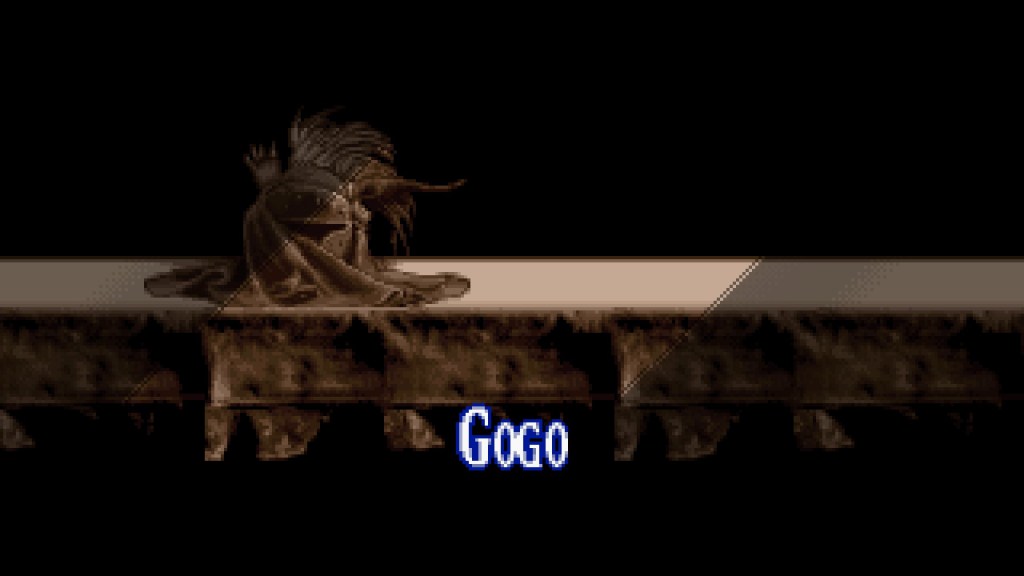
Kinda like that their ending screen resembles the warrior of light’s helmet slightly. Maybe it’s just me.
Limit breaks
Probably one of the biggest staples of the franchise started here under a different name, desperation attacks. When your HP is extremely low, your fight command can be replaced with a high powered unique attack that can cause heavy damage.
The idea of an ultimate attack is extremely cool and adds to the uniqueness of each party member. When you’re watching a shonen anime like Dragon Ball Z, the coolest moments are often brought around by the debut of a big all-powerful attack. Most fans of the series remember Vegeta pulling out the big bang attack for the first time. So putting a similar mechanic into your character based RPG is a really sharp call.
The issue with how this is pulled off in Final Fantasy VI is that there’s no real indication that it’s even possible. I might have missed it, but I never saw a tutorial screen for desperation attacks and if you’re playing for the first time and your HP is low, your first instinct isn’t going to be to try and get a super high powered attack off. You’re going to try to heal!
In this playthrough I did not use a single desperation attack. There was no real need to. The way this is handled in Final Fantasy VII is far superior – I like having a little meter on screen that tells you the technique is on its way. I don’t know why VIII circled back to the VI way of doing it, but at least they tell you about it.
Biggs and Wedge

Biggs and Wedge are recurring character names in the franchise and the first use of them is here in Final Fantasy VI. In the original U.S. translation, Biggs is known as Vicks because Ted Woolsey had 30 days to make that translation all by himself and he has absolutely never even heard of Star Wars. In all future FInal Fantasy titles, Wedge goes by Wedge. Simple!
In this game, they accompany Terra in the opening sequence. They are attempting to claim a frozen Esper up in Narshe – they perish after this and are never heard from again. But their legacy lives on!
Cactuars

The first appearance of this little guy is in Final Fantasy VI. A lot of its familiar traits are already on display here. They are extremely fast and hard to hit, they use the 1000 needles attack which always deals 1000 HP of damage on the dot and they offer a lot of AP (how you learn magic) upon their defeat.
During the end of the game, the best grinding spot for learning new magic is the desert where cactuars are found. Shadow’s shuriken throw will always hit them, so you can learn end game skills like Ultima and Flare extremely quickly.
Ultima Weapon

Ultima Weapon waits for the player on the floating continent and is your hardest challenge before the World of Ruin. This fella, or its name at least, comes back as a semi-super boss in later entries, but here he’s just a normal really hard boss. I also want to talk very briefly about the boss Deathgaze.
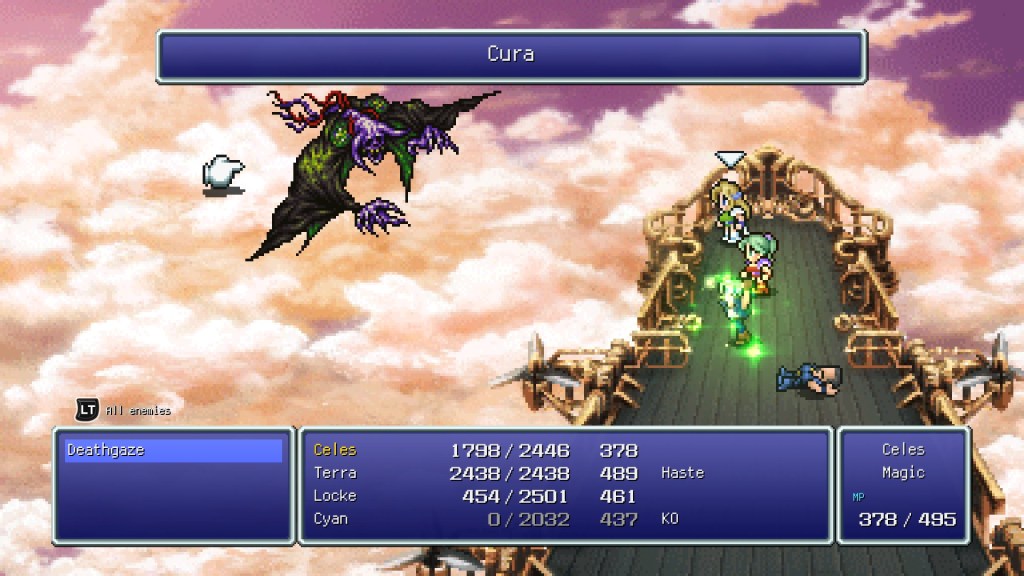
You encounter Deathgaze by flying around the World of Ruin. It is a random encounter in the sky and occupies one space up there The best way to encounter it in the SNES version of Final Fantasy VI is to tilt your ship very slightly to the left or right and slowly canvas the entire map while looking for it. This is tedious, but you will eventually find the creature.
This is changed in the Pixel Remaster. You can spot Deathgaze pretty easily due to a strange distortion on the world map.

The issue is that it will run away after a short amount of time, requiring you to find it again. The HP damage you cause to it remains, but you still need to search it back out. The truncated encounters are the sole reason Deathgaze isn’t considered a super boss. It hits as hard as one though.
The reason I am bringing this up is because Ultima Weapon in Final Fantasy VII uses this exact same practice, except you can actually see it on the world map so it doesn’t require as much precision. VII’s Ultima Weapon acts as a fusion of VI’s Ultima Weapon and Deathgaze.
When you defeat Deathgaze, you gain the Bahamut Magicite, which has traditionally been the best summon in these games to this point. Bahamut teaches you flare, one of the best skills in the game. Beating Ultima Weapon in FFVII gets you the Ultima Weapon sword for Cloud, one of the best weapons in the game.
In conclusion
Final Fantasy VI is a fantastic adventure and gets far more into storytelling and building individual characters than any previous Final Fantasy. It is sort of a bridge between the Nintendo-era titles and the Sony-era titles in this way. It is a satisfying journey with a lot of things to see and do. The gameplay isn’t as deep or as enjoyable as it was in Final Fantasy V, but it is still a top notch role playing game.
If you’ve never played a single Final Fantasy game before the Playstation era, I think VI is a great place to start. It will make the transition into the less story heavy games a little easier to make. At the very least, you should play for yourself in order to see if the hype is real. Everything about it – from the beautiful Nobuo Uematsu soundtrack to the gameplay, is fantastic. There’s a reason this game is considered by many to be the best one in the franchise.
My rating: 5/5

Up Next

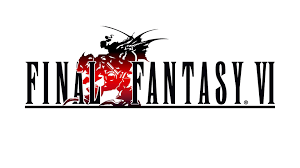
Leave a comment